35th National banksia sustainability awards




AUSTRALIA’S SUSTAINABILITY SUCCESS STORIES
2024
The Banksia Foundation strives to provide accurate and up-to-date information in its publications. However, the Foundation cannot guarantee the accuracy or completeness of content provided by third parties, including winners, finalists, and sponsors. The views and opinions expressed by third parties are their own and do not necessarily reflect the views or opinions of the Banksia Foundation.
Therefore, the Banksia Foundation disclaims any and all responsibility for the correctness of such third-party content. Readers are advised to use their own judgement when evaluating any information presented in this publication.
This
any portion thereof may
be
used in any manner whatsoever without express written permission of the Banksia Foundation except for the use of brief quotations in a book review. Front Cover Designed by Vania Japri Printed by Digital Printing HQ, Melbourne, Australia First printing, 2024. www.banksiafdn.com
Copyright © 2024 Banksia Foundation All rights reserved.
book or
not
reproduced or


Climate Technology Impact Award 29 Fleet Space Technologies ecoSwitch, The George Institute for Global Health O3 Water Pty Ltd Plico SIMPaCT: Smart Irrigation Management for Parks and Cool Towns 31 33 35 37 39
The Reconnect Project Bright Sparqe Cultivated ECORR Pty Ltd Goterra Resource 17 19 21 23 25 27 01 Welcome from the Banksia Foundation Board HW Greenham & Sons Pty Ltd Argyle Foods Group Gina's Table (SSS Strawberries) Oceanfamr Soils for Life 05 07 09 11 13 Agriculture and Regional Development Award 03 Circular Economy Award 15
Contents
71 73 75 77 World Wid Fund for Nature Australia — WWF Australia Australian Conservation Foundation Australian Refrigeration Council Pilco The Social Outfit The Funding Network WWF — Australia 43 45 47 51 53 55 57 59 OPENAIR: The Operational Network of Air Quality Impact Resources ACT Government Vulnerable Household Energy Support Scheme Farm My School My Smart Garden SIMPaCT: Smart Irrigation Management for Parks and Cool Towns 49 Teachers Mutual Bank Limited Endeavour Energy Officeworks 63 65 67 41 Diversity, Equity and Inclusion Award 61 Large Business Transformation Award Marketing and Communication For Impact Award 69 Healthy Planet, Healthy People Award


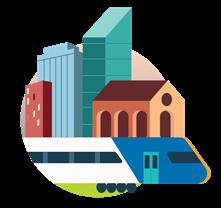

Bared Footwear Underwear for Humanity 115 117 Parramatta Light Rail Stage 1 My Home Australasia Limited ("My Home") Public Transport Projects Alliance Ovingham 107 109 111 Placemaking Award 105 ACT Emergency Services Agency Blue Leaf Water Cremation Cerclos Monash Sustainable Development Institute Orica Limited Telstra InfraCo 93 95 97 99 101 103 Vic Catchments Learning on Country Program The Mulloon Institute The Wheen Bee Foundation Upper Murrumbidgee Demonstration Reach 81 83 85 87 89 91 Net Zero Award Nature Positive Award 79 113 Responsible Supply Award

Intrepid Travel Fun Over 50 Holidays Take 3 for the Sea's Ground Swell Litter Prevention Program Wild Adventures Melbourne 139 141 143 145 Hysata Blue Eco Homes Busselton Jetty thinkstep-anz WaterGroup 121 123 125 127 129 Underwear for Humanity TWOOBS 133 135 137 Sustainable Tourism Award 119 Small and Medium Enterprise Transformation Award 131 Sustainable Leadership in the eCommerce Industry Award

” from the Banksia Foundation Board Welcome
The initiatives showcased by these awards undoubtedly represent significant milestones in creating a sustainable future for Australia. The winners have demonstrated remarkable ingenuity in developing solutions that harmonise environmental preservation, economic growth, and social responsibility. Their achievements epitomise the potential for businesses and communities to thrive while respecting the delicate balance of our natural world.
”
Australia's spirit of innovation shines brightly even amidst challenging times. We are delighted to present the case studies from our inspiring winners and finalists for the 35th National Banksia Sustainability Awards, showcasing the dedication and creativity of individuals and organisations driving positive change.
As we are continually faced with new challenges, these case studies unveil remarkable resilience and empathy. The qualities provided is evidence of a bedrock of our collective response across all levels of Australian society. It is with immense pride that we see these values reflected in the unwavering commitment to sustainability demonstrated by our award winners and finalists.
The National Banksia Sustainability Awards, now in our 35th year, remain a beacon of recognition, attracting inspiring entries across all 14 categories. Their achievements highlight the critical role of sustainability, not merely a nice to have, but as a powerful driver of positive change. We extend our deepest gratitude to our category sponsors, foundation partners, and supporters, whose unwavering commitment drives our crucial work. Their dedication allows us to amplify the voices of these sustainability champions and inspire others to join the journey.
The Banksia Foundation Board offers our congratulations to all the winners and finalists. We invite you to delve into their stories and discover how these innovative Australians are contributing to achieving the UN Sustainable Development Goals. Let their journeys inspire us all to build a more sustainable future, together.
Grazyna van Egmond Chief Executive Officer Banksia Foundation
01
Board Members





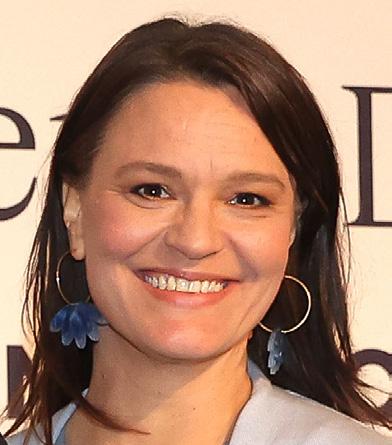




Meet Our Patron
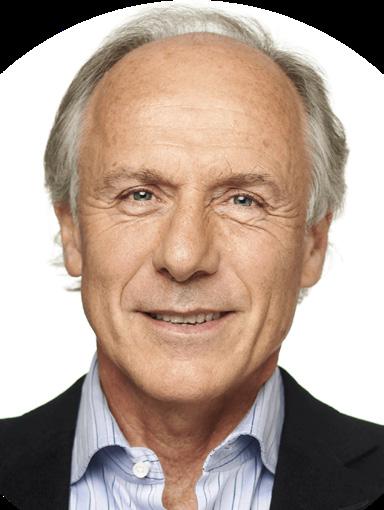
Alan Finkel is a neuroscientist, engineer and entrepreneur. He was Australia’s chief scientist from 2016 to 2020, during which time he led the National Electricity Market Review, the development of the National Hydrogen Strategy, and the panel that advised the Australian Government on the 2020 Low Emissions Technology Roadmap. He is currently Chair of Stile Education, Chair of the Australian Government’s Technology Investment Advisory Council, and Special Adviser to the Australian Government on Low Emissions Technologies.
Rick Finlay Treasurer
Grazyna van Egmond CEO
02
Alan Finkel
Jo Cain Peter Olsen Mark Paterson
Estelle O’Callaghan Chair
Julie Boulton
Dr Rocio Bona
John Valastro
03 Agriculture and Regional Development Award
HW Greenham & Sons Pty Ltd
Greenham’s Beef Sustainability Standard makes it easier for farmers to demonstrate their sustainability credentials

Victorian-based beef processor, Greenham, has responded to the escalating demand for sustainable beef by launching an on-farm program that helps farmers to demonstrate their environmental credentials with ease and identify opportunities for improvement, while growing consumer confidence through a Certified Regenerative on-pack claim.
Website: greenham.com.au
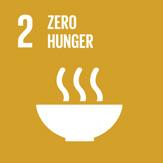
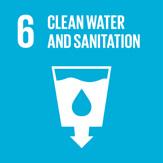



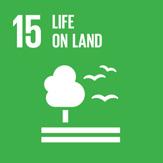
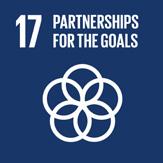
5 AGRICULTURE AND REGIONAL DEVELOPMENT AWARD
WINNER 2024
Pinion Advisory, Meat & Livestock Australia, McDonald’s, EnviroDynamics
The development of Greenham’s new Beef Sustainability Standard (GBSS) involved close collaboration with producers and customers, marking the first commercial supply chain to apply the Australian Beef Sustainability Framework’s (ABSF) principles of animal welfare, environmental stewardship, economic resilience, and people and community into a set of market-ready standards.
Greenham Supply Chain Manager, Jess Loughland said robust and transparent sustainability credentials would be the key to unlocking market access in the very near future.
“Consumer needs are always evolving, and we need to evolve along with them,” she said.
“Our goals were two-fold: to deliver consistent premium-quality beef raised in a manner that aligns with our customers’ values, and to drive adoption of best practice management to protect the land and strengthen the communities in which we operate for future generations."
“It was also important to us that our program reflected broader industry priorities and provided producers with a clear path to contribute to industry goals like CN30.
“Through conversations with our cattle producers it became clear that there was a big appetite to take steps in this direction, but many were unclear on where to start.
“By outlining specific indicators and measures tied to the ABSF and informed by our producers, we found that we were able to give structure to people’s ideas about sustainability and incentivise taking action today.”
The GBSS, endorsed by Integrity Ag & Environment, operates in three tiers, designed as a developmental journey for producers rather than an immediate pursuit of perfection. Tier one emphasises education and planning, setting a baseline for sustainable management, while tiers two and three focus on continuous improvement towards optimum ecological health, carbon neutrality and best practice financial,

people, and safety management. With endorsement from Certified Humane®, beef produced from accredited Tier two properties is eligible for an on-pack Certified Regenerative label, enhancing consumer confidence in Greenham’s premium beef brands like Cape Grim and Bass Strait Beef.
Grounded in the realities of southern Australian beef production, the GBSS was formulated through collaboration with Tasmanian cattle producers. A pilot in 2022, supported by Meat & Livestock Australia (MLA), involved 21 cattle producers from varied production systems. This trial assessed the standard's practicality, efficacy, and on-farm value. Producers underwent audits, received training, and were given time to implement the standard.
The pilot revealed several key findings, such as the importance of accessible training and tools to support producers in measuring and recording activities. Moreover, most respondents found the standard practical and cost-effective, aligning with their existing activities. Many recognised benefits like improved farm productivity, market access, actionable steps towards industry goals, enhancing farm resilience and consumer connections.
Production of GBSS-accredited cattle from pilot farms commenced in Tasmania in March 2023. Following the official launch of the program at Wangaratta Turf Club in November 2023, the standard is gradually being rolled out with Greenham's 4,000+ NEVER EVER Beef Program accredited suppliers, providing producers with another premium market option.
"Our goals were two-fold: to deliver consistent premium-quality beef raised in a manner that aligns with our customers' values, and to drive adoption of best practice management to protect the land and strengthen the communities in which we operate for future generations"
6
2024 NATIONAL SUSTAINABILITY SUCCESS STORIES
Argyle Foods Group
Argyle Foods Group, driving sustainable cattle, beef and land management.
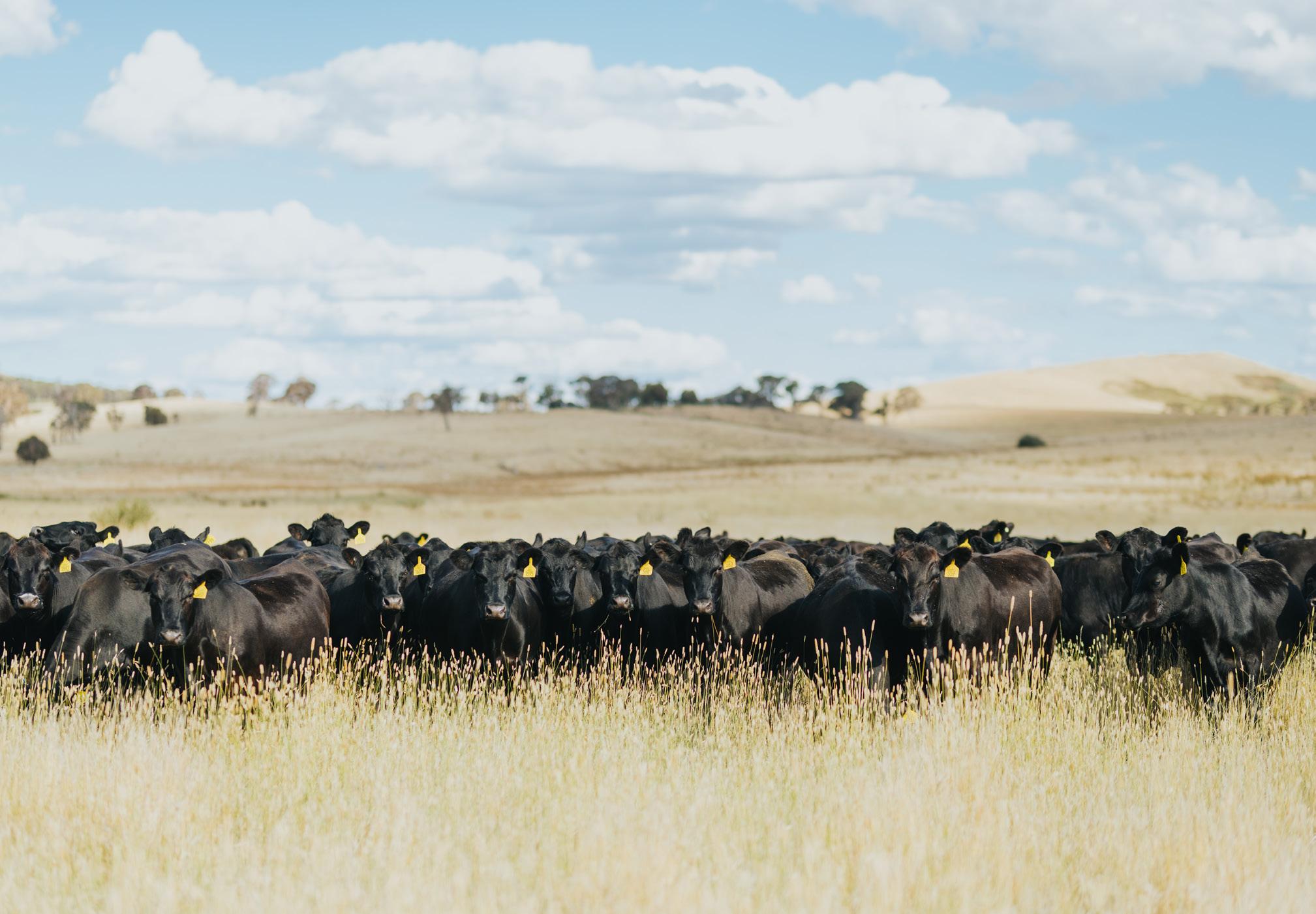
Argyle Foods Group is an Australian farmer-owned agricultural company with a vertically integrated supply chain. The business is based on the foundations brothers Lachie and Bryce Graham learnt growing on the family property in Harden, NSW. The Graham Family have always been at the forefront of best practice and innovation in farming practices, with Lachlan and Andrina Graham being awarded the NSW Farmer’s of the Year Award in 2013.
Website: argylefoodsgroup.com.au
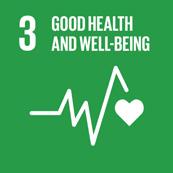



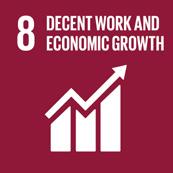










7 AGRICULTURE AND REGIONAL DEVELOPMENT AWARD
Hillview Park Trust, Candal Meats, Tucker Environmental

During 2017 to early 2020 much of eastern Australia was experiencing one of the worst drought in history. At the time, AFG held the lease holding of the Graham Family Farm “Argyle”, located on the south-west slopes of New South Wales. The hardship experienced of managing this property, which was primarily a mixed farming operation with large areas of land dedicated to cropping, was not only physically depleting, but also mentally for our employees. Livestock were required to be fed daily and the conditions of the continual dust exposure caused a rethink of our long-term business strategy to mitigate further climate risks in an intensifying changing climate.
Following the break of the drought in early 2020, Lachlan and Bryce Graham set out to transform Argyle Meats and Argyle Pastoral into a consolidated sustainable land, livestock and beef business with the goal of achieving a genuine environmental impact and become a leader for the industry in regenerative agricultural land management. Ever since, sustainability has been a key driver for operations and business decisions have become increasingly directed by the health of the cattle, land, and greater ecosystem. The business is now proud to be led by sustainability goals that have been developed by industry gold-standards. Argyle
implements regenerative practices across its pastoral operations and undertakes research and development through their in-house Argyle Carbon team which focuses on carbon sequestration, emissions reduction, and soil health. Research and innovation is undertaken in partnership with Meat & Livestock Australia, the University of Tasmania and the Net Zero Agriculture CRC.
In January of 2023, shareholders in Argyle Foods Group, including the two CEOs, Lachie and Bryce, invested their own capital to purchase the Hillview Park property in Goulburn. Through the partnership with Hillview Park Holdings, the property was purchased based on key sustainability objectives aimed to better ongoing land and animal wellbeing. In addition to cattle, the purchase of the property was made to support the development of various sustainability projects including supporting the development of Crookwell 3 wind farm through a lease-hold arrangement with the developers, registering and developing three biodiversity stewardship sites in partnership with Tucker Environmental, and registering a soil sequestration project via the Clean Energy Regulator. To connect the sustainability on-farm with consumers, Argyle develops bespoke brands for its beef and have recently partnered with Sure Good Foods (SGF) to expand their sustainable
beef offerings into North America. Additionally, Argyle has recently launched a sustainable grass-fed beef brand exclusive to Coles, available in NSW and ACT.
Hillview Park property was purchased based on key sustainability objectives aimed to better ongoing land and animal wellbeing

8 2024 NATIONAL SUSTAINABILITY SUCCESS STORIES
Gina’s Table (SSS Strawberries)
Queensland family-run business SSS Strawberries is at the forefront of sustainable agriculture and the fight against food waste as they launch Australia’s largest, most technologically advanced freeze-drying facility that converts supermarketrejected fruit into nutritious snacks under the Gina’s Table brand.

In the heart of Queensland, SSS Strawberries is a familyrun business reimagining food waste. As Australia's second-largest strawberry grower, they are on a mission to transform unwanted strawberries into delicious, freezedried treats that pack a punch for both nutrition and the environment.
Gina’s Table (SSS Strawberries) pioneers
Australia’s largest freeze-drying facility to combat food waste
Website: ginastable.com/










9 AGRICULTURE AND REGIONAL DEVELOPMENT AWARD
In Australia alone, we create 7.6bn tonnes of food waste every year at an estimated economic cost of $36.6bn. And the amount of land needed to grow this wasted food? Over 25 million hectares! SSS Strawberries' quest to curb food waste began in 2017 when Managing Director Gina Dang sought to address the dumping of supermarket-rejected fruits due to aesthetic standards.
SSS Strawberries' initial investigations into the pureed fruit market revealed stiff competition from low-priced imports, leading them to explore alternatives like frozen and freezedried fruit. Their research unveiled a gap in the Australian market, where a billion-dollar demand for freeze-dried foods was met primarily through imports, with almost no commercial-scale local freeze-drying capacity. Which meant no existing infrastructure could handle SSS Strawberries' surplus at scale.
It was clear: if SSS Strawberries wanted to pursue their sustainable agriculture goals and make a significant dent in food waste, constructing their own freeze-drying facility was imperative.
SSS Strawberries set out with a dual mission: to slash the food waste endemic in the industry and convert their surplus strawberries into a profitable product line. They envisioned a sustainable system where technological innovation could unlock new, preservative-free food products from local resources, offering fresh-tasting, nutrient-rich, and easily transportable food options.
Six years of innovation and strategic planning have placed SSS Strawberries at the forefront of sustainable food processing. The answer to how we can transform food waste into opportunity lies in SSS Strawberries' state-of-the-art freezedrying facility, branded Gina’s Table set to be the largest in Australia with the capacity to freeze dry 2000 tonnes of produce within hours.

The facility's development was a collaborative triumph. Gina’s Table sought the expertise of global leaders in freeze-drying technology, incorporating advanced machinery capable of handling large volumes of fruit with efficiency and reliability. Designed with scalability in mind, it ensures Gina’s Table can extend services to other primary producers.
Even before its doors opened, the initiative made significant strides, garnering interest from international markets and successfully launching a line of freeze-dried fruit into Woolworths, health food stores and amazon under the Gina’s Table brand. Proving the viability and market appeal of their products.
With the imminent launch of it’s facility, SSS Strawberries is poised to cement its position as a leader in sustainable agriculture. Their story is one of transformation: of unwanted fruit, of industry practices, and of our approach to food waste.
SSS Strawberries isn't just about avoiding waste. It is about embracing a circular economy that benefits everyone—from local farmers to global consumers. By using advanced freeze-drying technology, SSS Strawberries turns surplus fruit into a line of products that are as tasty as they are sustainable, hitting the sweet spot of profit and planet-friendly practice.
SSS Strawberries tackles $36.6bn annual food waste problem in Australia

10 NATIONAL SUSTAINABILITY SUCCESS STORIES
2024
Oceanfarmr
Oceanfarmr, Growing farms that change the world

Oyster farming has long faced a significant challenge –the inability to obtain finance for expanding underwater infrastructure. Oceanfarmr's innovative solution is both simple and transformative. They act as asset managers, purchasing both the infrastructure and the crop to be cultivated within it. The farmer, with their expertise and resources, nurtures the crop on their water. At the end of the agreed growth cycle, the crop is sold, and the proceeds cover the cost of the crop, infrastructure, finance, management, and insurance. Most importantly, the infrastructure is transferred to the farmer, allowing them to use it for their future endeavours.
In the world of sustainable aquaculture, one organisation stands out for its ground-breaking approach to fostering environmental and social benefits while revolutionising the lives of oyster farmers. Oceanfarmr, driven by a profound belief in creating thriving farms, communities, and ecosystems, has emerged as a beacon of innovation in the industry.
Website: oceanfarmr.com/











11 AGRICULTURE AND REGIONAL DEVELOPMENT AWARD
Integral to Oceanfarmr's approach is the Oceanfarmr app. This digital tool empowers farmers to manage their farms with precision, optimise work practices, and streamline compliance reporting. The results are astonishing, with farmers experiencing a 17% boost in productivity, a 50% reduction in on-water time, and an impressive 20% annual farm growth rate.
Oceanfarmr's vision extends far beyond the financial realm. For every hectare of water developed for oyster aquaculture, the benefits are substantial. Fish abundance increases by 1.6 times, the local economy enjoys an economic multiplier of 2.07 times, and crucially, water is filtered while nitrogen and carbon are captured. The estimated environmental and social impact of non-feed infrastructure is an astounding $392,000 per hectare per annum.
Oceanfarmr has set ambitious but attainable goals. Their target market comprises 25,000 shellfish farms globally, with an infrastructure requirement of $9.5 billion pa, translating into a staggering $333 billion of annual environmental and social benefit. While reaching this entire addressable market may be a long-term vision, their shorterterm objectives are just as impactful. Oceanfarmr aims to work with 90 shellfish farms, facilitating $85 million of infrastructure and generating $1.2 billion of environmental and social benefit, with a significant portion of this impact in New South Wales.
Through each hectare of nonfeed aquaculture they establish, Oceanfarmr increases marine biodiversity, enhances microbial nutrient cycling, filters water, and captures nitrogen and carbon.
Oceanfarmr's journey began in 2017 with a simple dashboard and app. Since then, they have evolved into a global force, managing 139 million oysters across 85 customers worldwide, building productivity and resilience. They have engaged with five infrastructure customers in
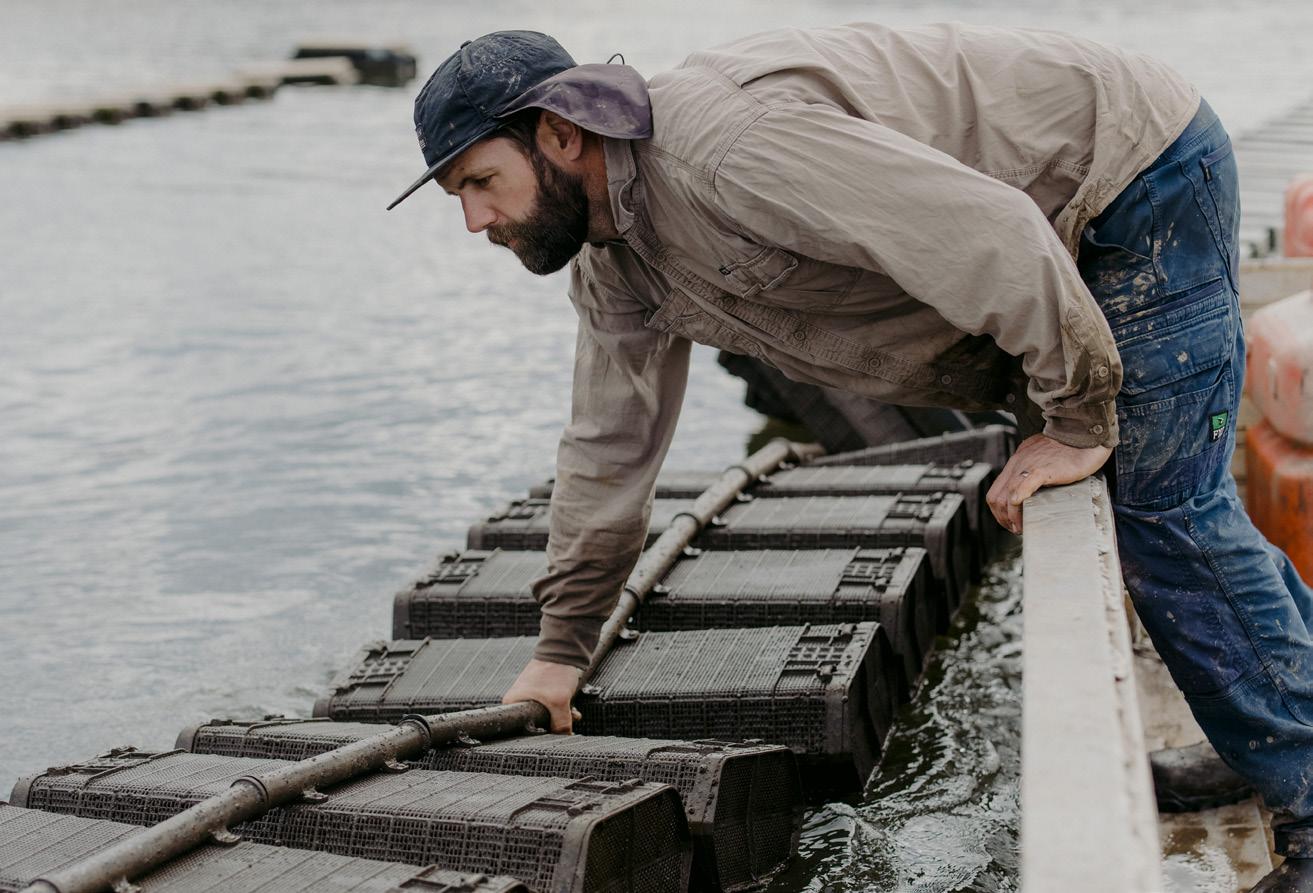
Australia, facilitating 13 transactions that have cultivated 2.67 million oysters across 7.6 hectares of previously unused water lease.
Oceanfarmr emphasises meaningful collaboration and respect as central pillars of their work. Through bimonthly newsletters, training, and building relationships beyond the workplace, Oceanfarmr is unlocking growth and infrastructure for ocean farmers, enabling them to release their economic, social, and environmental potential.
In conclusion, Oceanfarmr's groundbreaking approach to sustainable aquaculture not only addresses the financial challenges faced by oyster farmers but also creates lasting environmental and social impact. With a vision firmly rooted in the well-being of communities and ecosystems, Oceanfarmr is a trailblazer in the industry, transforming the way we view and engage with aquaculture for a better, more sustainable future.

Oceanfarmr aims to work with 90 farms, generating $1.2 billion of environmental and social benefit
12 NATIONAL SUSTAINABILITY SUCCESS STORIES
2024
Soils for Life
Growing regenerative agriculture through stories of soil stewardship.

The case studies have shown that agriculture can do better than simply reducing its environmental impact. These farmers are using farming to actually improve the environment, restoring water systems (SDGs 6 & 14), moving away from harmful agricultural chemicals (SDG 12), reintroducing plant diversity and creating habitat for biodiversity (SDG 15), reducing emissions and building resilience to extreme weather (SDG 13), and growing healthy food (SDG 2). What’s more, this approach leaves farming families happier and more financially stable, with lower costs and improved resilience (SDGs 3 & 8).
People are at the heart of Soils for Life’s regenerative farming case studies. These stories of change have inspired a generation of farmers to become better land stewards, and given them the information and support they need. And they have built mainstream awareness - in government, research, industry and the general public - of regenerative agriculture as a solution to some of the world’s biggest sustainable development challenges.
Website: soilsforlife.org.au









13 AGRICULTURE AND REGIONAL DEVELOPMENT AWARD
A program of case studies might at first glance be dismissed as a bunch of nice little stories. But these case studies are much more than stories. They are in-depth, holistic, and deeply personal stories that touch and inspire, but also inform decision making.
Soils for Life has constantly sought new and engaging ways to connect with audiences, including interactive web pages, articles exploring themes emerging from the case studies, beautiful photos and videos from the farms, podcasts, social media, farm field days, webinars, farmer discussion groups, conference presentations, submissions to government and more. In 2023, Soils for Life hosted a macro-photographer to tour six case study farms and photograph the tiny creatures living in the soil. The results were spectacular, and reveal the beautiful, complex, hidden underground ecosystem that is the foundation of life on earth.
With over 200,000 views and nearly 90% of landholders taking steps to change practices after engaging with case study materials, Soils for Life’s Case Study Program demonstrates that refocusing on and supporting people can lead to large-scale sustainable outcomes.
Regenerative agriculture is now at a turning point. More farmers are becoming curious about how they could become better soil stewards, and so Soils for Life has begun to shift direction to support this next cohort to adopt regenerative practices. It is expanding its program to cover a greater diversity of themes, enterprise types and geographies to support a broader audience of farmers. At the same time, it has commenced two new streams of work focused on supporting communities of farmer soil stewards and building farmers’ soil and ecological literacywhich complement the case studies.

The Soils for Life Case Study Program brings together solid scientific foundations, with creative communications and an unwavering commitment to put people at the centre. It is this combination that has enabled the program to support so many farmers, and to help regenerative agriculture become a powerful force for sustainable development.
These stories of change have inspired a generation of farmers

14 NATIONAL SUSTAINABILITY SUCCESS STORIES
2024
Circular Economy Award
15

The Reconnect Project
The Reconnect Project is closing Australia’s digital divide and training a new generation of repairers.

National mobile device recycling scheme MobileMuster reported that there were 23 million unused mobile phones sitting in drawers, cupboards and garages. When faced with end-of-use decisions for mobile phones, consumers could choose between handing the phone to family or friends, sending to MobileMuster for destruction and materials recovery, or use a trade-in or buy-back service to regain some of the device’s value.
The Reconnect Project was born from a vision of stopping mobile devices from being downcycled prematurely as e-waste.
Website: thereconnectproject.com.au

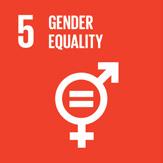

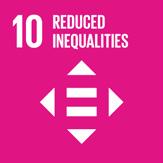

17
CIRCULAR ECONOMY AWARD
WINNER 2024
Consumers were increasingly reliant on their devices for internet or appbased activities. The higher initial purchase cost for a mobile phone was leading to longer device ownership, with consumers turning over their phones every 40 months (up from average of 30 months in 2017). As a result, the independent mobile device repair industry was rapidly growing as consumers sought costeffective services to maintain their personal devices. For individuals wanting to work in or establish their own small business providing mobile device repairs, there was nowhere to gain hands-on skills or be trained under a formally recognised training program.
The Reconnect Project put these two concepts together: giving people an alternative to e-waste for their mobile devices and providing training and skills to individuals in mobile device repair. The output would be refurbished devices distributed to people in disadvantaged situations.
Launched in September 2019 at a Pitch for Good event supported by StartSomeGood and the City of Parramatta, The Reconnect Project began as a crowdfunding campaign with the tagline “Giving old phones and devices a new life” and raised $5,425. In February 2020, The Reconnect Project commenced operation in a small, shared space, with the aim to provide retail repair services for generating revenue required to purchase spare parts for repairing donated mobile phones. Their first customer was none other than Costa Georgiadis. Then Covid-19 hit Australia and the shared workspace closed. Word spread amongst the social service network of Sydney’s south and by May, The Reconnect Project had received requests for 400 mobile devices so that Caseworkers could maintain contact with their most vulnerable clients during lockdown. Throughout 2020, The Reconnect Project survived with grant funding

from City of Sydney and City of Parramatta. In December 2020, The Reconnect Project took out a lease on a small retail shopfront in Penshurst. Australia’s first charity-run mobile device retail repair shop opened to the public in February 2021.
Thanks to The Reconnect Project 2,277 individuals now have the technology to maintain contact with family, engage in online education, connect with friends and undertake essential activities such as online banking and video call health appointments. The Reconnect Project now employs 8 permanent staff and is developing Australia’s first accredited mobile device repair training program, specially designed for neurodivergent young adults who seek a career in repairs.
An alternative to e-waste by refurbishing phones for disadvantaged communities
18 NATIONAL SUSTAINABILITY SUCCESS STORIES
2024
Bright Sparqe
The Bright Sparqe Platform connects Bright Sparqe partner businesses and organisations to partner charities “The Uber of Donations”
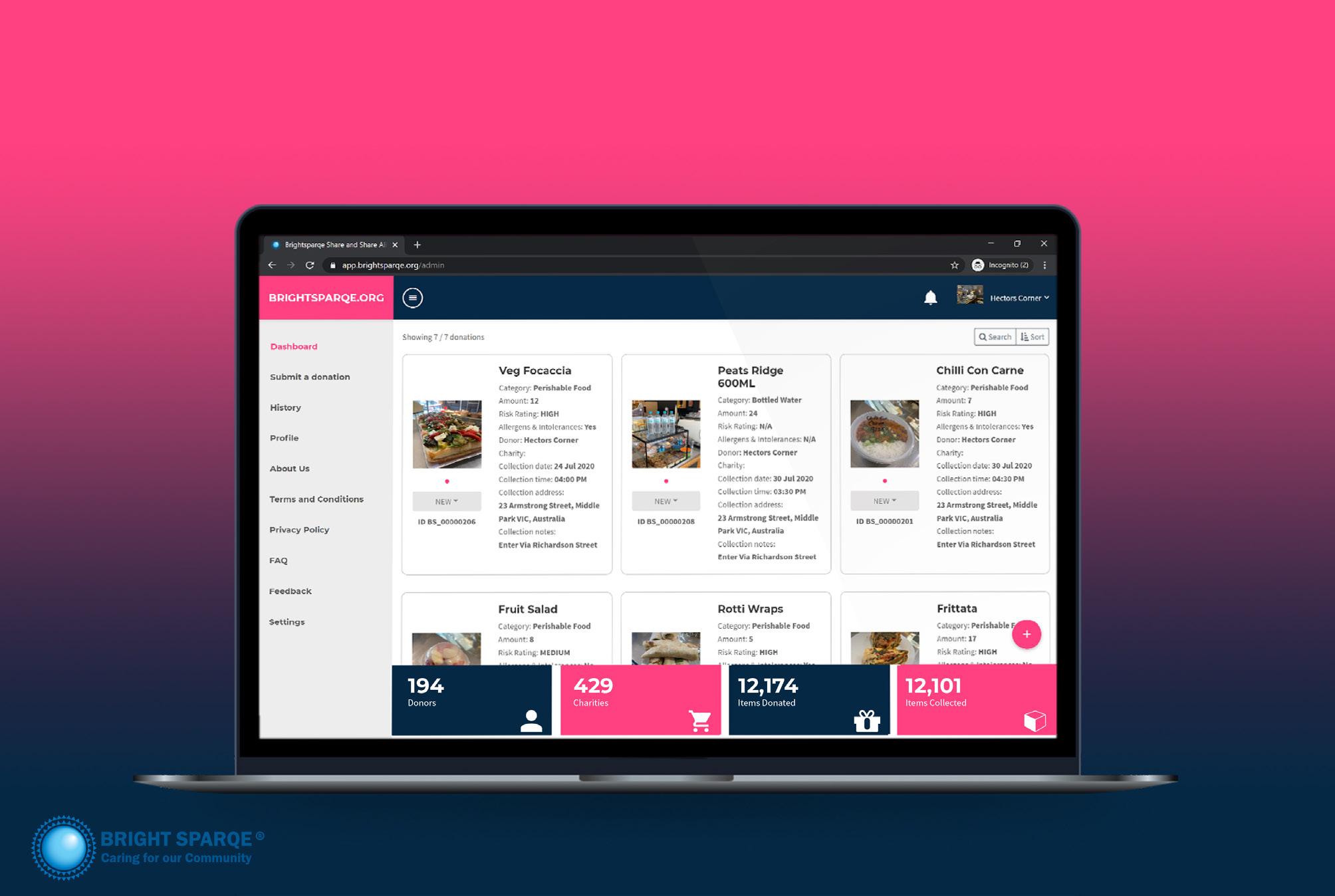
Bright Sparqe supports nationally (Australia) in excess of 400 Bright Sparqe partner charities (including Salvation Army, Exodus Foundation, Ronald McDonald Houses) and in excess of 180 Bright Sparqe partner donors (including Emma and Tom's, Denanda Ice Cream, Grove Juice).
The Bright Sparqe circular economy web and mobility-based platform supports the circular economy by providing a 100 per cent free to register and use Bright Sparqe platform. Website: brightsparqe.org/








19
CIRCULAR ECONOMY AWARD
The Bright Sparqe platform changes the culture of organisations who in turn amend their personal behaviour of not sending products to waste impacting our environment with pollution and climate change. The social impact is the support needed for our vulnerable community members throughout Australia to receive brand new products and food going to landfill.
Redfern local Lisa Mundine has been using the Bright Sparqe platform to source supplies. Her community organisation, The RAB movement, delivers about 300 fresh food hampers and meals every week to households across the inner city.
“We help families that work in industries that have been shut down, people who are under pressure to pay their rent, or under pressure to support others,” said Ms Mundine.
Sam Ferrier, sustainability manager of MCEC, said: “The event industry can be a wasteful one, and while we are doing our best to avoid waste in the first place, it’s great to be able to donate leftover and unwanted items to the local community, particularly when it can go to people in need.”
Charbel Yamouni, founder and executive director of Bright Sparqe, added: “With support from MCEC, Bright Sparqe can continue the journey to provide for our partner charities with fast access to brand new products and unused food, that will genuinely assist the communities most vulnerable.
The Bright Sparqe platform realtime secure reporting function allows our Bright Sparqe partner donors and partner charities to reallocate their administrative team members and volunteers to deliver their organisations aims and objectives.
The Port Phillip Community Group manager Lou Campbell “the platform allows us to move our team members from reporting to operations as we
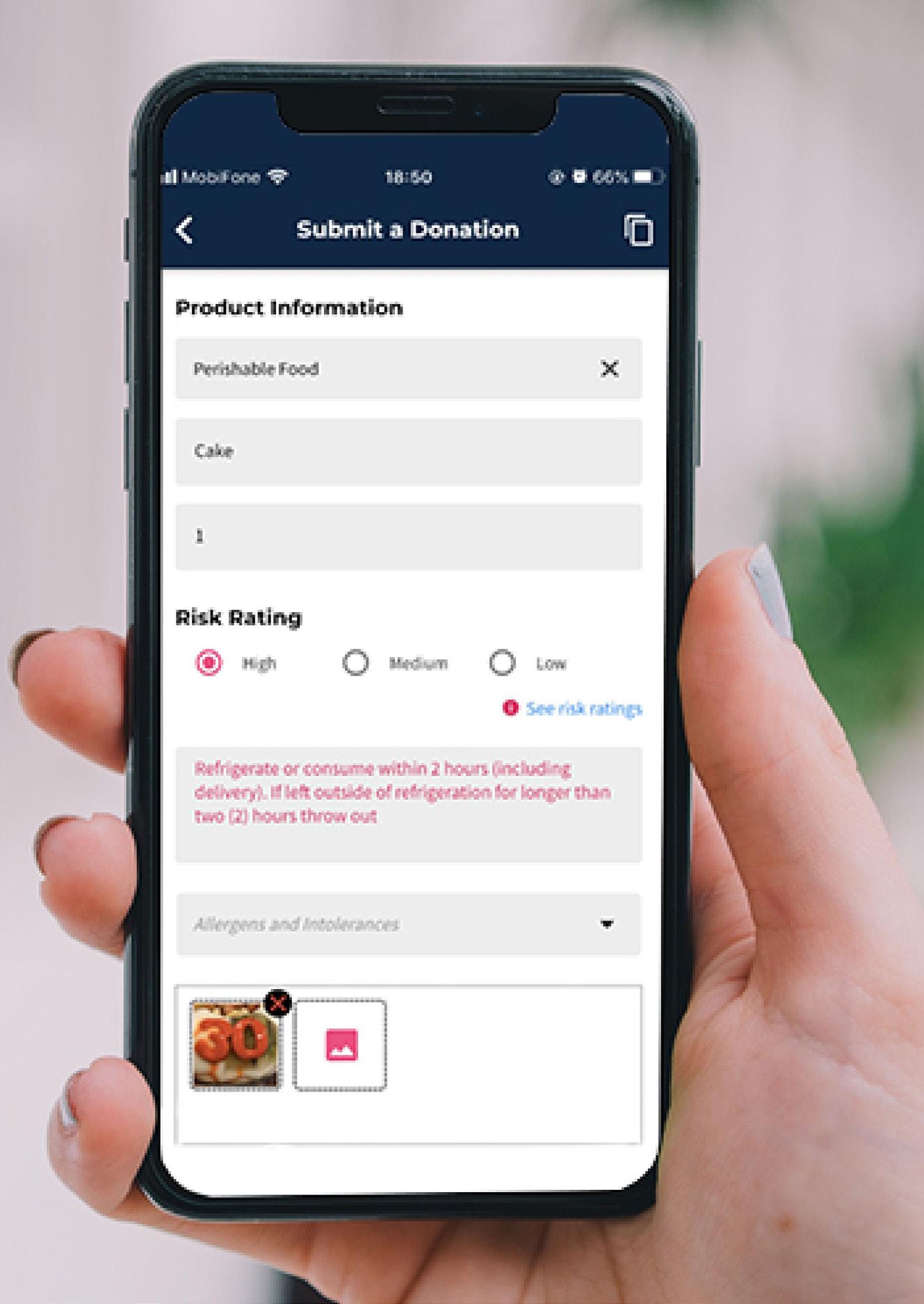
like many other charities and support groups have major issues with volunteers.”
Founder and Executive Director believes the Bright Sparqe web and mobility-based platform is the future for the circular economy. The ripple effect repurposing of products going to landfill causing pollution, impacting the environment, climate change, the cost of living and inflation who in turn supports our vulnerable community members from their financial pressure providing an opportunity to move into the middle class.
“We help families that work in industries that have been shut down, people who are under pressure to pay their rent, or under pressure to support others,”
20 NATIONAL SUSTAINABILITY SUCCESS STORIES
2024
Cultivated
Cultivating a circular economy for authentic furniture.
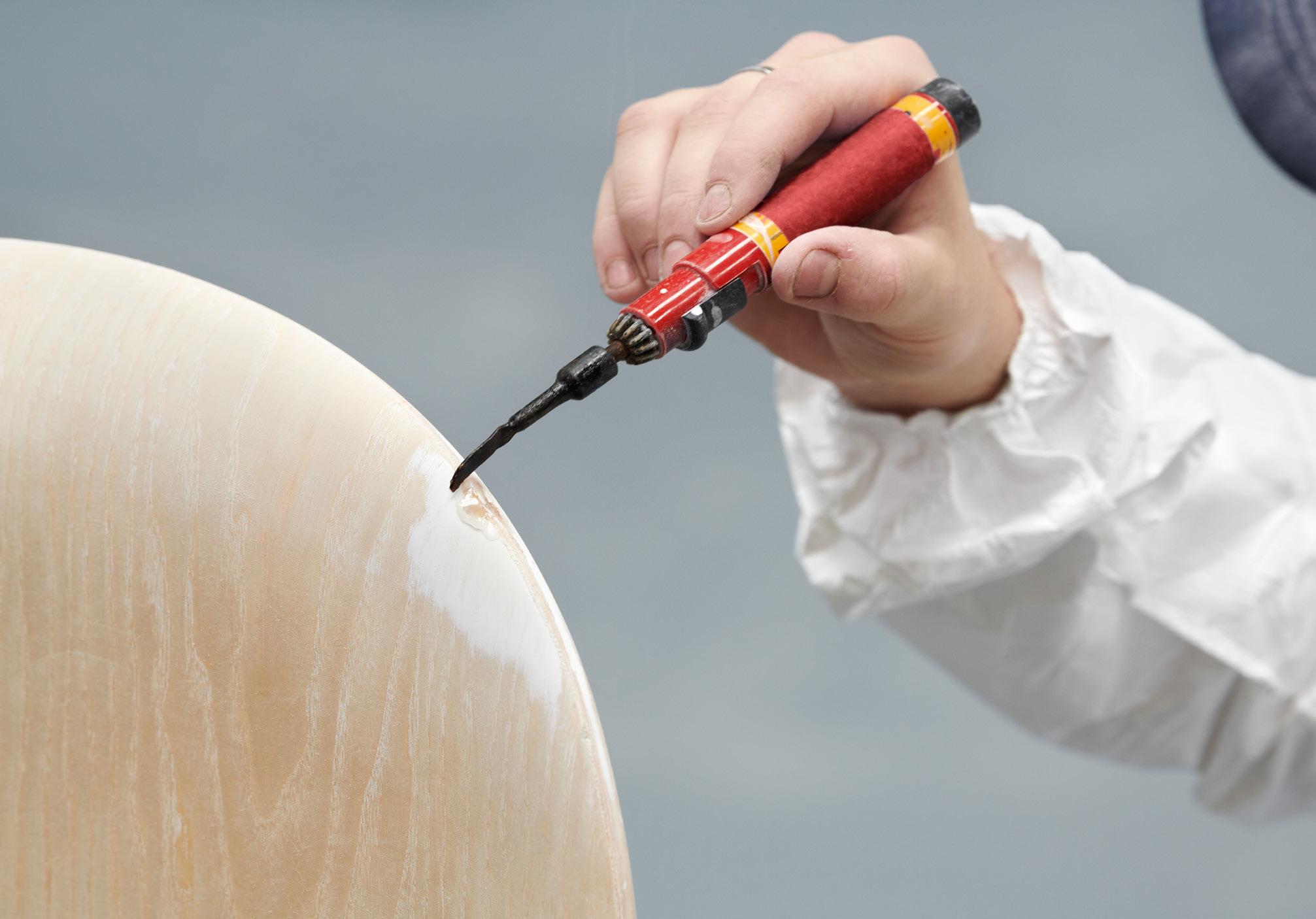
The Fritz Hansen Series 7™ chair was designed by Arne Jacobsen in 1955 and is arguably one of the most recognised furniture pieces in the world. Among the many locations home to this iconic Danish design was Sydney’s Art Gallery of NSW.
After 10 years of daily use in public gallery areas, conference rooms and exhibition halls, Cultivated acquired the worn Series 7™ chairs and worked with local craftspeople to restore them.
Website: cultivated.com.au





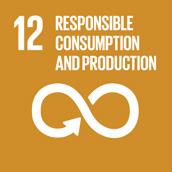
21
CIRCULAR ECONOMY AWARD
The Series 7 chair is designed by laminating 9 layers of veneer and then pressure molding them to achieve the form we all recognise, a groundbreaking technique back in the 1950's. These 9 layers are crucial to the structural integrity of the chair and our team takes extreme care to retain the layers. Our team of skilled carpenters began the restoration process by hand sanding back the worn lacquer to smooth out minor scratches and reveal the raw timber veneer. Bigger chips were then filled by hand with a special wax that sets clear and rigid, before hand sanding again to ensure a seamless blend with the original veneer. For particularly aged and worn Series 7 chairs with more significant damage to the veneered surface, new veneer was cut and inlaid by hand, before being pressed, hand sanded and lacquered to match the original surface. The Series 7’s were then ready to be lacquered. Throughout the Cultivated process, human hands are as essential as they were in creating the original design.
Today, the Cultivated Series 7™ chairs from the Art Gallery of NSW reside in multiple locations across Australia including Grosvenor Place Foyer at 225 George Street in Sydney, 321 Exhibition Street in Melbourne and the Appellation Wine Bar in Armadale, Melbourne.
Cultivated acquired The Fritz Hansen Series 7™ chair designed by Arne Jacobsen in 1955 and worked with local craftspeople to restore them


22
2024 NATIONAL SUSTAINABILITY SUCCESS STORIES
ECORR Pty Ltd
ECORR showcases circularity and what can be achieved when action and authenticity are combined.

ECORR’s mission is to build the foundations for success, where sustainable practices are intrinsic to its business.
As a leading figure in the circular economy, and through its refreshed strategy, ECORR has evolved from an organisation purely focused on resource recovery to one that is grounded in advancing the uptake of circular practices within its client-base, by becoming a solutionsfocused strategic partner with the advent of its advisory services offering.
ECORR is setting course to change what’s possible in circular economy business models through its quest to eliminate the use of quarried virgin material through recycling and reprocessing construction waste creating performance-engineered circular construction materials and solutions for use by industry.
Website: ecorr.com.au/








23
CIRCULAR ECONOMY AWARD
ECORR demystifies circularity by streamlining client efforts and establishing the foundations to integrate more sustainable options throughout the project. ECORR works closely with its clients from the design phase through to execution, driving the identification and adoption of circular and sustainable solutions within projects, finding pathways for beneficial reuse and spoil management, and sourcing costcompetitive recycled alternatives to realise the competitive advantage of truly circular thinking.
As an organisation, ECORR recognised that whilst they had the right mindset, they needed expertise in circularity and sustainability to build its knowledge, internal capability and roadmap of action and implementation to fully articulate its ambitions.
Through engagement of a thirdparty specialist firm ECORR sought support in baselining the impact of its operations, understanding the needs of its stakeholders, determining approaches to best identify and align its objectives with the relevant Sustainable Development Goals to create a suite of comprehensive and realistic actions geared towards measurable outcomes. They identified the right metrics to track and report and oriented their internal and external resources to support implementation over time.
The result was ECORR’s newly refreshed business strategy, baseline operational footprint and supporting initiatives. These foundations yield commercial and sustainable benefit and provide a credible footing for ECORR in their conversations with clients.
As at FY23, 99% of materials entering ECORR’s facility are recycled and materials produced for market contain 95% recycled content. Since July 2023, ECORR have processed over 300,000t of recovered material averaging more than 60,000t per month. This represents a growth of 43% on same time last year.

To continue to deliver impact, ECORR has targeted growth of its client based to larger businesses scaling use of recycled materials and advocacy of circularity to the sectors largest players.
Composition of Tier 1 & 2
Infrastructure companies has grown six-fold since FY21 and the launch of its strategy and commencement of new product development.
The advent of ECORR’s advisory services was the key point of differentiation for ECORR and enabled them to support their client base in their goals towards circularity.
ECORR has created a new form of business that is neither just commercial nor just sustainable, but a seamless integration of the two, creating a new approach in their sector, and a first for NSW.
ECORR embodies what it means to be a business operating in a climate constrained world, showing what is possible when action and mindset, and tenacity and authenticity are combined.
A quest to eliminate the use of quarried virgin material through recycling and reprocessing construction waste
24 NATIONAL SUSTAINABILITY SUCCESS STORIES
2024
Goterra
Goterra has revolutionized sustainable organic waste with the power of robotics and maggots.
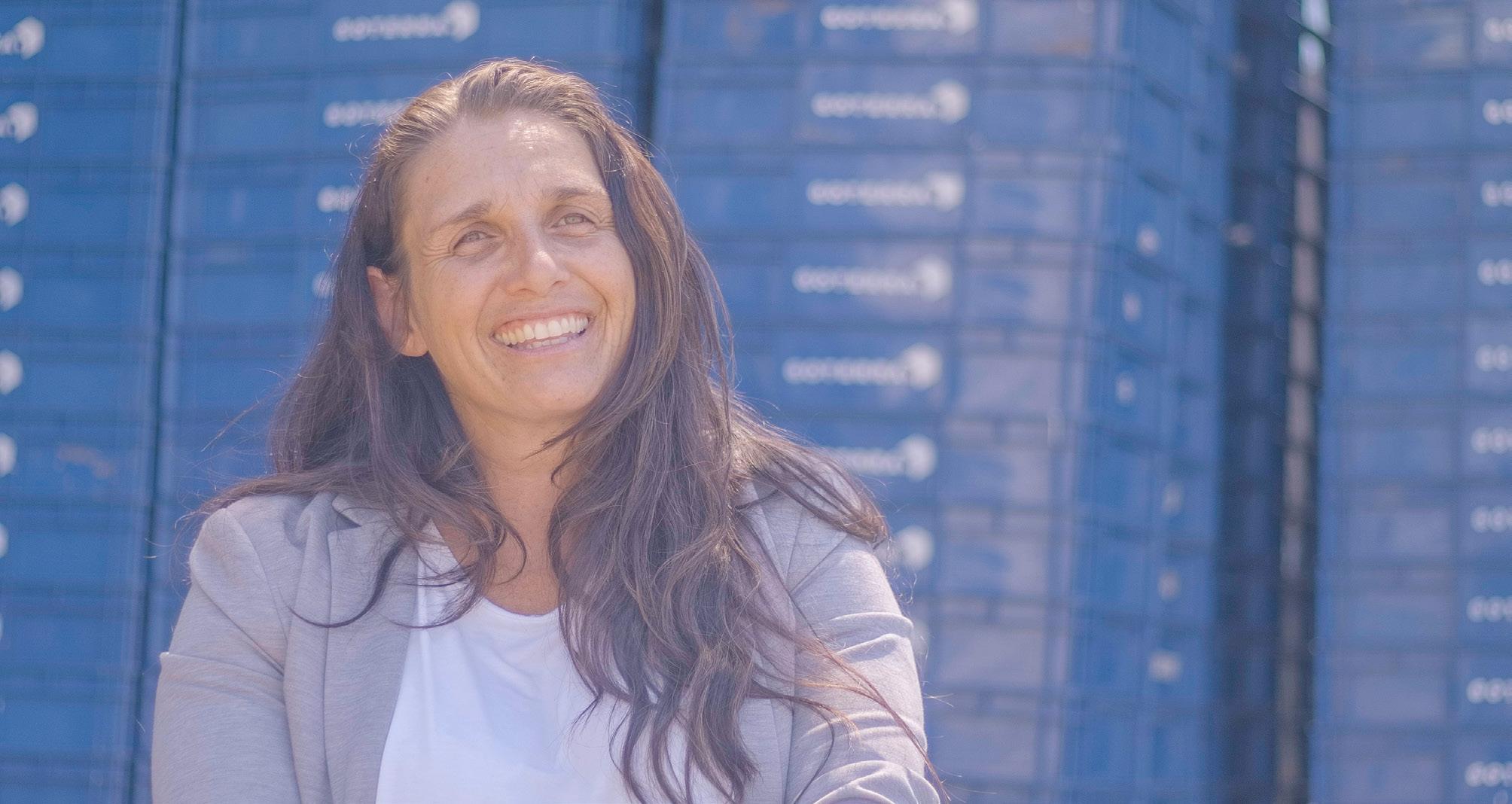
The Woolworths story
Woolworths is Australia’s largest food retailer. Alongside its food waste commitment, the company has committed to source 100% green electricity by 2025, practice responsible stewardship of natural resources, and achieve net positive carbon emissions by 2050. The company is exploring progressive solutions, such as encouraging sustainable and regenerative agricultural practices in its supply chain.
Working with Goterra is a natural fit with these ambitions. Using black soldier fly larvae to convert the waste into protein supports the journey to a more circular economy, as it produces high-quality sustainable protein and soil enhancer.
Website: www.goterra.au









25
CIRCULAR ECONOMY AWARD
Why Woolworths chose Goterra
One of Woolworths’ guiding principles is to “apply circular thinking in everything we do”. After any usable products have been donated to human consumption (via OzHarvest) or farmers, Goterra’s circular approach ensures nutrients are retained in the economy for as long as possible. It is the highest possible application on the waste hierarchy.
Not only does Goterra provide an innovative solution to help Woolworths close the gap on food waste, it is also cost effective. Goterra’s gate fee is cheaper than landfill and the overall cost is highly competitive.
The food waste collection rollout
Food waste diversion is not possible without the support of Woolworth’s store teams.
Woolworths and Goterra worked together to design and implement a thorough induction process for stores. This ensures they had the infrastructure and training required to be successful.
Stores were provided with the appropriate bins, as well as posters and education about what is accepted in the waste organics bin. We scheduled weekly calls to review success and address shortcomings until the service was successfully embedded and operating smoothly.
The results
The service operates smoothly in every store across ACT.
Weekly waste volumes are consistent and contamination is low. The partnership recovers around 6 tonnes of organic waste each week in ACT, converting it into high quality protein, and radically reducing the impact of the waste.
We are proud to partner with each other to accelerate the journey to a circular economy.


Next steps
Woolworths and Goterra are working together to improve organic waste recovery in other locations around Australia. Our next step is installing additional capacity in Albury Wodonga in 2021.
26 NATIONAL SUSTAINABILITY SUCCESS STORIES
2024
ReSource
ReSource is Australia’s largest and most technologically advanced ewaste processing facility on a mission to prove there is a better way to recycle efficiently, profitably and sustainably.
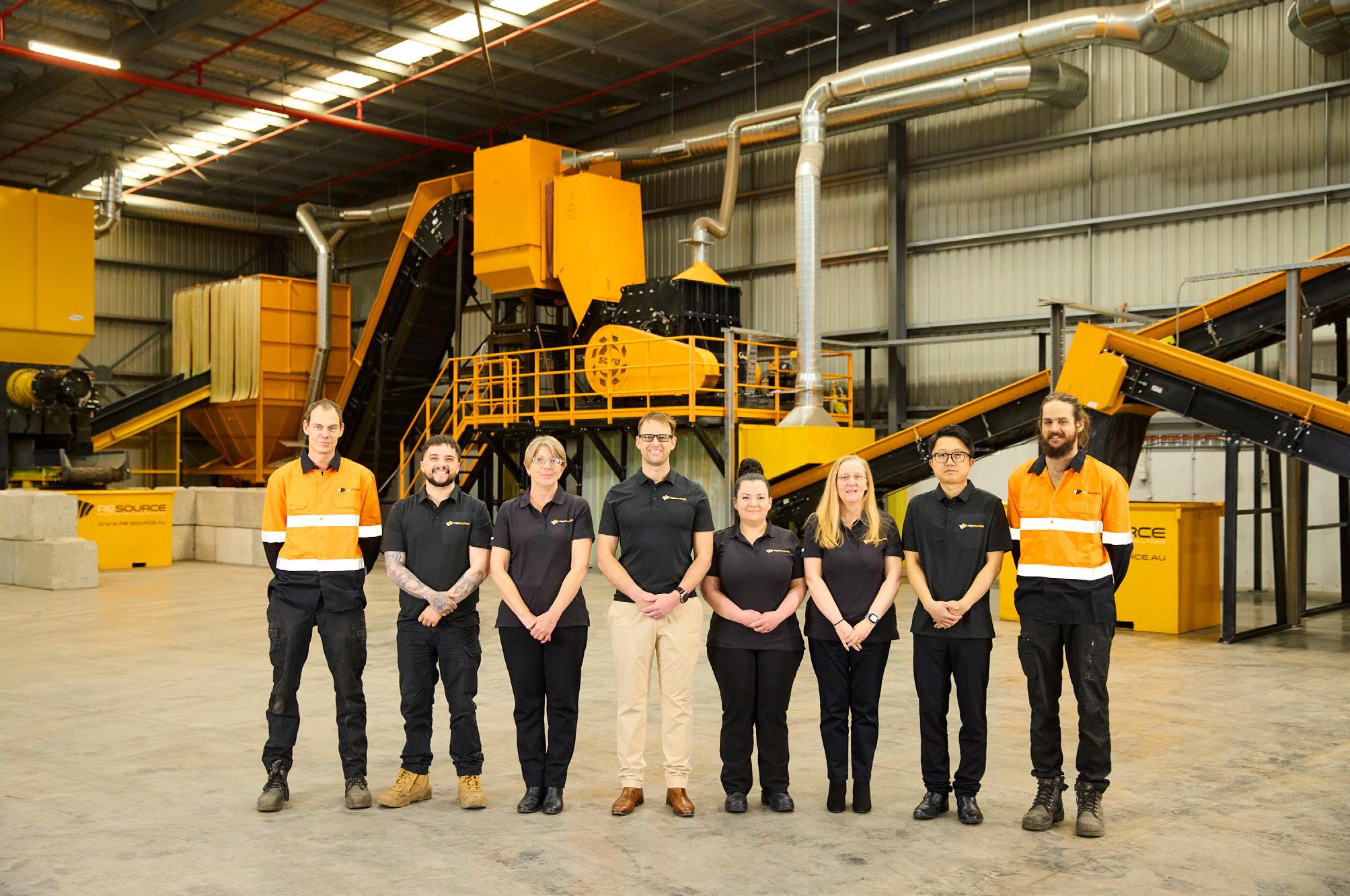
ReSource is the first company to bring large-scale e-waste processing to Australia and the largest dedicated e-waste recycler in the country. Their vision is clear: to redefine the standards of e-waste recycling, demonstrating that it can be conducted on a large scale while maintaining ethical integrity, environmental conservation, and financial viability.
ReSource, Australia's E-Waste Pioneer, harnessing technology for unparalleled e-waste processing
Website: re-source.au/






27
CIRCULAR ECONOMY AWARD
Leveraging a model common in the US and Europe but new to Australia, ReSource uses cuttingedge technology to process more efficiently and maximise the recovery of valuable materials.
Australians produced 21.7kg of e-waste per person in 2020, putting us fifth on the global stage. However, it is estimated that only 54% of all e-waste is collected in Australia, with 80% going to low-efficiency recycling. In a forward-thinking approach, ReSource created a state-of-the-art e-waste recycling facility on a 15,000 sqm site in Victoria. With an EPAlicensed capacity to process up to 20 million kgs of electronics annually, the facility is the largest and most technologically advanced e-waste processing facility in Australia. The capacity of other comparable facilities is only a fraction of what ReSource is capable of.
A key innovation is their custom solution for processing Temperature Exchange Devices (TEDs), which prevents over 98% of VOCs and airborne heavy metals from entering the atmosphere, making them the only facility in Australia with this capability. Furthermore, their use of AI and X-ray technology in battery processing uses only 1/25th of the energy of traditional methods and recovers up to 80% of battery materials for use in micronutrient fertilisers, significantly reducing the need for raw resources.
The ReSource facility is home to many Australian firsts. They are the first Australian recycling facility to have a net negative energy impact thanks to an 830 kW solar system that will produce more energy than operations consume. The first with AI-powered, thermally activated water cannons to protect against LiIon fires, and the first X-ray sorter for mixed batteries in the Southern Hemisphere. The first to have a fleet of vehicles and equipment (on and
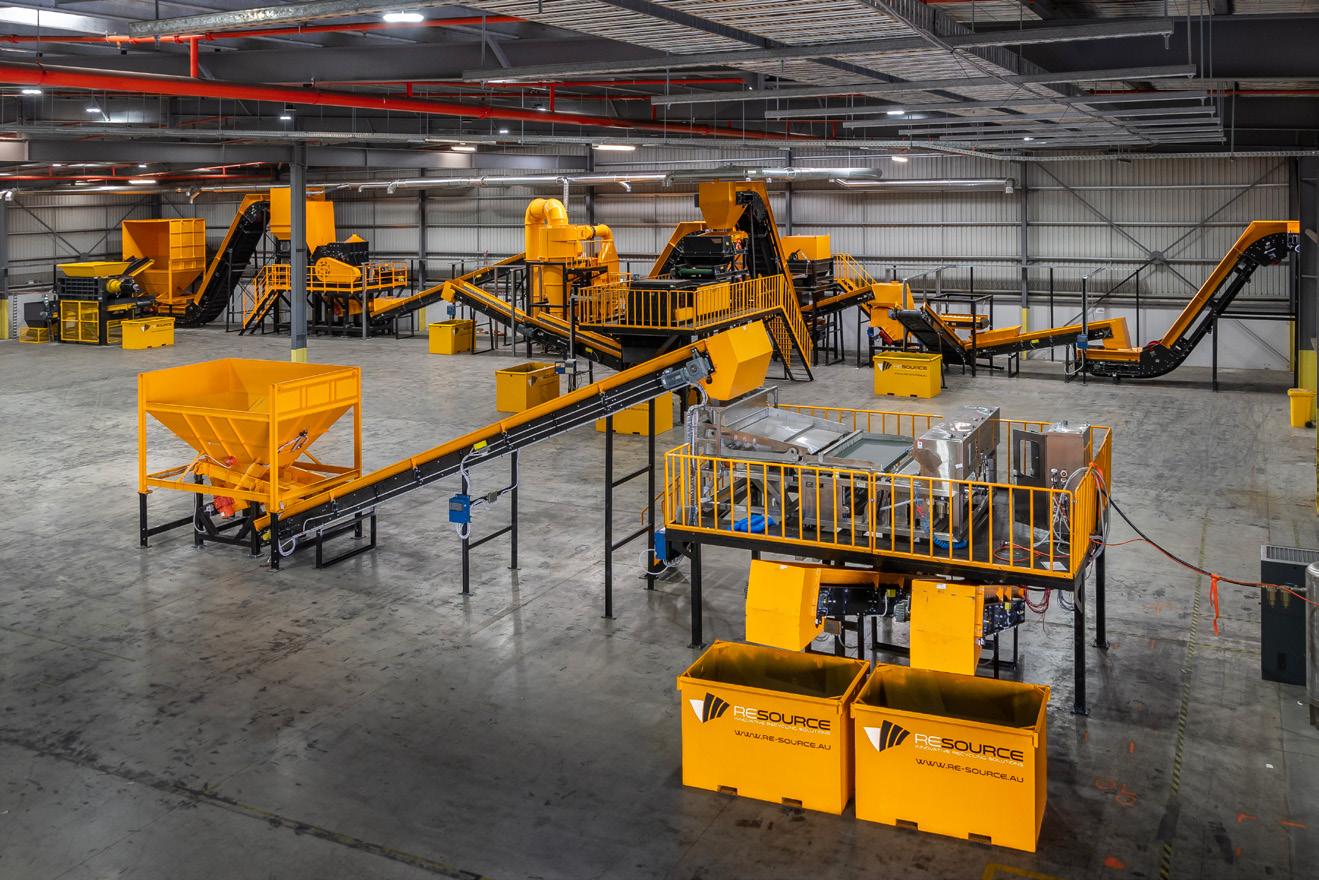
off-road) with Euro 5 emissions or better and they are on the cusp of developing a solution to recycle e-plastics back to their original single polymers, something not yet possible in Australia.
ReSource's transformation of e-waste management in Australia positions them as a leader in sustainable waste processing. They have already achieved 10% of their total capacity within six months of operation. They are on track to reach 50% capacity in 2024 and full capacity within three years. The facility's use of advanced technology has enabled the reclamation of up to 90% of some materials, showcasing exceptional efficiency in resource recapture and energy use.
ReSource is here to pioneer a better way to recycle e-waste in Australia with innovative technologies that maximise material recovery and minimise waste. They hope to make an impact far beyond what they can achieve as just one recycling company, leading to a paradigm shift in how we recycle e-waste in Australia.
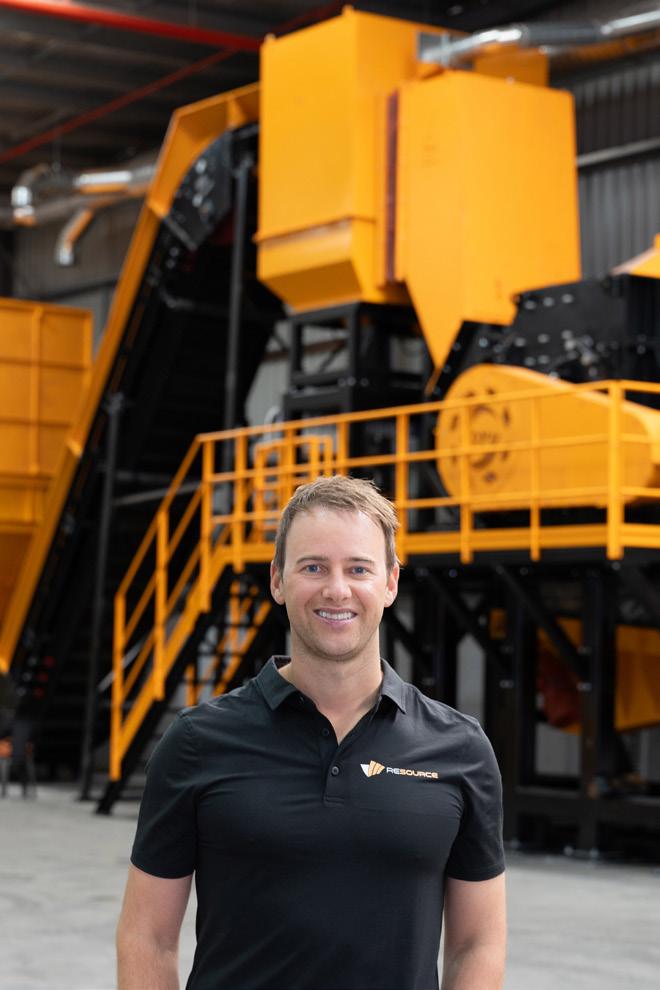
It is estimated that only 54% of all e-waste is collected in Australia, with 80% going to low-efficiency recycling
28 NATIONAL SUSTAINABILITY SUCCESS STORIES
2024
29 Climate Technology Impact Award
29
Climate Space Technologies
Fleet’s space-enabled Exosphere technology has demonstrated a path to scale critical mineral exploration globally while also helping to reduce environmental impact, which is the only approach that will enable humanity to reach its net-zero ambitions over the coming decades.

Core Lithium faced a major challenge: No reliable geophysical technique could directly detect and target lithium pegmatite rocks below the surface. Exosphere provided a faster and more sustainable solution to this problemenabling rapid exploration with nearzero environmental impact.
Leveraging the latest advances in Ambient Noise Tomography and Fleet’s constellation of satellites, Exosphere delivered 3D subsurface insights to Core Lithium in days - rather than months or years with other methods - to help accelerate their exploration program. In just a few days, a high-resolution 3D map of the subsurface of their survey was delivered, yielding results that were previously thought to be impossible.
Website: fleetspace.com/



31
CLIMATE TECHNOLOGY IMPACT AWARD
WINNER 2024

‘‘With ExoSphere we can make real time decisions very quickly, getting into positions that we can define drilling targets quicker. When you can accelerate exploration programs, what you are really doing is accelerating your discovery which is a game changer for exploration.”
Andrew Bennett | Exploration Manager, Core Lithium
Exosphere’s survey data detected known pegmatites but also unknown ones in just 7 days of initial survey. No other viable geophysical method has been able to directly detect lithium pegmatites at a greater depth, proving the effectiveness of Exosphere’s satellite-enabled ANT survey method. ExoSphere successfully imaged the known pegmatite dyke with only a 5% velocity contrast between the slower pegmatite and the surrounding sandstone, revealing that just a small contrast is enough to image the subsurface.
The technology perfectly imaged the pegmatite down to 500 metres depth with high resolution in addition to determining the depth of base weathering. The 3D velocity model not only imaged the mineralised pegmatite but also identified new ones, which become new drilling targets. This allowed Core Lithium to quickly develop high potential targets while also reducing drilling costs and their overall exploration time frame.

This is just one of many examples demonstrating how Exosphere has created a more sustainable path to accelerating mineral discovery by reducing exploratory drilling and helping to identify new deposits of critical minerals needed for the energy transition.
‘‘With ExoSphere we can make real time decisions very quickly, getting into positions that we can define drilling targets quicker. When you can accelerate exploration programs, what you are really doing is accelerating your discovery which is a game changer for exploration.”
— Andrew Bennett | Exploration Manager, Core Lithium
32
NATIONAL SUSTAINABILITY SUCCESS STORIES
2024
EcoSwitch, The George Institute for Global Health
ecoSwitch - better foods for our planet
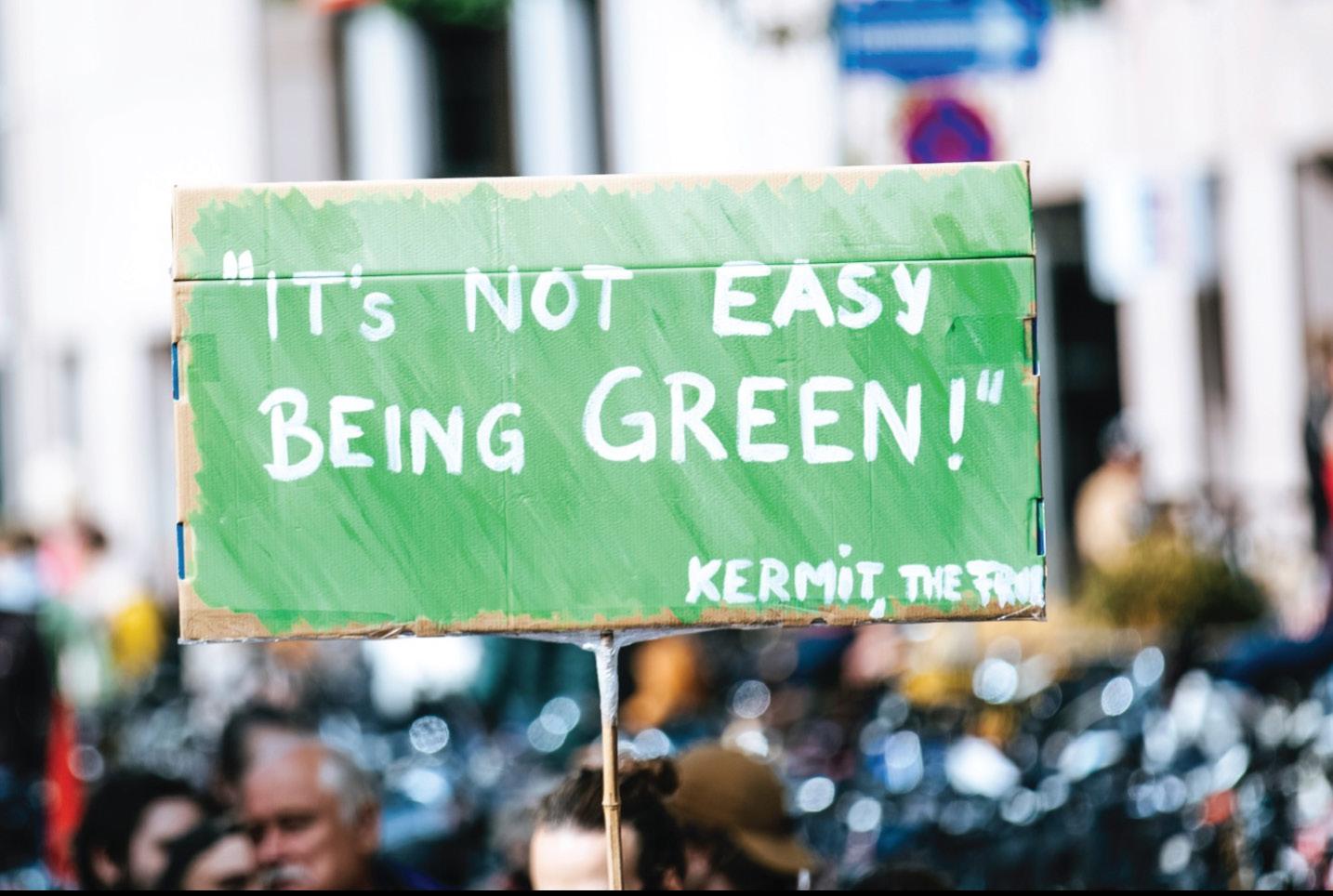
The George Institute is recognised as a global expert in applying nutrient profiling algorithms to score and rank the healthiness of individual foods based on their specific nutrient make up and it has applied this know how to develop an innovative new platform to assess the climate impact of foods - ecoSwitch.
The George Institute’s mission is to improve the health of millions of people worldwide, and its Food Policy team seeks to translate science-based research into changes to government policy and industry practice that will improve Australia’s food environment.
Website: georgeinstitute.org.au/projects foodswitch#about-ecoSwitch



33
CLIMATE TECHNOLOGY IMPACT AWARD
ecoSwitch
The global food system is estimated to generate 30%-40% of the world’s greenhouse gas emissions (GHGe) and is a key contributor to climate change. The recent UN COP28 climate conference cited the transformation of our food system as essential to achieving the goals of the Paris Agreement and address climate change.
ecoSwitch scores the GHGe impact of over 60,000 individual Australian packaged food and presents the scores as a Planetary Health Rating (PHR) - from 1/2 a star (worst) to 5 stars (best).
Consumers can use the ecoSwitch app to scan a food’s barcode and see its PHR and alternatives with a lower climate impact.
How it works
ecoSwitch estimates the ingredient composition of a packaged food by applying a mathematical technique to selected information from its food label. It then assigns carbon values based on life cycle assessment data and the weight of each ingredient. These estimates are adjusted based on the food’s country of origin information and its level of processing. The final scores are then converted into a Planetary Health Rating.
Goal
The goal of ecoSwitch is to direct consumers to lower impact food choices and provide a data system that will allow government to set policy and monitor targets towards a more sustainable food environment. Key to this will be the further development of the data system to enable industry to update the environmental sustain ability of their products in a single, consistent, science-based scheme. This data system will also be valuable to help industry monitor their ESG - Scope 3 commitments.
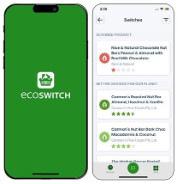

34
NATIONAL SUSTAINABILITY SUCCESS STORIES 2024
O3 Water Pty Ltd
O3 Water, Innovate Disrupt Transform

What started as a search for a better solution to provide clean water led to the development of an innovative disruptive technology that challenged the status quo and spawned new products with applications across a wide swathe of the economy.
Water is unique in its attributes:
• it has no substitute
• it is a finite resource
• all life depends on it












Website: o3water.com.au CLIMATE TECHNOLOGY IMPACT AWARD
What started as a search for a better solution to provide clean water led to the development of an innovative disruptive technology that challenged the status quo and spawned new products with applications across a wide swathe of the economy.
The aoniq technology, developed over several years by O3 Water, harnesses and amplifies the potent natural disinfection capability of ozone, to kill all waterborne microorganisms instantly. This includes bacteria, virus, yeast, algae, mould, protozoa, mildew, adenovirus, cysts as well as chlorine resistant microorganisms.
Unlike chlorine, which leaves residual by-products linked to various health concerns and is toxic to marine life, the ozone decomposes naturally into oxygen.
The aoniq technology is 3,000 times faster than chlorine and 10 times faster than UV light, requires no consumables, removes odours, and is fully tested by National Australian Testing Authority (NATA) approved lab.
The initial application of the technology was to provide clean water to affected populations during disasters. With climate change, disasters are more powerful and frequent with first responders supplying bottled water, among other tasks, to stop disease outbreak in disaster affected zones.
To meet the needs of first responders, the solution had to be portable for fast deployment and capable of delivering water at a fraction of the cost of bottled water.
Following several years of design iterations the Zen 360 was developed with a capacity to deliver 3,600 litres/ hour of clean water to sustain over 2,000 lives at 14 times lower cost than bottled water. The final product weighs around 100kgs making it very portable.
The aoniq technology is completely scalable and can process megalitres of water making it ideally suitable for municipal water supplies.

A Zen 360 operating for 12-hours a day over one week would:
• Replace 504,000 water bottles
• Save transport cost of 315 metric tonne of bottled water
• Eliminate the need for 564m3 of storage
• Stop environmental damage from 504,000 empty plastic bottles
The aoniq technology will lead to sustainable environment and growth in economies as people move out of poverty, seek education, and earn better income.
The lasting legacy will not be about the aoniq technology but the relentless pursuit of an audacious vision to shape the future and transform the lives of countless people while inspiring others to push the boundaries.
The business model of O3 Water is based on innovative and disruptive solutions to global water challenges. This is demonstrated by the thirteen SDGs the technology addresses and the innovative solutions spawned to date which also include the:
• Neo 360, a defence version of the Zen 360 mounted on a NATO spec trailer with a defence grade generator and two 5,000 litre collapsible food grade tanks
• Zen 180T, a submersible unit for water storage tanks with a disinfection capacity of 1,800 litres/hour. This unit can disinfect a 10,000-litre tank in less than 6 hours
Capacity to deliver 3,600 litres/hour clean water to sustain over 2,000 lives at 14 times lower cost than bottled water
36 NATIONAL SUSTAINABILITY SUCCESS STORIES
2024
Plico
Plico: switching on Western Australia’s first Virtual Power Plant

As the climate continues to warm and average temperatures increase, power usage is surging putting pressure on the grid which requires more fossil fuels usage to keep the lights on.
Australian’s have been warned to brace for more blackouts if there is not timely investment and innovation in renewable energy; to reliably meet power demand and to successfully transition to clean energy. Ingenuity was needed to prevent looming blackouts and to provide a sustainable clean energy solution.
Introducing clean energy company; Plico.
Website: plicoenergy.com.au/





37
CLIMATE TECHNOLOGY IMPACT AWARD
Plico exists to accelerate Australia’s clean energy transition by making solar + battery systems affordableenabling every Aussie household to make a difference in fighting climate change. The team at Plico believe clean energy should be accessible to all Australians. They wanted to fundamentally change the energy landscape in Australia.
Plico connected nearly 1,000 of its customers solar + battery systems, to form one giant united battery
To achieve this audacious goal, Plico needed a solution to prevent blackouts during summer heatwaves while also accelerating clean energy use. To do this they knew it required developing cutting-edge technology (that did not exist) to build a Virtual Power Plant (VPP).
A VPP is emerging technology uniting many independent DERs (home solar + battery systems) orchestrated together under a smart, cloud-based management system. Up until the Summer of 2023, a VPP had not been achieved in WA due to technology and knowledge limits.
Undeterred, Plico set about to lead the way in developing cutting edged technology - enabling all its customer solar and battery systems to act as one giant battery and export to the grid.
After trials, testing and working closely with suppliers, Plico successfully switched on, for the first time, a collection of associated individual, independent household solar + battery systems in Perth. The systems were united to form a VPP and were successfully switched on in a real-world scenario (outside of trials and pilots). Plico connected nearly 1,000 of its customers solar + battery systems, to form one giant united battery, and fed stored sun energy back into the grid.
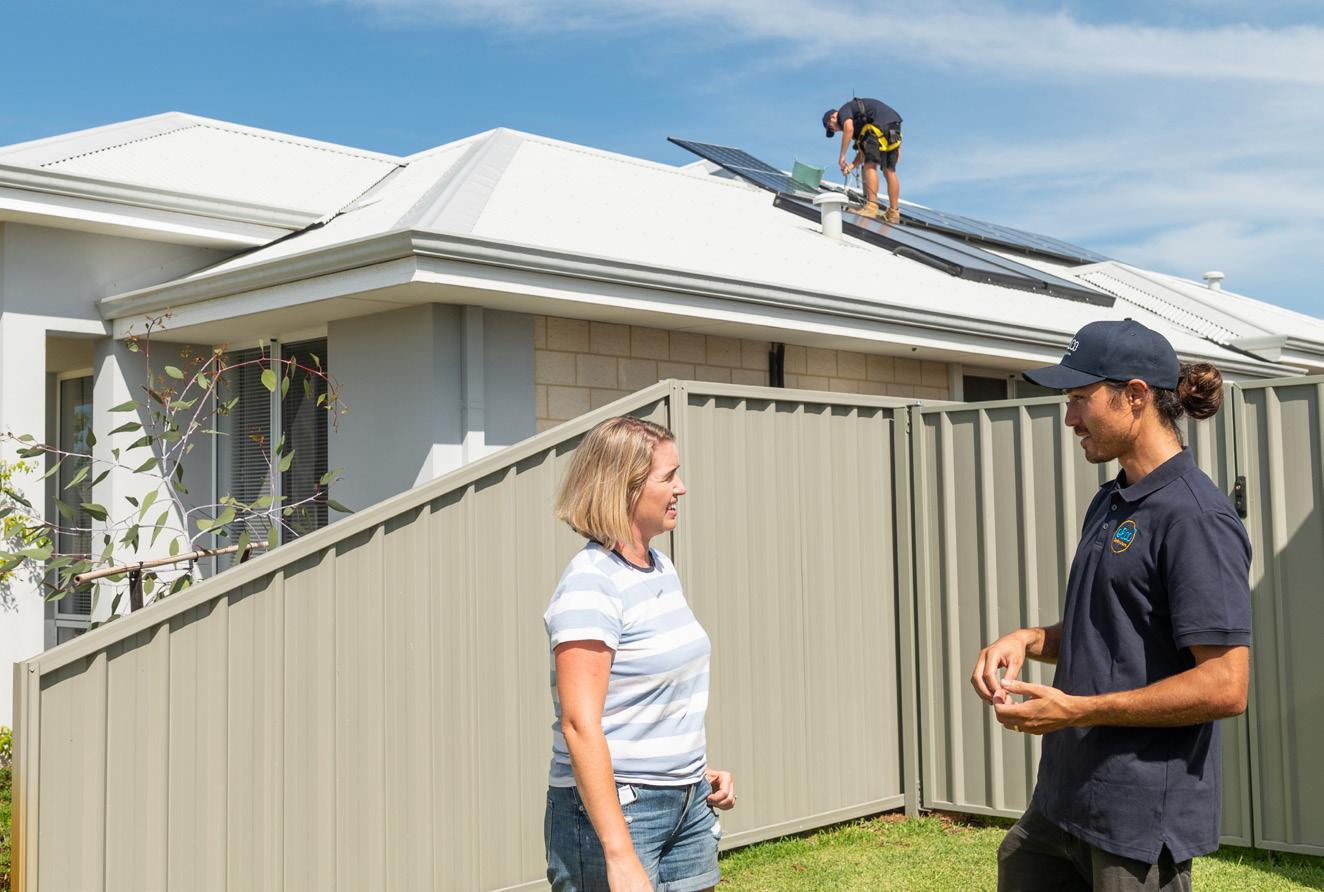

WA can lay claim in being one of the first states in Australia, to have a virtual power plant contribute capacity to its grid, to help maintain its stability during times of peak demand, all while reducing WA’s carbon footprint. In fact, total emissions reduced in the 2022/23 financial year totalled to 5,652,432 kg!
Plico demonstrated that you do not need to spend billions of dollars building centralised batteries – rather the infrastructure is already available in individual homes and can now be coordinated to feed clean energy back into the grid in times of high demand. While helping Australia’s transition away from fossil fuels and
achieve Net Zero targets, and driving significant environmental, social and economic impacts.
In switching on the VPP and reaching the targeted Megawatt clean energy support to the grid, the technology innovation is a tangible solution to transition to renewable energy, build sustainable communities and address climate change mitigation – all through less reliance on fossil fuels. This is just the beginning!
38
NATIONAL SUSTAINABILITY SUCCESS STORIES
2024
SIMPaCT — Smart Irrigation Management for Parks and Cool Towns
The SIMPaCT (Smart Irrigation Management for Parks and Cool Towns) project is the first fully autonomous city cooling system that turns green spaces into effective urban air conditioning units.
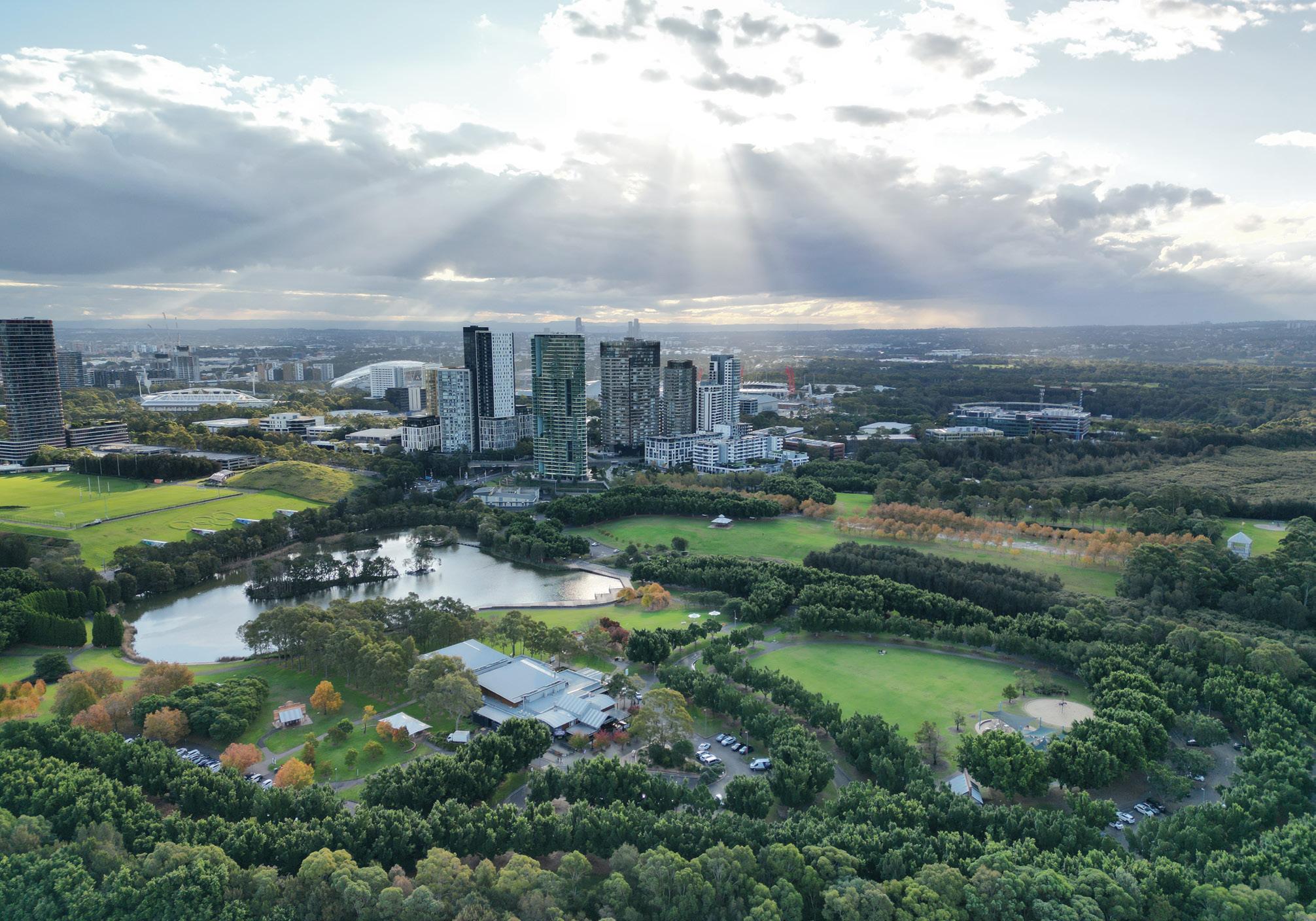
Western Sydney University, University of Technology
Sydney, Monash University, Eratos, HARC, The ARCs Group, CTS, SAPHI, Total Water, Sydney Olympic Park, Sydney Water, NSW Department of Planning and Environment
Website: simpact-australia.com/





The SIMPaCT project developed an autonomous irrigation system that improves climate change resilience of urban communities. The unique capability of SIMPaCT is its ability to manage park irrigation specifically for cooling of air and surface temperatures during hot summer days. Machine learning algorithms and a digital twin are used to estimate accurate irrigation schedules that maintain optimum health of vegetation and improve water use efficiency at any day of the year.
39
CLIMATE TECHNOLOGY IMPACT AWARD
The absorption of solar radiation, storage, and the subsequent emission of this energy as sensible heat leads to warming of air temperature across our cities, which in turn amplifies the risk of urban overheating and its associated negative impacts on public and ecosystem health, economic activities, services and infrastructure. Urban green infrastructure, like trees, gardens or parks, on the other hand help keeping cities cooler through shading of surfaces and evapotranspiration of water. As global warming leads to dryer and hotter summers, it is necessary to develop new strategies for urban cooling. Research has shown that well-hydrated parks can lower peak daytime air temperatures by up to 7°C and this cool air can travel more than 1 km downwind. Thus, supercharging parks to generate maximum rates of cooling in summer increases human thermal comfort inside and around parks and lowers energy needs of nearby buildings.
SIMPaCT maximises cooling at Bicentennial Park in Sydney Olympic Park using sensors that measure soil moisture, ambient temperature and humidity, wind speed and rainfall. LoRaWAN and 5G networks collect this real-time data which is ingested by a customised digital platform. The platform houses the digital twin of the park where geo-spatial models and machine learning algorithms continuously evaluate a large number of environmental scenarios to find the optimal irrigation solution for these scenarios. By ‘learning’ over time under which environmental conditions irrigation commands resulted in the ideal soil moisture levels, water use across the park is optimised while maximum air cooling is provided.
Using wireless sensors and generating water saving and cooling benefits makes SIMPaCT an ideal solution to effectively address climate change risks for cities. The system is deliberately constructed to easily up- or down-scale, allowing implementation of the SIMPaCT technology in a wide range of
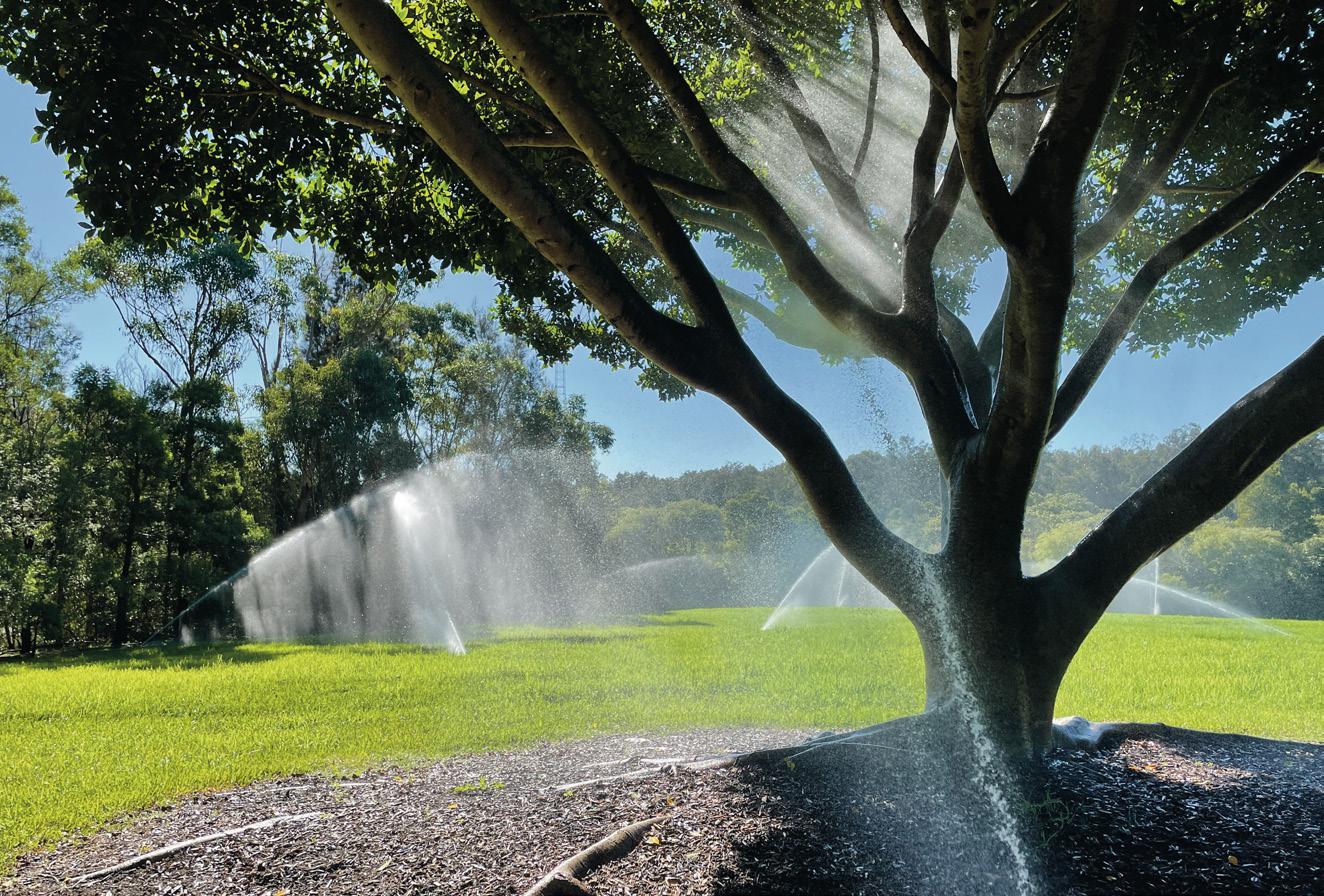
irrigation applications under different environmental conditions. The operational and public-facing webbased dashboards, available at www. simpact-australia.com include datarich visualisations allowing users to see current, historical and forecast environmental data. Park managers can easily determine faults and leaks in the irrigation system and visitors can choose the perfect day, time and location for activities in the park. The successful development and implementation of SIMPaCT was only possible due to exceptional collaborative efforts. Under the leadership of Western Sydney University, scientists from UTS and Monash University, in partnership with
The ARCs Group, Eratos, Centratech, HARC, SAPHI, Total Water, Sydney Olympic Park Authority, the NSW Department of Planning and Environment and Sydney Water, focussed on improving environmental quality, public health, and climate change resilience.
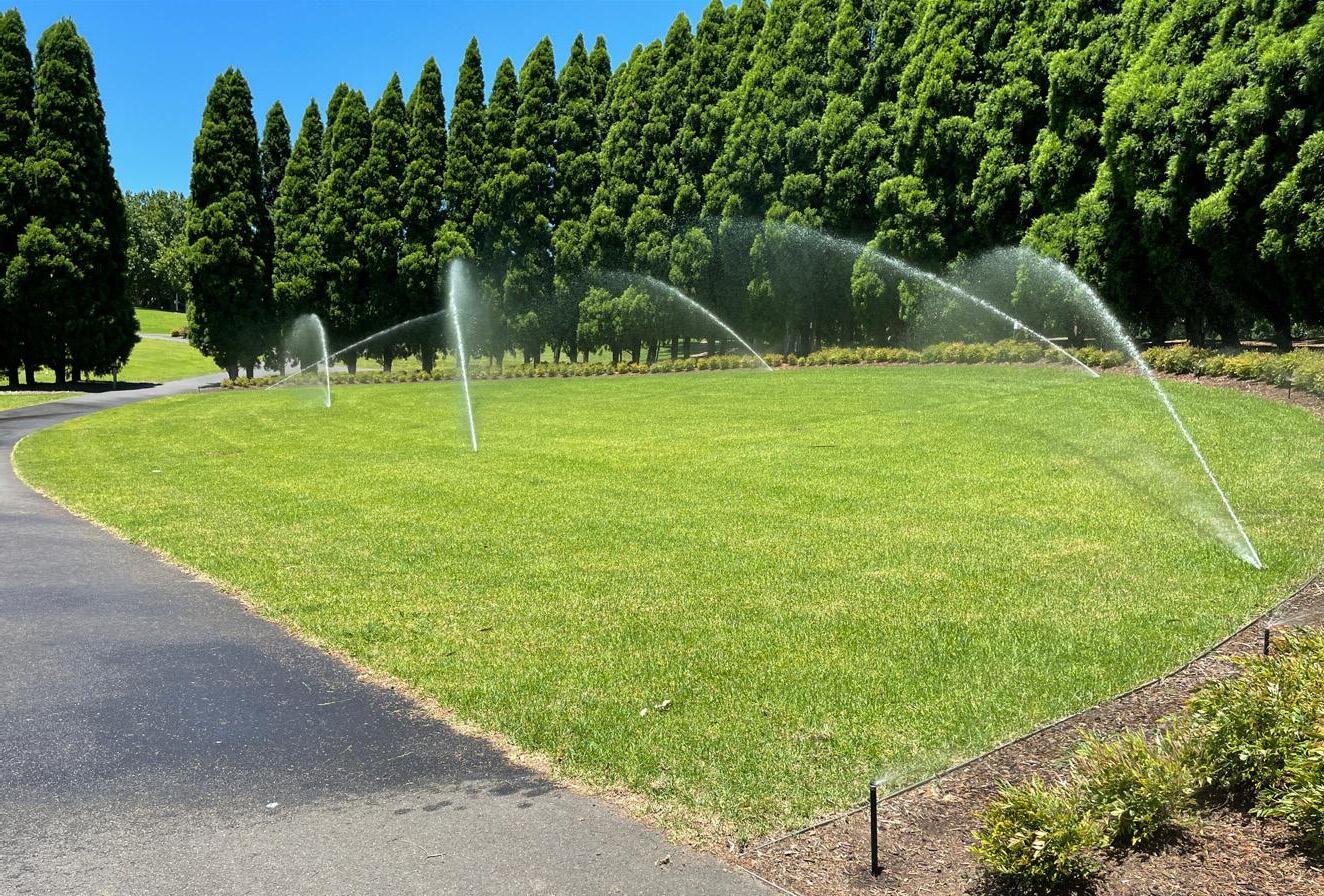
40
NATIONAL SUSTAINABILITY SUCCESS STORIES
2024
41 Diversity, Equity & Inclusion Award

The Social Outfit
The Social Outfit is a fashion label with a difference, helping new migrant and refugee women kick-start their Australian careers

The Social Outfit is a fashion label with a difference. They believe in an Australia where refugees and new migrants are warmly welcomed and settle well, celebrating diversity and collective skills and strengths.
Founded in 2014, they utilise a unique organisational model to deliver its mission. Incorporating a DGR-1 registered charity operating an employment focused social enterprise to successfully address the complex barriers to training and employment faced by newly arrived refugee and migrant women. This hybrid model enables the organisation to prioritise people and impact while creating and selling sustainable fashion products to generate revenue in support of our work. Showcasing the skills creativity and strengths of refugee and migrant women. They do this through their retail clothing store and ethical manufacturing workroom in Sydney’s Inner West. 85% of our garments are made from fabric diverted from landfill, saving over 14 tonnes to date
Website: thesocialoutfit.org/





43
DIVERSITY, EQUITY & INCLUSION AWARD
WINNER 2024
Refugee women have the highest unemployment rates of all disadvantaged groups of people in Australia
The Social Outfits Entry-level Supports include community engagement programs that focus on sewing and textile crafts, enabling participants to build on their existing skills while learning new ones, strengthening their confidence and social connections in a supportive environment. Participants looking to continue developing their skills and/ or commit to regular work hours are supported by the team to progress through program pathways to receive intermediate and intensive support. These supports include more formal training programs, delivered in partnership with TAFE; paid work experience, including the Earn & Learn sewing programs and Retail Training Program; and ongoing employment within the social enterprise in sewing, retail, program coordination and marketing roles. They also support successful transitions to ongoing external employment.
The Social Outfit programs effectively address barriers to social inclusion, employment and training by:
• Starting from existing skills and interests so they can contribute, feel valued and build confidence as they learn new skills, which contributed to positive attitudes to learning.
• To meet the women ‘where they are at’ we partner with 10+ community and settlement services organisations in Western and South Western Sydney to deliver a range of programs and pathways, dependant on emerging needs and interests.

• As a trading social enterprise they interact daily with the broader community creating opportunities for refugee women to practice speaking English and grow their networks.
• The Employment Pathways Coordinator supports the women with 1-2-1 mentoring as well as informal supports and referrals to partner services to remove barriers to participation.
• By using a ‘train the trainer’ approach, they are creating pathways for new kinds of employment. Our refugee sewing trainers inspire and connect with students through lived experience and mutual understanding, creating a sense of optimism for what might be possible for them in the future.
• The impact measurement framework, entry and exit interviews enable them to track, measure and evaluate the efficacy of both programs and individual participant progress. These are used to inform future programming and pathways.

As of the end of 2023, The Social Outfit have trained over 850 and provided employment to 97 women from migrant and refugee backgrounds. For 81% of women who have worked with us, The Social Outfit was their first Australian job. We have a target to achieve 100 employment opportunities and 1000 training outcomes by our 10th birthday in 2024!
85% of garments are made from fabric diverted from landfill, saving over 14 tonnes to date
44 NATIONAL SUSTAINABILITY SUCCESS STORIES
2024
The Funding Network
The Funding Network Australia (TFN) is a pioneer in finding and funding exceptional grassroots non-profits and social enterprises
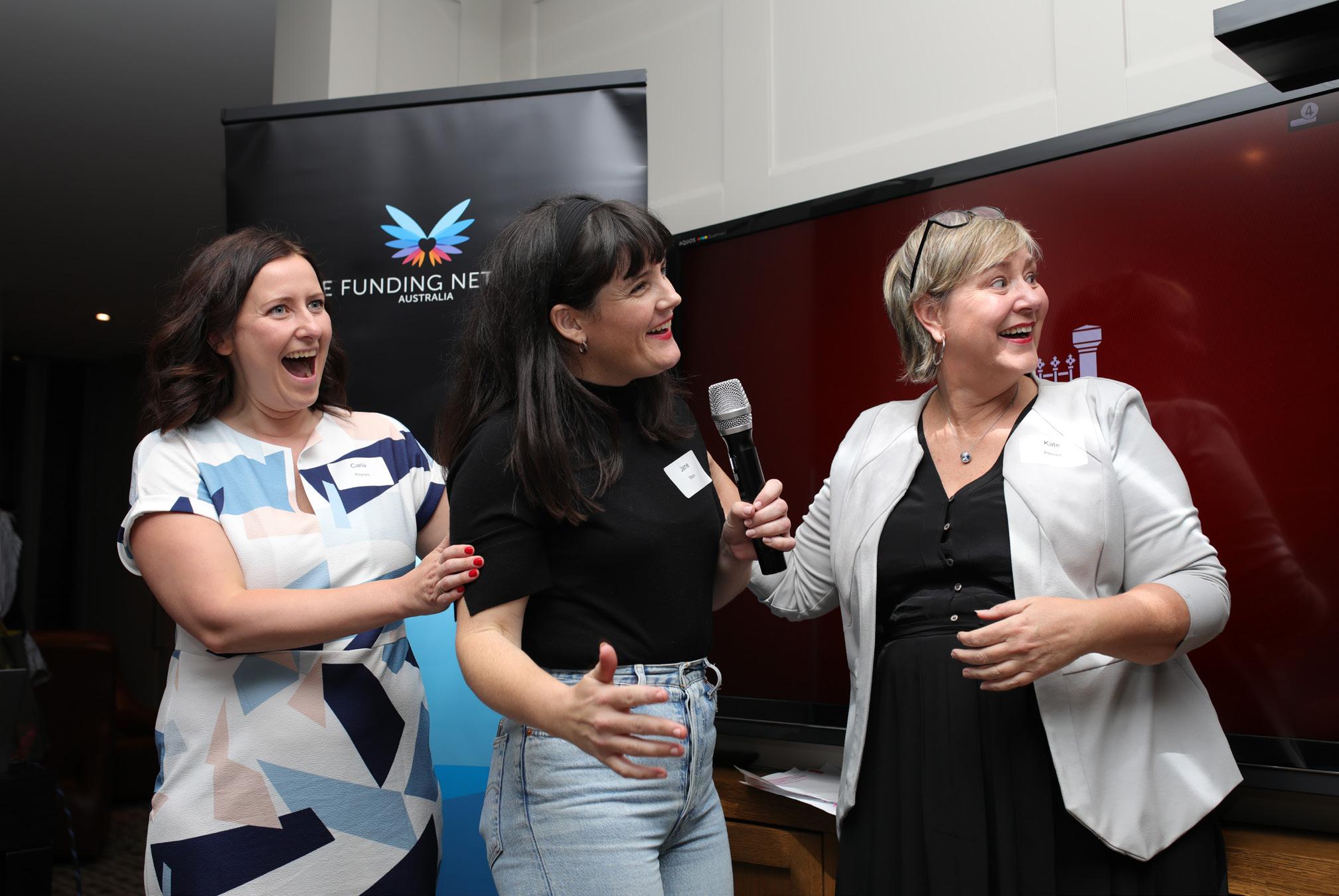
Nearly three years ago, Jane Marx was enjoying the rewards of building a successful non-profit hospitality business with young women from refugee backgrounds who were experiencing barriers to employment.
But, virtually overnight, the pandemic hit and the world shut down. Jane had to think quickly to make sure that the women who had been relying on her for their livelihoods would not be lost to this moment.
Recognising that hospitality would not be a viable business for some time, Jane decided to focus on a smaller aspect of their business that had always resonated with the women who worked with them.
Website: thefundingnetwork.com.au/












DIVERSITY, EQUITY & INCLUSION AWARD

Jane sat side by side in the codesign of The Beautiful Bunch with the women who had been her employees only days before and they taught themselves the finer art of floristry by watching youtube clips and reading everything they could get their hands on.
When The Beautiful Bunch were selected to pitch as part of the Equity and Inclusion event for The Funding Network in March 2023, Jane had the opportunity to share the ingenuity and plans for future growth beyond online sales and toward working in the event space. With the help of a passionate group of grassroots givers, the event raised over $37,000 to move toward that goal. This faith and the trust in their endeavours along with incredible supporters emerging beyond the event who have since invested money, time and insight will ensure that The Beautiful Bunch will continue to grow and scale for many more years.
“Pitching at the event in March came at a really crucial time for The Beautiful Bunch. We were entering what was both an exciting, but also challenging period of growth and were in need of further funding to
ensure we were able to launch a new product successfully,” explains Jane. “Not only did we raise vital funds, but crucially, made connections with people on the night who got in touch to provide funding and support thereafter. Our year would look very different had we not taken part in this phenomenal opportunity, and we are very grateful for all the work TFN does in supporting early-stage organisations like ours to thrive.”
Through partnerships and grassroots backing, The Beautiful Bunch propels diversity and inclusion initiatives forward

46 NATIONAL SUSTAINABILITY SUCCESS STORIES
2024
WWF — Australia
Indigenous Knowledge continues to be excluded or marginalised from global climate science and policy processes - by further strengthening Indigenous engagement, WWF-Australia seeks to redress this imbalance to better Regenerate Nature together.

Aboriginal people have cared for Country in Australia for at least 65,000 years.
‘Country’ is a term used by First Nation Australians to describe a complex system of law, place, custom, language, spiritual belief, cultural practice, material sustenance, family and identity. As one WWF-Australia staff member often says: “People and Country are one and the same. You can’t have one without the other.”
Website: wwf.org.au/

47
DIVERSITY, EQUITY & INCLUSION AWARD
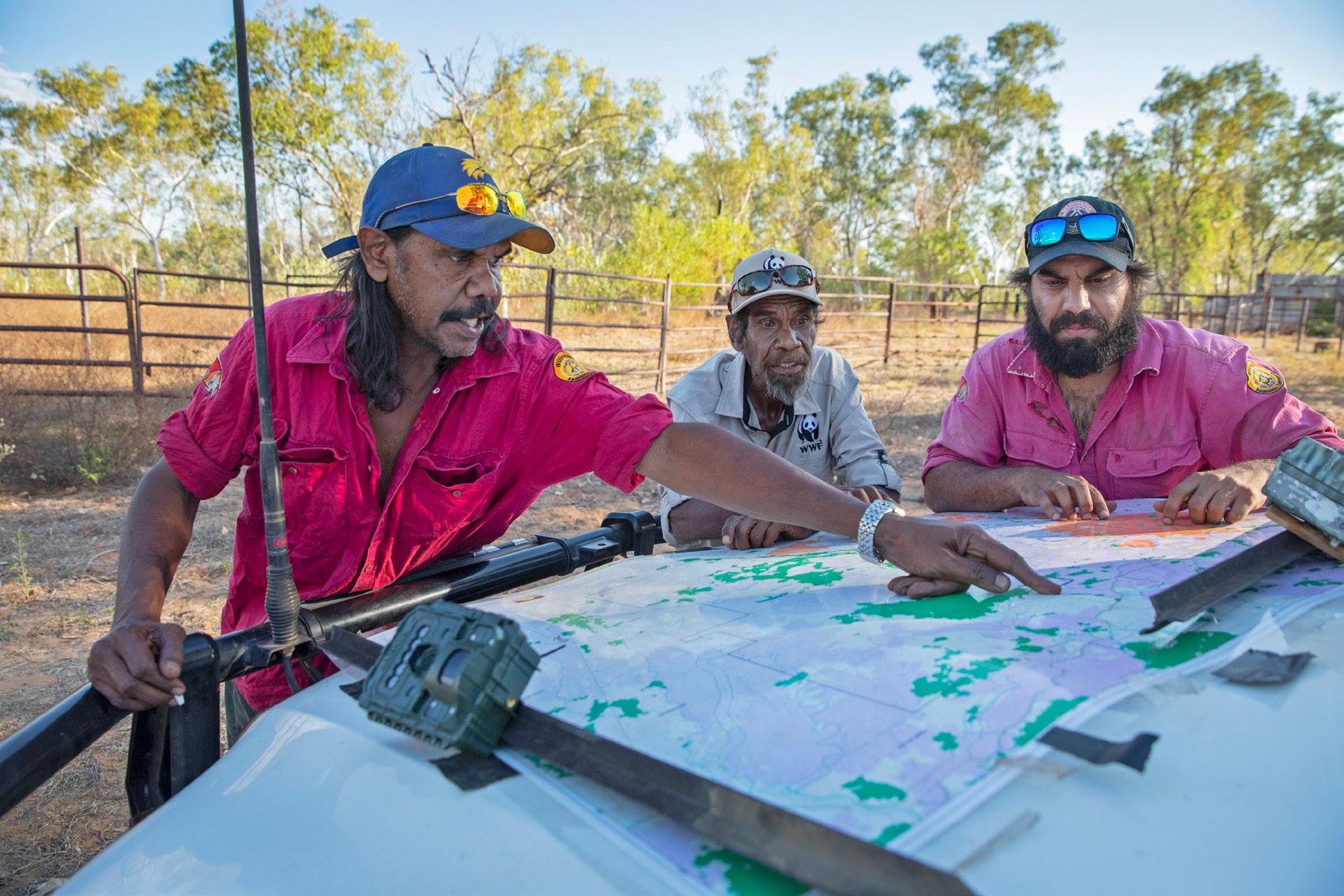
WWF’s vision is to build a world where humans live and prosper in harmony with nature. WWF-Australia believes that supporting First Peoples to continue to care for Country, Saltwater and Sky is integral to this ambition. It is a journey towards showing true respect for their rights, connections, Cultural Authority and Knowledge. WWF-Australia has been working alongside Traditional Owner Groups for over 15 years and is committed to further strengthening Indigenous engagement and empowerment across all of their operations – in conservation programming, leadership and governance frameworks, human resource practices, advocacy, communications, and engagement with partners.
WWF-Australia appointed its firstever Indigenous board member in 2019 and has added four highly qualified national Indigenous leaders as governors of the organisation. The expertise and knowledge of each of these governors are highly valued, and their input into the strategic and business planning was inspirational in helping to redefine their current vision and ambition. It was their influence that led to WWF-Australia’s
new strategy using an Indigenous framework: Sky (climate), Country (land, including freshwater) and Saltwater (oceans).
In developing its new strategy, WWFAustralia undertook a deep listening exercise with communities across Australia. In 2022, the WWF-Australia Board and Executive team visited Girringun Aboriginal Corporation on Girramay Country in North Queensland. This was the first official step in WWF-Australia’s strategic planning process, inviting input from Traditional Owners, communities and rangers to understand the challenges that First Peoples face in caring for Country. Listening to their needs, barriers and goals allowed the organisation to set the foundations for its new strategy, with a co-designed vision for Indigenous engagement and an understanding of ways of working to develop solutions that align with First Peoples’ aspirations and WWF’s vision – in line with WWF’s Environmental and Social Safeguards Framework (ESSF) standard on Stakeholder Engagement.
WWF-Australia also held forums with the business sector, met with state and federal ministers and officials,
and strengthened collaboration with WWF offices across Asia-Pacific. This included an Oceania-wide dialogue between Indigenous communities working on climate change.
WWF-Australia’s new FY2426 Strategic Plan underpins the intent to continue to work with and for Indigenous Peoples and local communities in a meaningful, impactful and transformational way. This intent is articulated through a crosscutting strategic objective that, by 2026, at least 50% of their projects and programmes will be delivered in collaboration with and/or support the sustainable development aspirations of Indigenous peoples and local communities.
WWF-Australia acknowledges the Traditional Owners of the land on which they work, and honour First Peoples’ continuing connection to their lands, waters and culture. They pay their respects to Elders, past and present, and their emerging leaders - in conservation, community and beyond.
48 NATIONAL SUSTAINABILITY SUCCESS STORIES
2024
Healthy Planet, Healthy People Award
The Pimpama River Conservation Area is located on the southern bank of the Pimpama River and borders the Southern Moreton Bay Marine Park and a Ramsar listed wetland.
49 49

OPENAIR: The Operational Network of Air Quality Impact Resources
The Operational Network of Air Quality Impact Resources (OPENAIR) empowers local councils to combat air pollution by providing Australia’s first common method for using low-cost smart sensors to measure air quality.

NSW Department of Planning and Environment, NSW Smart Sensing Network, Australian National University, University of Sydney, Western Sydney University, University of NSW
The World Health Organization considers air pollution a significant environmental threat to public health worldwide.
Website: hesperia.com.au/



51
HEALTHY PLANET, HEALTHY PEOPLE AWARD
WINNER 2024
In a series of workshops, the councils and the project team codesigned best-practice guidelines for council-led air quality monitoring using low-cost environmental sensors. This has informed 64 publicly accessible resources including:
• the OPENAIR Best Practice Guide
• 16 factsheets that summarise key topics
• 34 Best Practice Guide chapters that provide detailed information on specific topics
• 13 supplementary tools and templates for use with the Best Practice Guide
These are available to download on the OPENAIR website at https://openair.org.au
Poor air quality caused by bushfires, wood-fired heaters, agriculture, transportation, industry and urban heat is a significant cause of health problems and premature death in Australian communities.
Following the devastating 201920 Australian bushfire season, when Sydney was enveloped in smoke, the NSW Smart Sensing Network (NSSN) distributed a survey to the state’s local councils, seeking to learn more about their relationship to air quality monitoring. At this stage, there was no national standard for collecting air quality data and no guidance for councils that wanted to collect their own data.
The survey asked councils what air quality issues were of concern to them and what level of understanding and proficiency they had in gathering localised data. The councils’ responses showed they were affected by a range of issues, depending on their context. They also showed that many councils needed a better understanding of available technology and/or the technical know-how required to set up and maintain air monitoring sensors. Something needed to be done.
The OPENAIR project was officially launched in 2022, bringing together a cohort of researchers from five
universities (UTS, University of Sydney, Western Sydney University, University of NSW and Australian National University), industry experts and – most importantly – local councils from across NSW.
The project aimed to make localised air quality measuring accessible to all councils in Australia. Its mission was to develop Australia’s first best practice common method for using low-cost smart sensors to gather data and to build capacity among councils so that they are confident
in deploying and maintaining the sensors and in interpreting the data they collect.
OPENAIR is hinged on close collaboration with councils ¬– as end-users of OPENAIR’s method and resources, their perspective was crucial to the project’s success.
In January 2022, nine councils –Wollongong City Council, Wollondilly Shire Council, City of Orange.
Orange, Lake Macquarie City Council, the City of Parramatta, Sutherland Shire Council, Tweed Shire Council, Muswellbrook Shire Council and Newcastle City Council – signed on to OPENAIR. They each installed low-cost sensors in their local areas and met with the OPENAIR team on a weekly basis to share their experiences – lessons and challenges – and to form a ‘community of practice’ with other councils.
The quality data collected by councils is being shared with the NSW government to support local/ state government collaboration on community air quality issues and to develop new localised air quality reporting and forecasting services.

52
SUCCESS STORIES
NATIONAL SUSTAINABILITY
2024
ACT Government Vulnerable Household Energy Support Scheme
Improving the health and wellbeing of Canberra’s most vulnerable households by delivering targeted home energy upgrades
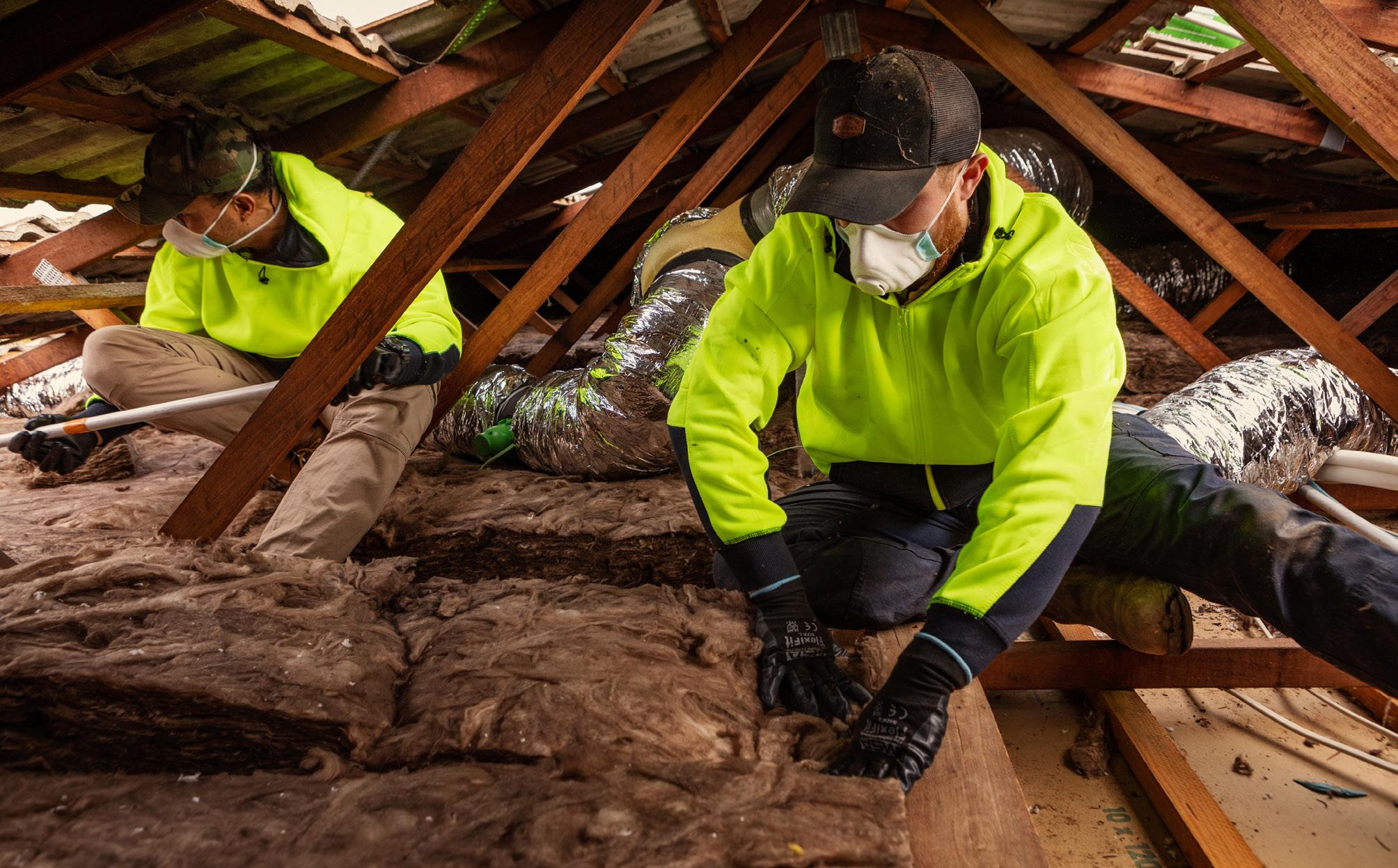
In retirement, long time Canberra resident Don decided the time was right to disconnect his home from gas
Rebates helped with the cost of upgrading his heating, hot water, and stove top to all electric. Thanks to the upgrades he and his wife are enjoying cleaner air quality in their home and lower energy bills.
Website: climatechoices.act.gov.au




53
HEALTHY PLANET, HEALTHY PEOPLE AWARD

The challenge
“We've been here 16 years and we thought ‘well, at some point in time these are going to break down so we might as well get in first before that happens,” said Don.
“We had a gas hot water, heating and cook top and we decided that if we were going to replace them, we might as well upgrade to electric.”
The action
“I’d been thinking about these upgrades for a while and researching the different options. Some of the people in my social tennis group had talked about getting rebates through the Home Energy Support Program. When I looked it up on the internet, I discovered that Pensioners could get up to $2,500 off the very appliances I was thinking about –hot water, heating, and cooktops. I signed up for an online workshop, which is a requirement if you want a rebate. I just put my computer on and watched it while I was having lunch! I got pre-approval for a rebate on the hot water system I’d been looking at. To get pre-approval, I filled in an online form and attached images of the quote for the hot water
system as well as a few other things like my ID and copies of bills. Once the hot water system was installed, I filled out the rebate claim form which just asks for a copy of the paid invoice and details about which bank account you want to get the rebate paid into. We got the induction stove top separately, without a rebate. And for the air conditioning we received a rebate through our energy retailer.”
The benefit
“We love the new appliances. It might have something to do with the fact that I do a lot of the cooking around here. Our best upgrade has been the induction cooking. We love the induction cooking. It's cleaner. It's fast. It will boil a litre of water in 2-1/2 minutes, which I don't think anything else will do that in that time. The air is a lot cleaner in the house for our children and our grandchildren now that we don't have gas. And actually, we feel a bit better because we're not polluting. It’s important to cut down on greenhouse gases.”
“We’ve had no problems at all with the Home Energy Support Program and it’s been a really good process. Sometimes the government can seem a bit slow when it comes to
giving you money back. But not this program – they gave it back within about 10 days.”
“If you’re going to switch from gas to electricity, go for it. It’s one of the best things we’ve ever done.”
“If you’re going to switch from gas to electricity, go for it. It’s one of the best things we’ve ever done.”
54
NATIONAL SUSTAINABILITY SUCCESS STORIES 2024
Farm My School
Imagine if schools could feed their communities … Farm My School builds regenerative farms in schools that nourish, educate and connect communities.
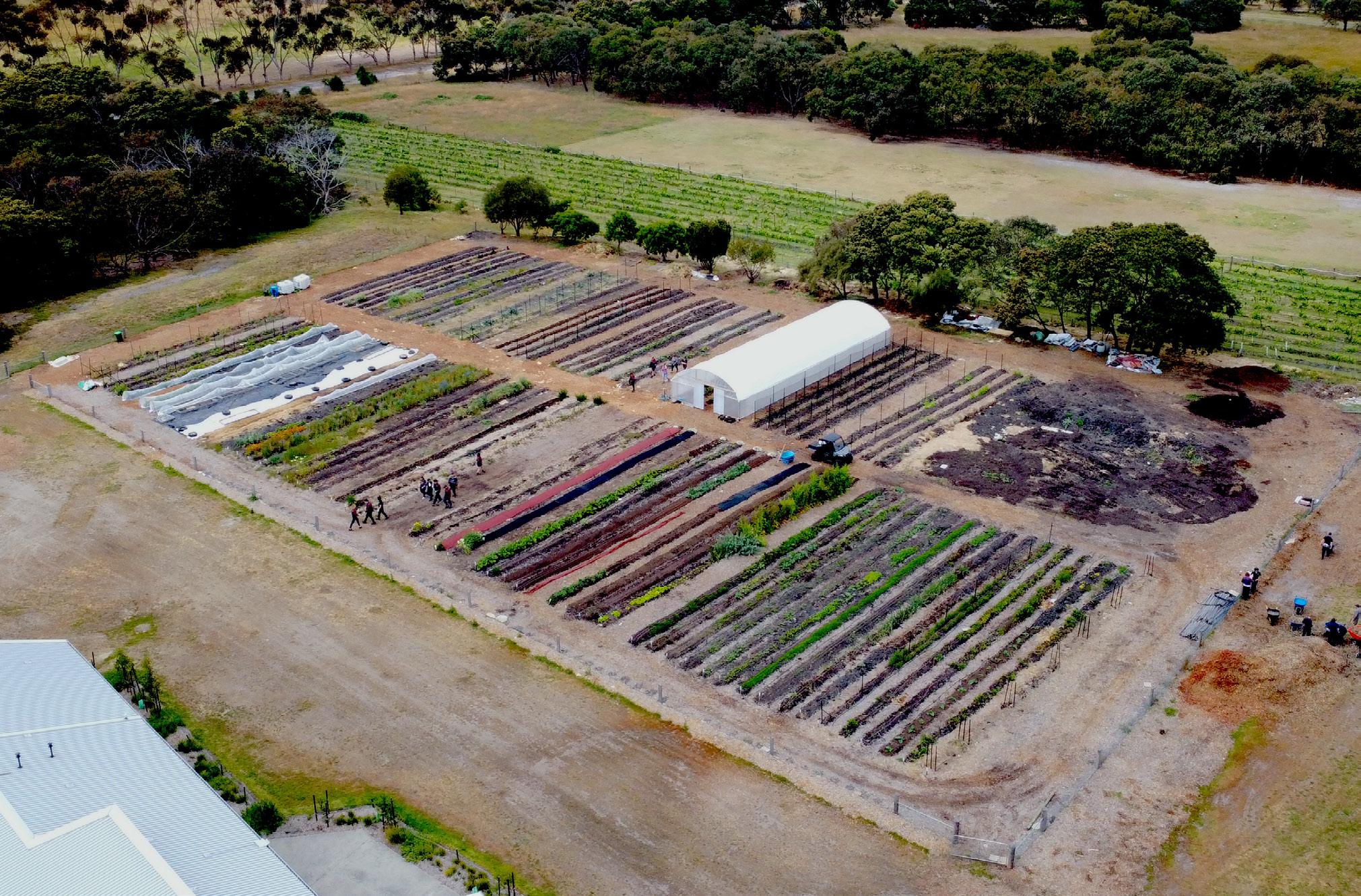
Bellarine Community Health, Bellarine Secondary College, Bendigo Community Bank, Diggers Foundation, Plantfulness.,
Website: farmmyschool.com/home




There is a growing recognition of the need to reorient food systems so that they address food insecurity and environmental degradation. Communities are the key to localising food in an equitable way. Schools provide a unique opportunity to engage children, families and communities in promoting healthy food systems.
55
HEALTHY PLANET, HEALTHY PEOPLE AWARD
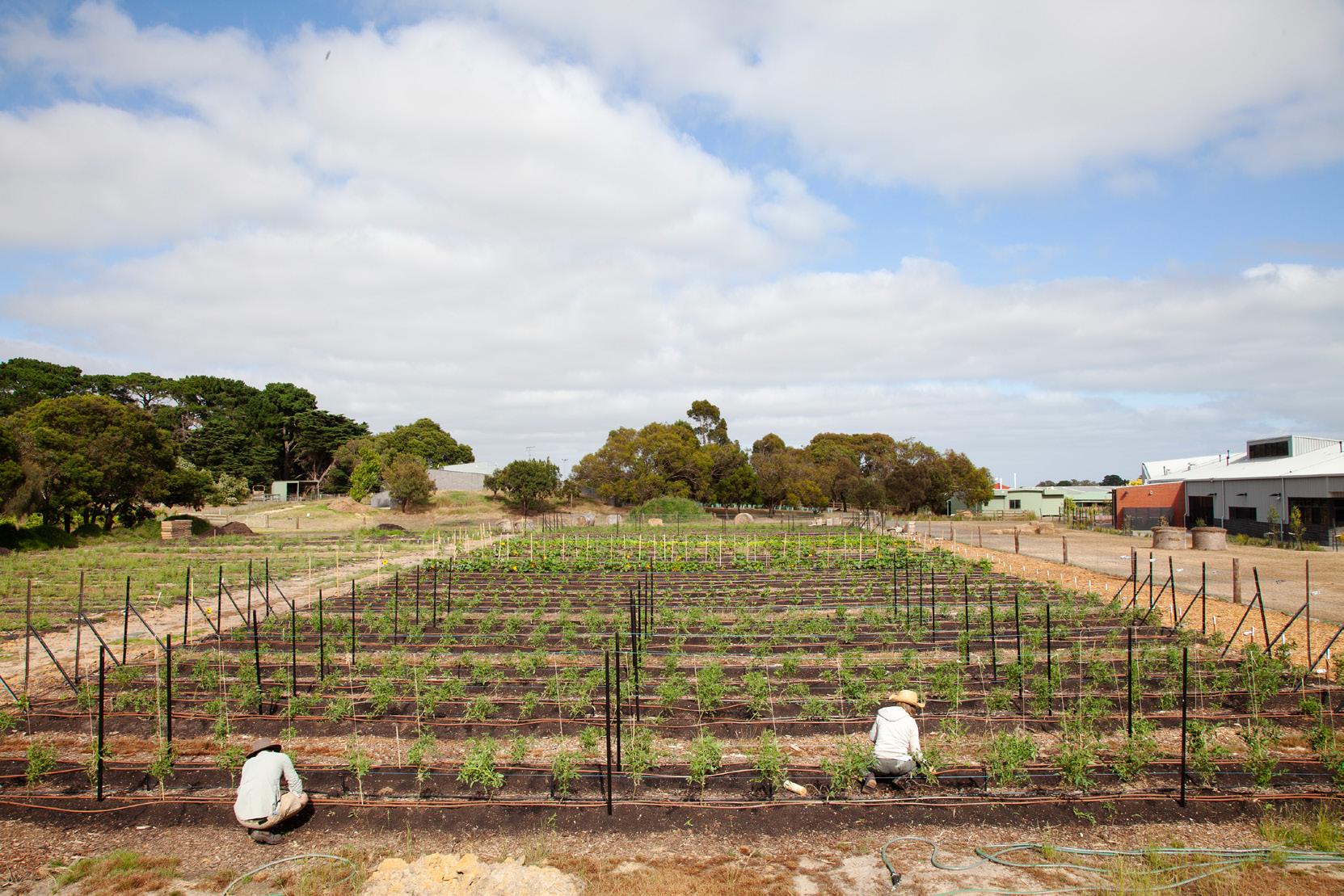
Farm My School is a not-forprofit association, working to transform unused land within schools, into regenerative market gardens providing food to the local community. We work to emphasise partnerships between teachers, students, farmers and community organisations to community food hubs for learning, sharing, and connecting.
Farm My School was born from two mates’ journeys in the food industry who were fed up with the absence and accessibility to local, fresh, nutritious, healthy food in the Geelong Region. The idea to build a farm within a school made perfect sense - kids are our future and the ones that will bear the brunt of climate change. In essence the pair wanted a farm at the heart of a community, nurtured, celebrated and loved by its community, with a hope to inspire others to do the same. The duo were seeking a futurefocussed solution for climate mitigation and looked to schools as having land access that could be
utilised for local food production using regenerative practices. They saw the opportunity to integrate their program with school curricula and engage students in understanding food growing, preparation and waste practices.
The Farm My School team is on track to deliver the first pilot program in the Geelong region, with the vision of scaling up the program into other schools.
Communities are the key to localising food in an equitable way
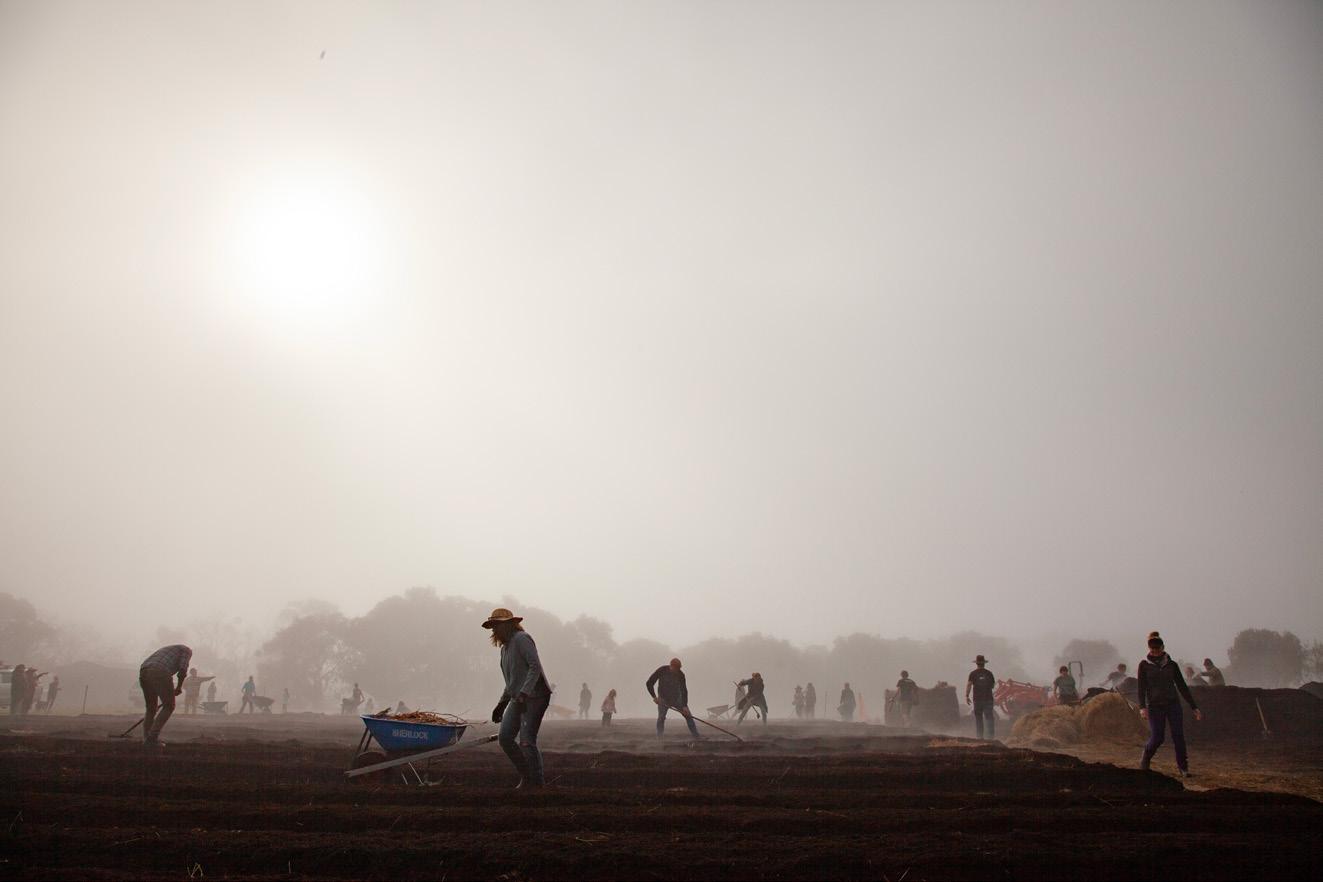
56
NATIONAL SUSTAINABILITY SUCCESS STORIES
2024
My Smart Garden
My Smart Garden is a free sustainable gardening education program to help communities grow their own food, create habitat and shelter, while using water wisely and reducing waste.

Picture a typical Aussie backyard with lawn, shrubs, and a lemon tree. It is watered and mowed regularly, and maintained with purchased fertiliser, mulch, fuel, pesticide and herbicide. Gardens like this are sinks for resources.
Website: mysmartgarden.org.au/








57
HEALTHY PLANET, HEALTHY PEOPLE AWARD
Hobsons Bay City Council, Moonee Valley City Council, Maribyrnong City Council, Brimbank City Council, Wyndham City Council, Stonnington City Council, Merri-bek City Council, Yarra City Council, Glen Eira City Council, Boroondara City Council, Port Phillip City Council
Now imagine a home cocooned by a lush, productive garden. Free, healthy salads and fresh fruit are footsteps away, fed with compost and mulch made from autumn leaves, grass clippings and food scraps. Flowers attract beneficial insects that manage pests. Habitat areas protect wildlife in nestboxes, frog bogs and leaflitter. Rainwater and greywater are retained onsite to drought-proof plants, reduce flash flooding and improve waterway quality. In summer, the house is cooled by deciduous trees and vines, and in winter the garden is cleverly designed to let in the low sun, warming up the home and cutting energy bills. Curious neighbours stop to chat and leave with new recipes, seeds and produce. This is a lived reality for many participants of My Smart Garden (MSG), a free, high quality and accessible sustainable gardening education program. Whether it’s growing all their greens on a rental balcony, or feeding their street from a larger suburban block, the program has successfully supported participants to transform their outdoor spaces into productive, functional gardens and changed their behaviours across five sustainable gardening themes: food, waste, water, shelter and habitat.
The 2022 Program Evaluation showed that since joining the program, participants have started or improved growing fruits or vegetables (78%), recycling food waste (71%), planting trees to shade and shelter their home (38%), and planting native trees and shrubs (45%). The combined efforts of more than 6500 participants have created a sustainability impact conservatively estimated to be at least 3697 m3 green and food waste converted into mulch and compost per year (that’s equivalent to 15400 large wheelie bins!), saving at least 1.2 million litres of potable water per year by using greywater from the shower, bath or laundry (that’s equivalent to 6600 bathtubs!) and avoiding at least 525 tonnes of CO2-e emissions per year by keeping organic waste out of landfill (that’s
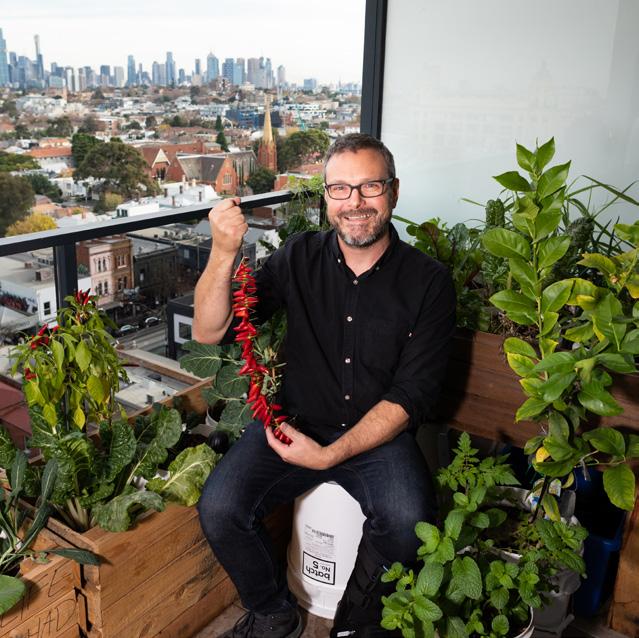
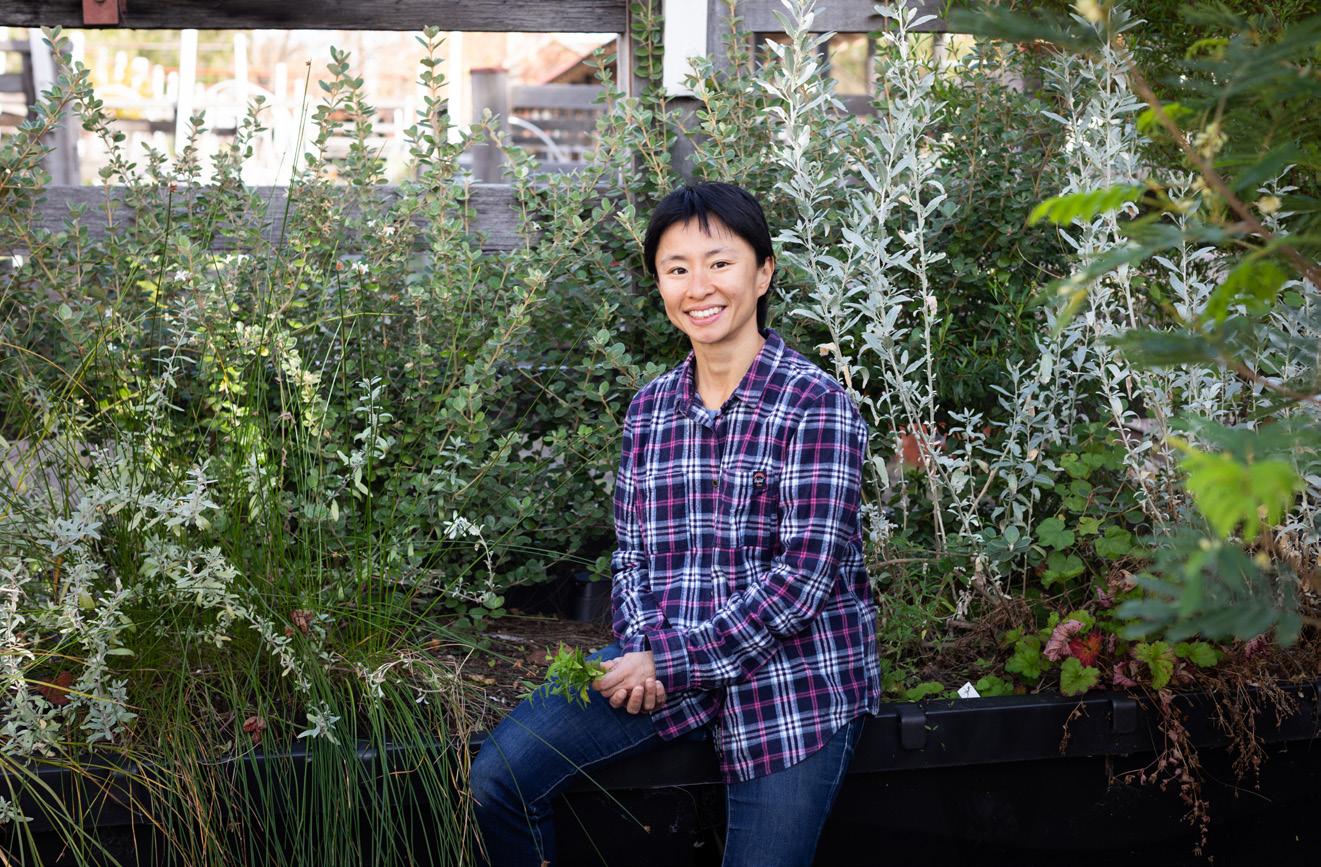
equivalent to driving 2.1 million km!).
Other sustainability practices are also influenced like buying local, cutting food waste, avoiding harsh chemicals and reducing resource consumption.
The program is also improving health and reducing cost of living pressures. Participants reported significant mental health and social connection benefits, especially during stressful times, with 59% feeling more positive since joining My Smart Garden. 89% felt the program was saving them money.
Councils are on the frontline helping communities respond to the convergent crises of climate change, biodiversity collapse, cost-of-living and mental health, but have limited resources and capacity. My Smart Garden leverages community interest
in gardening to tackle multiple issues at once using a model that is efficient, innovative and scalable.
The program is a cross-council collaboration between Hobsons Bay, Moonee Valley, Maribyrnong, Brimbank, Wyndham, Stonnington, Merri-bek, Yarra, Glen Eira, Boroondara and Port Phillip City Councils.
58
NATIONAL SUSTAINABILITY SUCCESS STORIES
2024
SIMPACT — Smart Irrigation Management for Parks and Cool Towns
The SIMPaCT (Smart Irrigation Management for Parks and Cool Towns) project is the first fully autonomous city cooling system that turns green spaces into effective urban air conditioning units.

Western Sydney University, University of Technology Sydney, Monash University, Eratos, HARC, The ARCs Group, CTS, SAPHI, Total Water, Sydney Olympic Park, Sydney Water, NSW Department of Planning and Environment
Website: unsw.edu.au/




The SIMPaCT project developed an autonomous irrigation system that improves climate change resilience of urban communities. The unique capability of SIMPaCT is its ability to manage park irrigation specifically for cooling of air and surface temperatures during hot summer days.
HEALTHY PLANET, HEALTHY PEOPLE AWARD
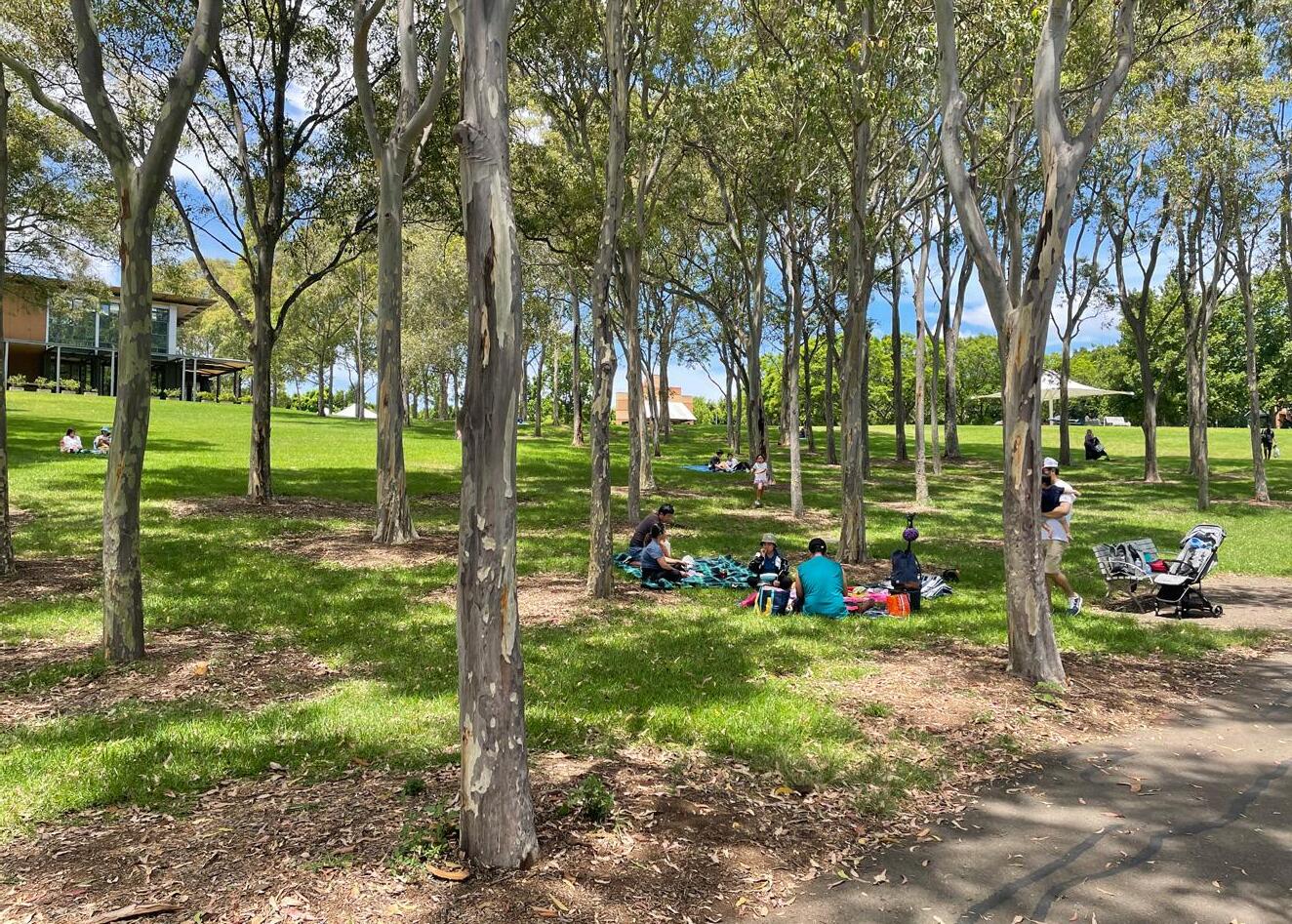
Machine learning algorithms and a digital twin are used to estimate accurate irrigation schedules that maintain optimum health of vegetation and improve water use efficiency at any day of the year.
The absorption of solar radiation, storage, and the subsequent emission of this energy as sensible heat leads to warming of air temperature across our cities, which in turn amplifies the risk of urban overheating and its associated negative impacts on public and ecosystem health, economic activities, services and infrastructure. Urban green infrastructure, like trees, gardens or parks, on the other hand help keeping cities cooler through shading of surfaces and evapotranspiration of water. As global warming leads to dryer and hotter summers, it is necessary to develop new strategies for urban cooling. Research has shown that well-hydrated parks can lower peak daytime air temperatures by up to 7°C and this cool air can travel more than 1 km downwind. Thus, supercharging parks to generate maximum rates of cooling in summer increases human thermal comfort inside and around parks and lowers energy needs of nearby buildings.
SIMPaCT maximises cooling at Bicentennial Park in Sydney Olympic Park using sensors that measure soil moisture, ambient temperature and humidity, wind speed and rainfall.
LoRaWAN and 5G networks collect this real-time data which is ingested by a customised digital platform. The platform houses the digital twin of the park where geo-spatial models and machine learning algorithms continuously evaluate a large number of environmental scenarios to find the optimal irrigation solution for these scenarios. By ‘learning’ over time under which environmental conditions irrigation commands resulted in the ideal soil moisture levels, water use across the park is optimised while maximum air cooling is provided. Using wireless sensors and generating water saving and cooling benefits makes SIMPaCT an ideal solution to effectively address climate change risks for cities. The system is deliberately constructed to easily up- or down-scale, allowing implementation of the SIMPaCT technology in a wide range of irrigation applications under different environmental conditions. The operational and public-facing webbased dashboards, available at www. simpact-australia.com include datarich visualisations allowing users to see current, historical and forecast environmental data. Park managers can easily determine faults and leaks in the irrigation system and visitors can choose the perfect day, time and location for activities in the park.
An autonomous irrigation system that improves climate change resilience of urban communities
The successful development and implementation of SIMPaCT was only possible due to exceptional collaborative efforts. Under the leadership of Western Sydney University, scientists from UTS and Monash University, in partnership with The ARCs Group, Eratos, Centratech, HARC, SAPHI, Total Water, Sydney Olympic Park Authority, the NSW Department of Planning and Environment and Sydney Water, focussed on improving environmental quality, public health, and climate change resilience.

60
NATIONAL SUSTAINABILITY SUCCESS STORIES
2024
61 Large Business Sustainable Leadership Award
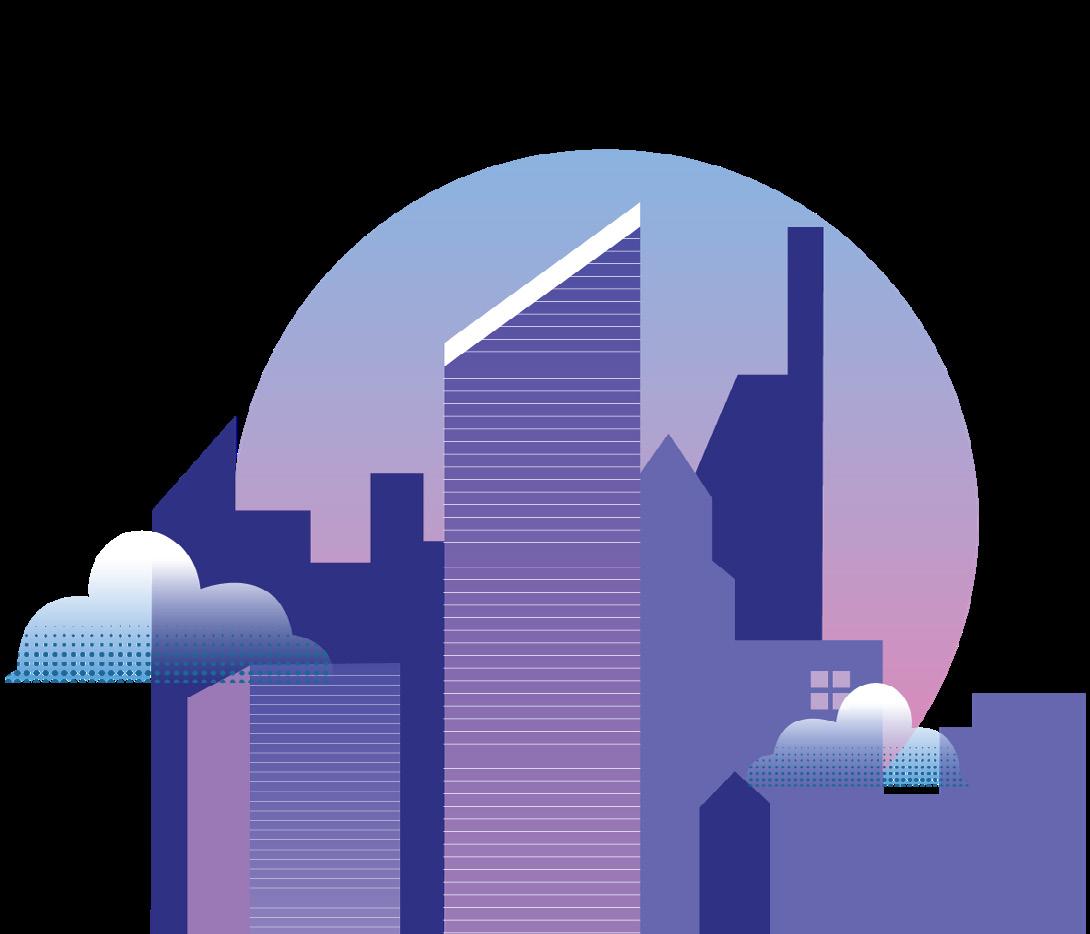
Teachers Mutual Bank Limited (TMBL) has used B Corp Certification to reinvent the whole bank to be ‘Banking for Good for those who do good

With B Corp, TMBL’s Sustainability Strategy has become their Business Strategy. The bank and B Corp are indivisible – the highest order of integration. TMBL has used B Corp not as a ESG scorecard, but to reset the organisation for strategic, competitive advantage.
Teachers Mutual Bank Limited (TMBL) has used B Corp Certification to reinvent the bank to be ‘Banking for Good for those who do good’. Being a B Corp now defines the whole bank, its identity, purpose and strategy and is a better way to articulate what mutual banking is.

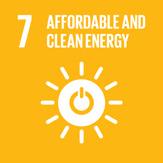




63
LARGE BUSINESS SUSTAINABLE LEADERSHIP AWARD
Teachers Mutual Bank Limited
Website: tmbl.com.au/ WINNER 2024
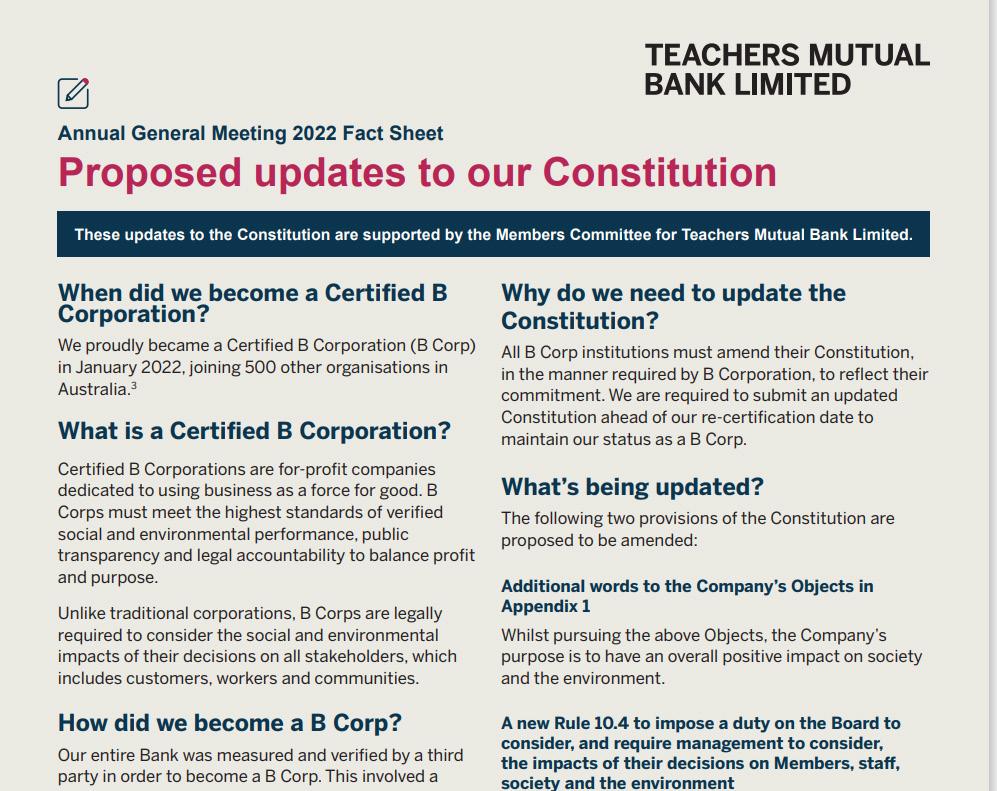
TMBL took two years to complete their Certification and run a long campaign for their 230,000 members to vote to amend the Constitution to insert B Corp wording - a record 91.4% of their members voted yes.
• B Corps represent the future global model for socially responsible companies and especially for mutual banks.
• B Corp Certification is a global high standard of verified social and environmental performance, public transparency, and legal accountability.
• B Corp is a rigorous, verified performance assessment across 5 areas: with a minimum score of 80 points. The B Impact
The only bank named as a Responsible Investment Leader by the RIAA for 3 years in a row
Assessment involved more than 300 scored questions, multiple verification rounds, a series of interviews and extensive data provision. B Corp Certification is holistic, not exclusively focused on a single social or environmental issue.
• Being a B Corp provides independent evidence that profit for purpose is TMBL’s business model and philosophy - the bank is run for people, planet, and profit.
• Being a B Corp means they walk the talk when they say they are a world-leading socially responsible bank
Reinventing the bank to be ‘Banking for Good for those who do good’
• B Corp and Banking for Good provides the umbrella for various social responsibility credentials including:
-$12 billion of Certified Responsible Investment Product by Responsible Investment Association Australasia (RIAA); The only bank named as a Responsible Investment Leader by the RIAA for 3 years in a row. Named One of the World's Most Ethical Companies for ten years in a row. Named Finder Green Bank of the Year 2022, Highly Commended 2023, Finalist 2020 and 2021.

NATIONAL SUSTAINABILITY SUCCESS STORIES 64
2024
Endeavour Energy
Endeavour Energy is accelerating the decarbonisation of the energy sector and making sustainability part of how we do business
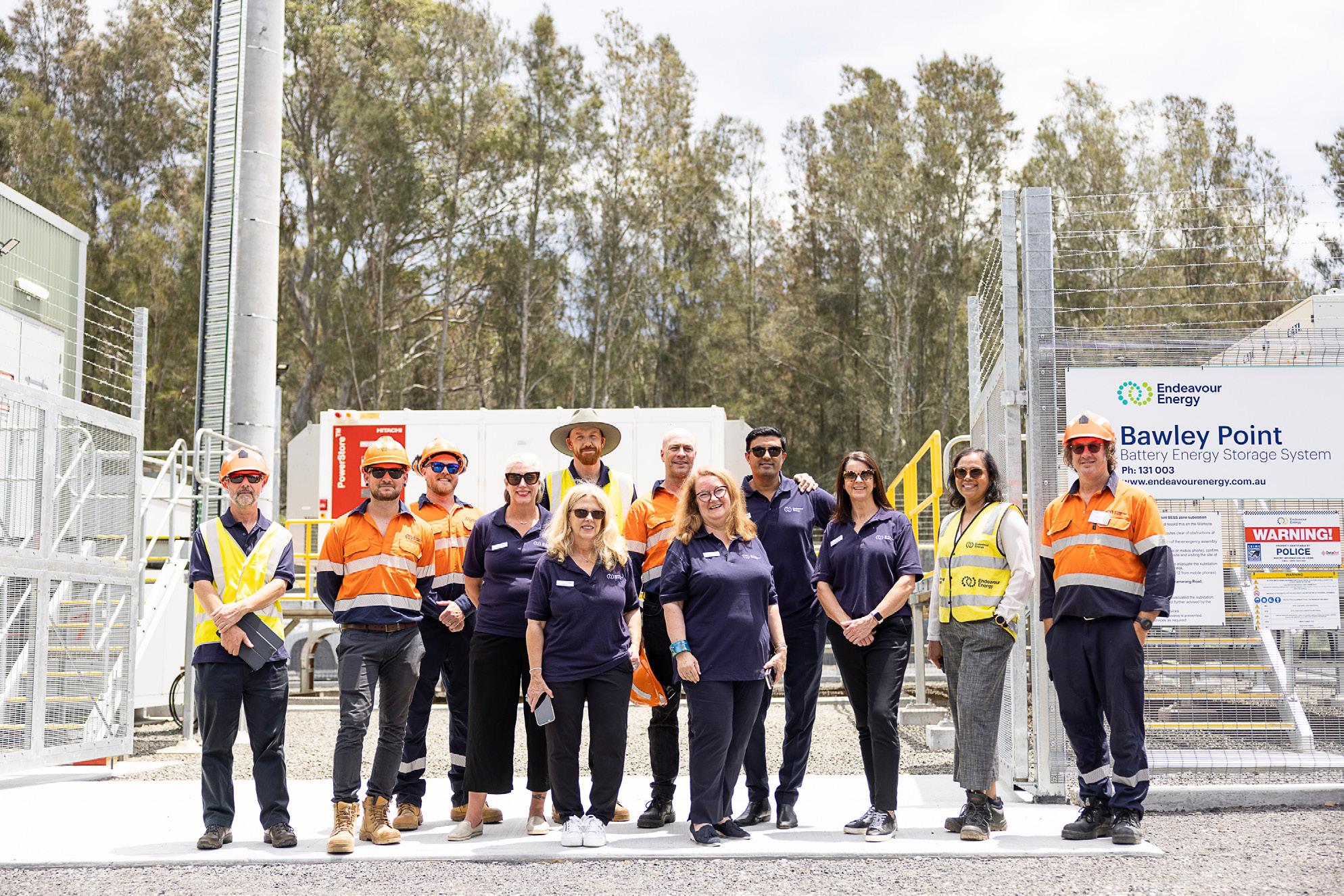
At Bawley Point and Kioloa on the South Coast of NSW, is a groundbreaking project with the launch of the first community microgrid in NSW, in December 2023.
Residents from these two small coastal villages have helped Endeavour Energy co-design a community microgrid on the NSW far South Coast, upturning traditional ways of planning and designing the electricity grid, and helping them to build an energy-resilient community.
Website: endeavourenergy.com.au









65
LARGE BUSINESS SUSTAINABLE LEADERSHIP AWARD
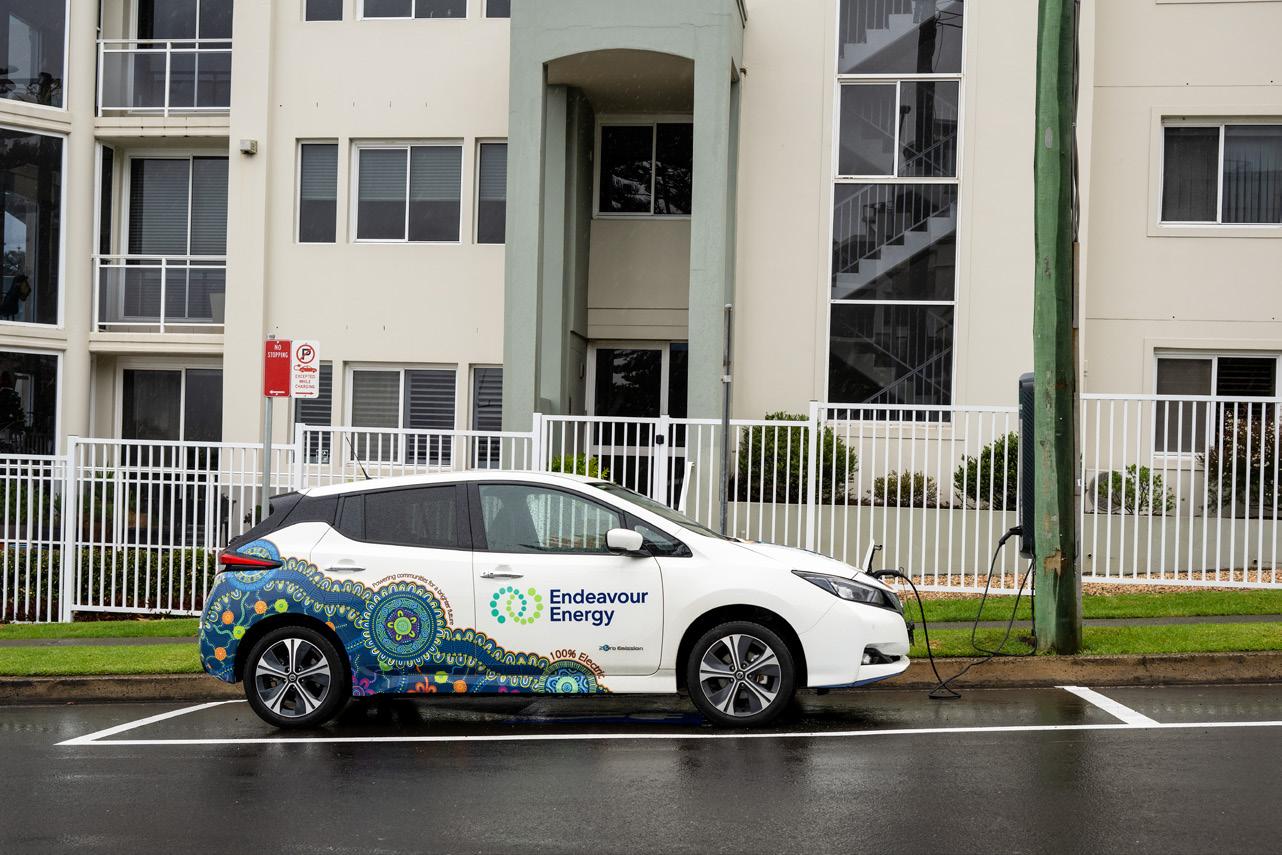
Both villages have endured poor reliability for many years due to storms and bushfires, the community needing a more resilient, reliable and renewable energy supply.
Residents also wanted a cleaner environmental legacy for their grandchildren and supported fresh thinking about how we designed their network.
Together, Endeavour Energy and local residents have co-designed a community microgrid of solar and battery systems, supported by a 3 MW grid connected battery which will operate as an island when there are major network problems.
Revolutionary benefits are expected to flow to the community, including fewer and shorter power interruptions, more choice over how electricity is consumed and reduced risks in times of major storms, fire and other emergencies.
Significantly, the community is also seeking to contribute to sustainable goals around reducing their carbon footprint and being part of a program to build the greater good. This innovation will change the way we design the grid of the future for remote communities.
Upturning traditional ways of planning and designing the electricity grid, and helping build an energy-resilient community
Importantly, it also replaces the need to build a multi-million dollar traditional zone substation.
Other innovations include an upgrade of old street lights to smart LED lighting, and using smart meters to help convert electric hot water systems into mini home batteries.
There is no other community that we know of in NSW that combines a microgrid, smart street lighting and Off Peak Plus to help offset electricity costs, manage peaky demand, and transition homes to a cleaner energy offering.


66 NATIONAL SUSTAINABILITY SUCCESS STORIES
2024
Officeworks
Officeworks makes bigger things happen for Australians through its People and Planet Positive Plan.
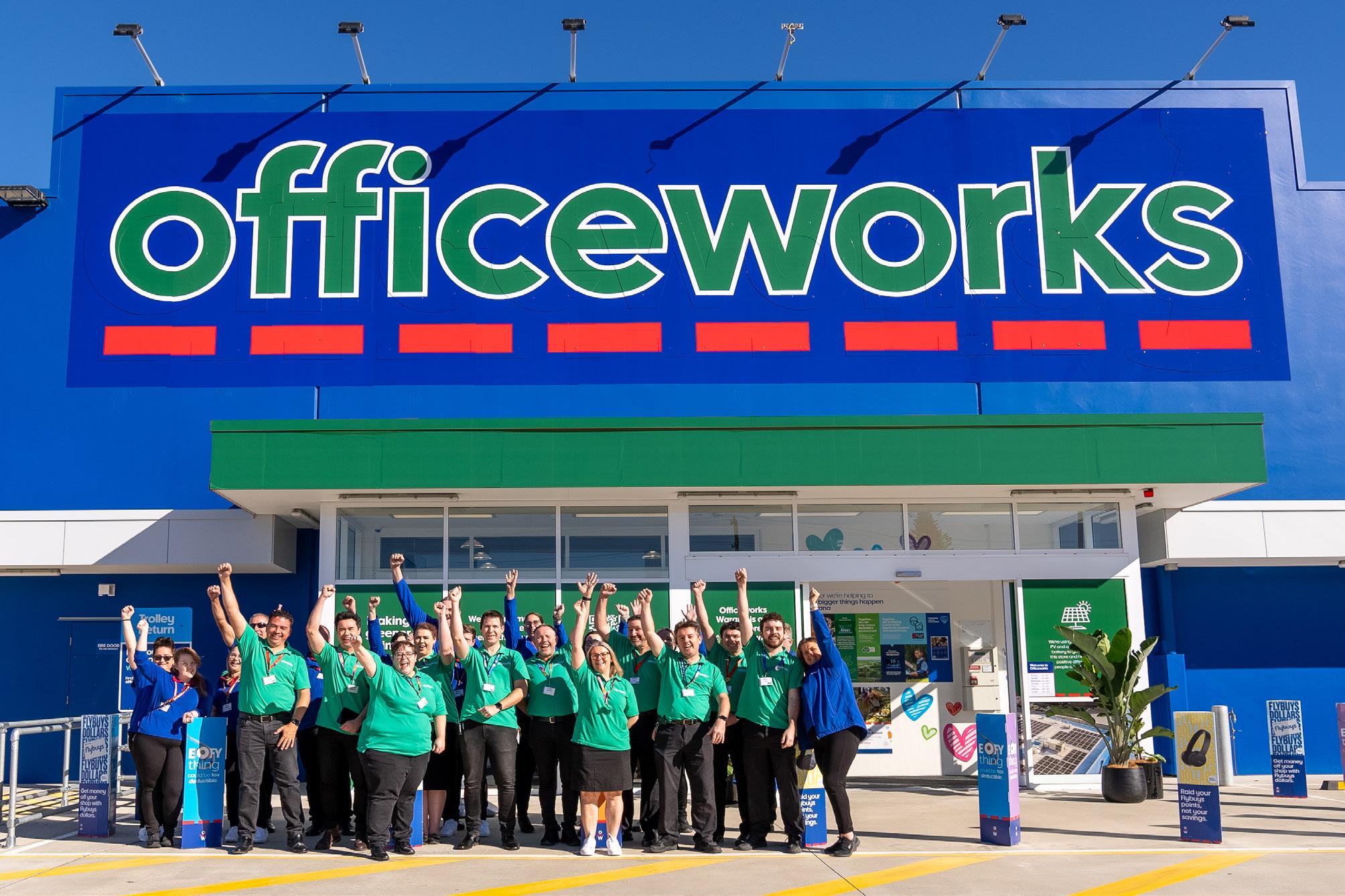
Circonomy, Greening Australia, The Smith Family, The Australian Literacy and Numeracy Foundation, WISE Employment,The Clontarf Academy, The Australian Packaging Covenant Organisation (APCO), Converge Forest Stewardship Council, Sedex, Supply Nation, Moorup Tech Trade, MobileMuster, TechCollect, Envirostream, Close The Loop
We are committed to putting people and the planet at the heart of everything we do.
Our 2025 People and Planet Positive Plan supports us to elevate community involvement, champion climate action, foster a circular economy, and promote sustainable choices for our customers.
Website: officeworks.com.au






67
LARGE BUSINESS SUSTAINABLE LEADERSHIP AWARD

Our current plan, established in 2020, outlines 18 ambitious commitments across six pillars, providing a fiveyear roadmap for our team, suppliers, partners and communities to work towards.
These commitments were developed through extensive stakeholder engagement, helping us to understand the key issues of importance to our team, customers, communities, partners, and shareholders.
In 2023, we reached two of our 18 commitments: hitting our scope 1 and 2 emissions reductions target two years in advance; and surpassing our commitment to support 30,000 Australian students who need it most, having helped 40,000 students to date.
Beyond these achievements, we are committed to continuing to work towards bettering the people around
us and our environment.
Our community has banded together this year to generously raise $5.98 million to support a range of organisations with a strong focus on education, sustainability and biodiversity across the country. Internally, more than 3,600 team members were seconded to another role, promoted or transferred into another opportunity.
We have made substantial strides in our commitment to climate change. We collected more than 10,000 tonnes of retail waste through our Bring it Back program and our partnership with businesses like Circonomy and Moorup. We have also planted 1.45 million trees under our Restoring Australia initiativebringing us closer to our goal of planting two million by 2025.
We opened our lowest emission store in Warana, Queensland, with the

store being the first to be powered by a 100-kWh lithium battery and 100 kW of solar PV. The store has been working towards operating off 100 per cent renewable energy for two years and the installation of the 100kWh lithium battery and the 100 kW of solar PV is the final stage in this plan, alongside our partnership with clean energy provider, CleanCo.
Additionally, we now have long term renewable energy agreements in place in Queensland, Western Australia, South Australia, Northern Territory and Tasmania, with agreements in NSW and Victoria currently being negotiated.
As we look back on our achievements, progress and challenges during FY2023, we remain committed to progressing towards our 2025 commitments and contributing positively to people and the planet along the way. Following the end of our 2025 commitments, we’ll release the roadmap for our future commitments that build on our current targets, with the opportunity to evaluate new goals based on the needs of the business, changes (if any) to SDGs and the priorities of our people and planet.
Our progress towards achieving our People and Planet Positive 2025 Plan would not be possible without the ongoing support of our team members, customers and partners. Through their shared commitment to our goals, we look forward to continuing to deliver on our promise to help make bigger things happen, together.
68
NATIONAL SUSTAINABILITY SUCCESS STORIES 2024
Marketing and Communication for Impact Award
The Pimpama River Conservation Area is located on the southern bank of the Pimpama River and borders the Southern Moreton Bay Marine Park and a Ramsar listed wetland.
69
69

World Wide Fund for Nature Australia — WWF-Australia
Through the Net-Free Reef campaign, WWF-Australia calls on the public to urge the Queensland and Federal governments to end commercial gill net fishing in the Great Barrier Reef - ensuring a healthy and vibrant Reef for all.

The Great Barrier Reef (GBR) is one of the seven natural wonders of the world and a global draw for visitors. The Reef is also one of the planet’s best-known World Heritage Areas - home to some of the most threatened marine wildlife.
Website: wwf.org.au/


Despite this, more than 60% of the Great Barrier Reef World Heritage Area is open to commercial gill net fishing. Invisible nets up to 600 metres in length entrap more than fish – they also entangle and kill countless turtles, sharks, dolphins and dugongs.
71 MARKETING AND COMMUNICATION FOR IMPACT AWARD
WINNER 2024
For years, WWF-Australia has been advocating for the removal of commercial gill nets from the Great Barrier Reef’s waters. In 2016, they took the unusual step of purchasing a commercial gill net licence to ensure it never trapped and drowned another dugong, turtle or dolphin. Thanks to the organisation’s generous supporters from across the globe, they were able to purchase and shelve four commercial gill net licences entitled to fish in Reef’s waters, establishing a 100,000-square-kilometre oasis the size of Tasmania to create an area it called the Net-Free North. WWF-Australia went on to partner with VisionDirect to upcycle 100% of the gill net, turning it into supersustainable sunglasses.
In 2023, WWF-Australia extended its vision and set out to remove all commercial gill nets from the entire Great Barrier Reef World Heritage Area through the Net-Free Reef campaign. In May 2023, WWF began an intensive, public campaign to educate and mobilise people on the damage gill nets cause and gain public support for definitive change.
More than 60% of the Great Barrier Reef World Heritage Area is open to commercial gill net fishing.
The campaign focused on the promotion of positive, solutionsfocused messaging and targeted Queenslanders living in key electorates along the coastline of the Great Barrier Reef - championing the message that ‘A thriving reef = net-free reef’. The campaign tapped into the public’s shared loved for the beautiful Great Barrier Reef, educated people on the benefits of a Net-Free Reef for different communities - both above and below the water - and provided a tangible means of taking action through an online petition form that allowed signees to send personalised letters to their local MPs based on their postcode.
Just one month after the campaign’s launch, WWF-Australia had gathered over 7,000 signatures, made over 4.7 million digital impressions, and 341 mentions in the medialeading to an increased awareness of commercial gill nets and their impact on Australian nature by 4% over a six month period. But the ultimate success of the campaign was demonstrated by the landmark joint decision by the Australian and Queensland governments to phase out commercial gill net fishing across the Great Barrier Reef by mid-2027. This result will protect much more than just our precious marine animals. It will also support the people and communities along Queensland’s coast who rely on a healthy and vibrant Reef. This includes safeguarding over 60,000 jobs and the $6.4 billion tourism industry around the Reef. Most importantly, this result will ensure that future generations can share the privilege we have to experience the awe and wonder of the Reef and be inspired to preserve its health and diversity for many generations to come.

72 NATIONAL SUSTAINABILITY SUCCESS STORIES 2024
Australian Conservation Foundation
Australian Conservation Foundation bulldozes the Opera House to stop Australia’s extinction crisis.

It is a startling fact – every hour in Australia bulldozers destroy the equivalent of 28 Sydney Opera Houses of the homes of koalas and other threatened species. If that’s hard to picture – it’s the same amount of land cleared as eight MCGs, seven Suncorp stadiums, nine Adelaide Ovals, or eight of Perth’s Optus stadium – every single hour. Website: acf.org.au/



73
MARKETING AND COMMUNICATION FOR IMPACT AWARD
Spinach

The Australian Conservation Foundation’s (ACF) Save Our Big Backyard campaign aims to get everyday Australians across the country protecting and restoring nature – and pushing governments and businesses to do the same. The campaign’s goal is to end nature destruction and restore nature to health by the end of the decade.
Over 80% of Australia’s animals and plants are found nowhere else on Earth. However, nature is in crisis in Australia. We have the highest rate of deforestation in the developed world. Since our national environment protection law took effect 23 years ago, more than seven million hectares of threatened species habitat has been destroyed. Australia has the highest rate of mammal extinction globally – even the koala is now endangered across New South Wales, Queensland, and the ACT.
Right now, Australia has a once in a generation opportunity to protect nature. Big business is facing pressure to set nature protection targets, and with new national nature laws being negotiated in 2023 and tabled in the Australian Parliament in 2024, this legislation could be amongst the most significant advances in nature protection in Australia’s recent history. The problem, 2021 research showed only 34% of Australians were aware there is a nature destruction crisis.
Without strong demand and pressure on the government to create strong new laws, there is significant risk that laws will be passed that are too weak to stop logging companies clear-felling forests, agribusiness
from bulldozing critical habitat or preventing polluting coal companies from digging new mines.
To increase Australians awareness and concern about nature destruction and the urgent need for solutions and action, ACF, in partnership with leading creative agency Spinach, launched the Save Our Big Backyard advertising campaign in April 2023 with the aim to reach over 5 million people and to increase national awareness of the extinction crisis from 34 to 36 percent.
Presented via an attentiongetting and thought-provoking visual of the Sydney Opera House being demolished, the campaign highlighted the magnitude of threatened species habitat destruction with unforgettable graphic visual statements and was broadcast across a national TV and multi-channel marketing campaign.
ACF’s Save Our Big Backyard advertising campaign:
• Reached over 12.5 million people nationally in 6 weeks
• Added an additional 4,300 names to ACF’s largest ever petition for strong new nature laws – with over half a million names now calling for action!
• Recruited 27 high profile Australian’s and celebrities to add their name to an open letter for nature and call to stop the destruction, including Cathy Freeman, Nick Cave, Midnight Oil and more.
• Featured on the finale of series 15 of the Gruen Transfer as an impactful and powerful approach.
• Reached hundreds more people via a staff blitz where ACF staff hit the streets across Melbourne, Sydney and Brisbane to talk to passers-by and raise awareness.
Every hour in Australia bulldozers destroy the equivalent of 28 Sydney Opera Houses of the homes of koalas and other threatened species
ACF’s 2023 polling and research showed a national increase in awareness of the extinction crisis from 34 to 37 percent, with the advertising campaign playing a significant role.
74
NATIONAL SUSTAINABILITY SUCCESS STORIES
2024
Australian Refrigeration Council
Each summer the Australian Refrigeration Council runs a national campaign connecting consumers with licensed refrigeration and air conditioning technicians – and more than 120,000 embrace this opportunity to ‘do their bit’ in the fight against global warming

Each summer, when Australians are thinking of air conditioners, the Australian Refrigeration Council (ARC) runs a national marketing campaign encouraging consumers to deal only with licensed technicians, and explaining why this is important for the environment. ARC is the national licensing body for 135,000 refrigeration and air conditioning technicians and the businesses that employ them.





75
lookforthetick.com.au/
Website:
MARKETING AND COMMUNICATION FOR IMPACT AWARD
Digital Deluxe
The key message is ‘look for the tick’ – the ARCtick licensing symbol. Consumers are directed to a business search web page to find the licensed hands-on heroes who protect against global warming every day in their highly skilled work.
ARC uses Google, Facebook, Connected TV and YouTube to deliver the message – and it works! Over the five months of the campaign more than a million people see the message in online advertising. More than 120,000 of them click through to the website where they can find a local ARCtick licensed supplier, and over a full year the total is more than 200,000.
For 2022-23 the campaign sharpened the environmental focus of its existing consumer message. The driving force was to foster an informed desire to help the environment. All-new animated TV commercials enabled the inclusion of Connected TV and YouTube commercials in the mix.
This campaign is one part of how ARC manages the ARCtick licensing scheme on behalf of the Department of Climate Change, Energy, the Environment and Water (DCCEEW). It operates under the Ozone Protection and Synthetic Greenhouse Gas Management Act 1989, which in turn was inspired by the Montreal Protocol. Ultimately, its objective is that every Australian refrigeration and air conditioning technician has the skills and qualifications – and the ARCtick licence – to minimise emissions of ozone depleting substances and synthetic greenhouse gases.
The value of this work – including the marketing campaign – is significant. Over its 18 years, ARCtick licensing has contributed to 24.37 megatonnes of CO2-e direct emissions savings, and supported the recovery and destruction of 5,000 tonnes of ozonedepleting refrigerants.
For 2023-34 the campaign added a ‘what you can see you can be’ gender equity element. In the real world this is a male-dominated trade, but more
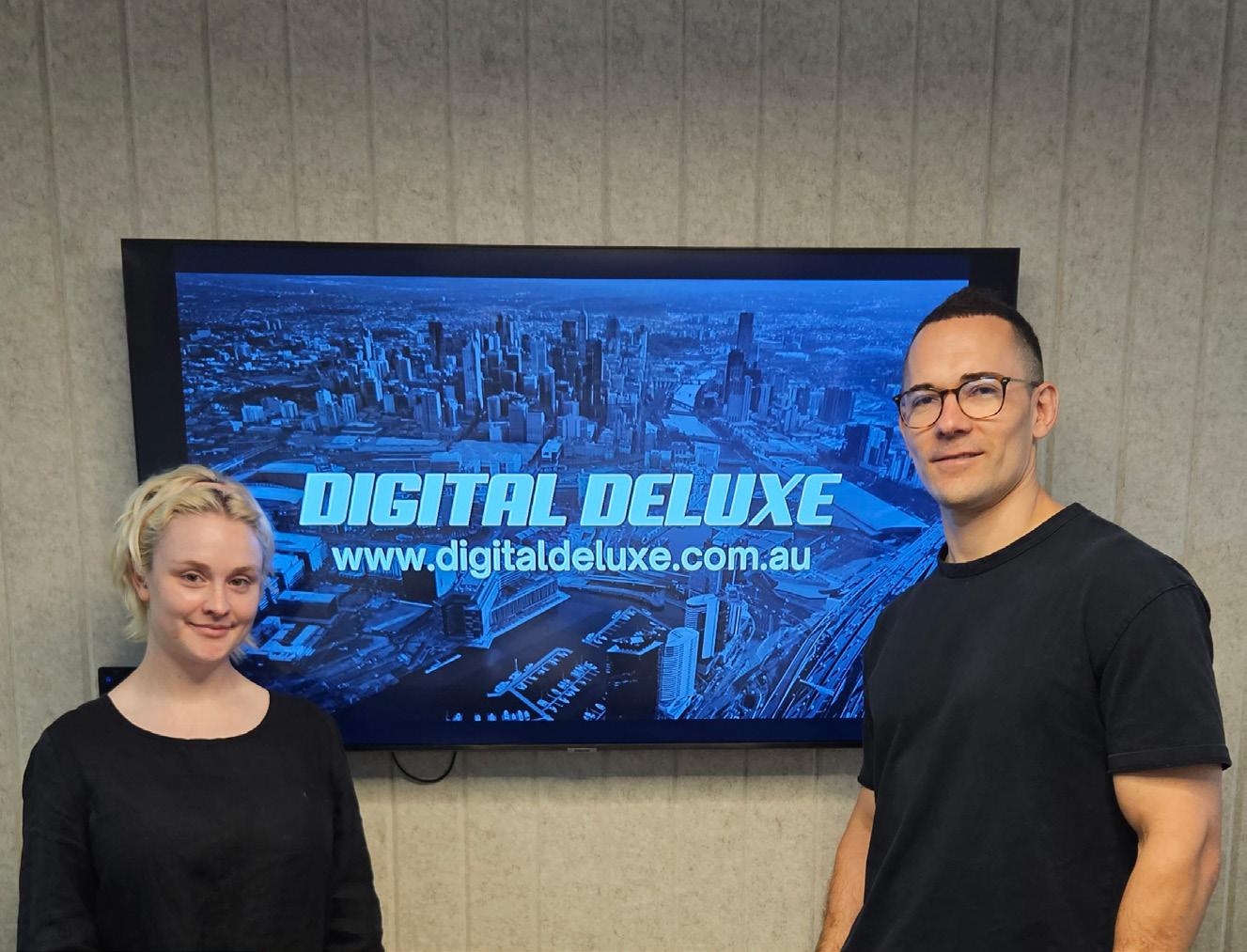
than 25% of the campaign ads now feature a female technician. This was partly inspired by the remarkable Jennah Halley, Australia’s Apprentice of the Year for 2023, a mother of four who chose refrigeration and air conditioning as a career and made it literally to the top of her class.
ARC’s marketing agency Digital Deluxe monitors the campaign daily to fine-tune it, with the result that more than a million people saw the ‘look for the tick’ static and TV ads. YouTube and Connected TV contributed a quarter of a million to that total. One unexpected metric was an 80% male skew in the audience, which will influence future campaigns.
Each year the campaign builds awareness of the ARCtick licensing scheme. As the world at large comes to acknowledge global warming, this offers consumers a practical way to ‘do their bit’ to reduce it – and 120,000 each summer click through to find out how.
The national licensing body for 135,000 refrigeration and air conditioning technicians and the businesses that employ them
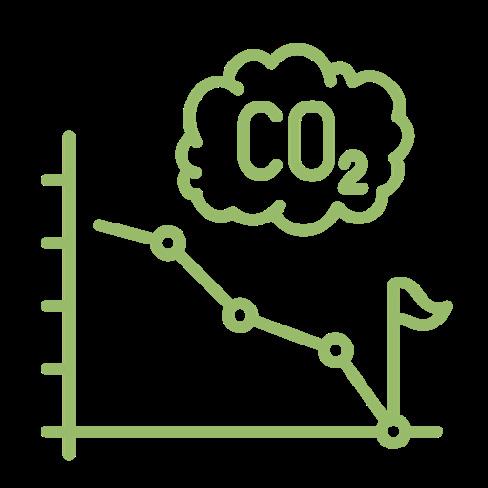
76 NATIONAL SUSTAINABILITY SUCCESS STORIES
2024
Plico
Plico: the perfect storm, changing Australia’s energy future

As the climate continues to warm and average temperatures increase, power usage is surging and so is the cost of electricity. We have been warned to brace for savage hikes in the cost of living. Many of these increases are beyond a household’s control. Except one. The cost of electricity.
Clean energy company, Plico has turned up the heat with a marketing approach designed to disrupt the solar industry and help educate households on the importance of including a battery with solar.
Website: plicoenergy.com.au/



77
MARKETING AND COMMUNICATION FOR IMPACT AWARD

According to Plico research, the data identified a series of marketing challenges to successfully transition households to clean energy, with the main challenge being affordability. If given a choice, households want to use renewable energy, although affordability to enter the market has been challenging for many. Plico knew that disrupting the market while addressing these challenges was fundamental to help people transition to a clean energy solution – that is trusted and affordable.
Plico’s vision is to make solar affordable and accessible for all Australians. With Plico’s unique business model, households can now control how they generate, store and use electricity & through a new payment (subscription) model, which is affordable rather than traditionally paying huge upfront hardware / installation fees.
As with any first market entrant introducing a new business model, Plico recognised they had a significant marketing job ahead - to educate on why, without a battery, solar panels only do half the job, and to present a new way of trusted affordability. Through evidencebased marketing as a challenger brand, Plico is helping homeowners navigate their way through the solar and battery decision.
Using a range of marketing approaches, creativity and channels,
Plico successfully broke the mold of the industry sameness and clutter to build a successful business while helping homes transition to clean energy.
Achieving results well beyond expectations, Plico’s marketing has certainly hit the spot for consumers addressing both sustainability and affordability requirements. Marketing intelligence is at the core of Plico’s growth plan including further accelerated expansion into the East Coast of Australia.
The big picture according to CEO, Mr Robbie Campbell is that Plico makes clean energy accessible to every household. “To do this smart marketing is fundamental to changing perceptions and introducing a different way of approaching solar and battery. The more successful we are as a business; the more households will reduce their carbon footprint, and we will get closer to Australia’s New Zero targets.”

78 NATIONAL SUSTAINABILITY SUCCESS STORIES
2024
Nature Positive Award
79

Vic Catchments
Victoria’s ten Catchment Management Authorities have been changemakers for catchments for over 25 years, working with Traditional Owners, community, government and stakeholders to improve the health of waterways while maintaining biodiversity across Victoria’s diverse landscapes.

Caring for catchments is a team effort.
Victoria’s ten catchment management authorities (CMA) achieve an enormous amount for Victoria’s waterways, catchments and communities through their solid, established partnerships, trusted networks and hard work.
This is a team who, in 2022-23, engaged with 95,000 people across Victoria - a number that would fill Melbourne Cricket Ground with passionate catchment supporters!















81
NATURE POSITIVE AWARD Website:
WINNER 2024
viccatchments.com.au/
From cultural burns to fishway construction, CMAs lead innovative efforts for ecological preservation

At the heart of CMAs is a strong commitment to Traditional Owner engagement, access to water rights and supporting self-determination. These long-standing relationships are a treasured part of the authorities and part of everything they do.
In the state’s north, Wimmera CMA is partnering with Barengi Gadjin Land Council to enhance the cultural and environmental values of Ranch Billabong near Dimboola. In Glenelg Hopkins catchment, the CMA supports Gunditj Mirring Traditional Owners in cultural burns to protect South-eastern Redtailed Black Cockatoo feeding areas.
As well as getting on with jobs at hand, CMAs are equally forward thinking, adaptable and resilient to change and well positioned to meet future challenges. In East Gippsland, where one million hectares were burnt in the Black Saturday fires, Friends of the Upper Nicholson Catchment worked with the CMA to assist in fire recovery through revegetation to improve and reconnect habitat.
In the north, following widespread flooding in 2022, the CMA partnered with local councils to launch a Community Flood Intelligence Portal to help communities better plan for floods.
CMAs are reconnecting rivers with a new fishway planned for the Macalister River in West Gippsland and one recently opened in Buchan in East Gippsland.
Catchments are for everyone to enjoy and the Merri Connection Project, a collaborative effort between Glenelg Hopkins CMA and Warrnambool City Council, enhances community access to the Merri River with an All-abilities Kayak Launch and pathways.
Healthy waterways help vulnerable Platypus. Critically endangered frogs, birds and mammals benefit from healthier catchments and community and volunteer involvement.
After ongoing decline in the last 30 years, the Platypus was listed as Vulnerable in Victoria under the Flora and Fauna Guarantee Act 1988 in 2021. CMAs are supporting Platypus through waterway and riverbank restoration and revegetation projects. Once planting along the banks is established, it works with instream structures to reduce sediment runoff into the river. This improves water quality and provides habitat for land animals, food for water creatures and shades the water, helping control water temperature. As this vegetation matures, it will also provide a natural habitat for the waterway as it falls into the water.
This project has been undertaken across Victoria with habitat installation works occurring in Glenelg Hopkins CMA, North East CMA and East Gippsland CMA, together with monitoring works in most Victorian catchment areas.
Across the state, Platypus protection works have included:
• Annual monitoring activities
• Installation of instream habitat
• Riparian vegetation works
• Installation of Platycam
Public awareness of these activities has occurred with the involvement of primary school students and community groups in revegetation and citizen science aspects of the projects, together with the world-first launch of Platycam, a livestream of Platypus in the wild.
Platypus thrive with community involvement: habitat restoration, Platycam, and annual monitoring safeguard their future
82 NATIONAL SUSTAINABILITY SUCCESS STORIES
2024
Learning on Country Program
The LoC program is creating a pathway for the future generation of Aboriginal Rangers and traditional custodians, who will be charged with safeguarding, protecting and preserving our natural environment.

LoC is a formal educational model operating in 17 Northern Territory remote communities which integrates the secondary curriculum with ‘on country’ cultural education and activities. Spearheaded by the late Dr M. Yunupingu, the Program has evolved into one of Australia's most successful ‘two-ways’ learning initiatives, fostering collaboration between Indigenous Rangers, educators, and students.
The Learning on Country (LoC) Program is developing the next generation of Aboriginal rangers to care for land and sea country, drawing on both traditional knowledge handed down by Elders, combined with western knowledge acquired through formal training and accreditation.
Website: learningoncountry.com/









83
NATURE POSITIVE AWARD
Indigenous students become stewards of land and sea, safeguarding biodiversity and cultural heritage through hands-on learning
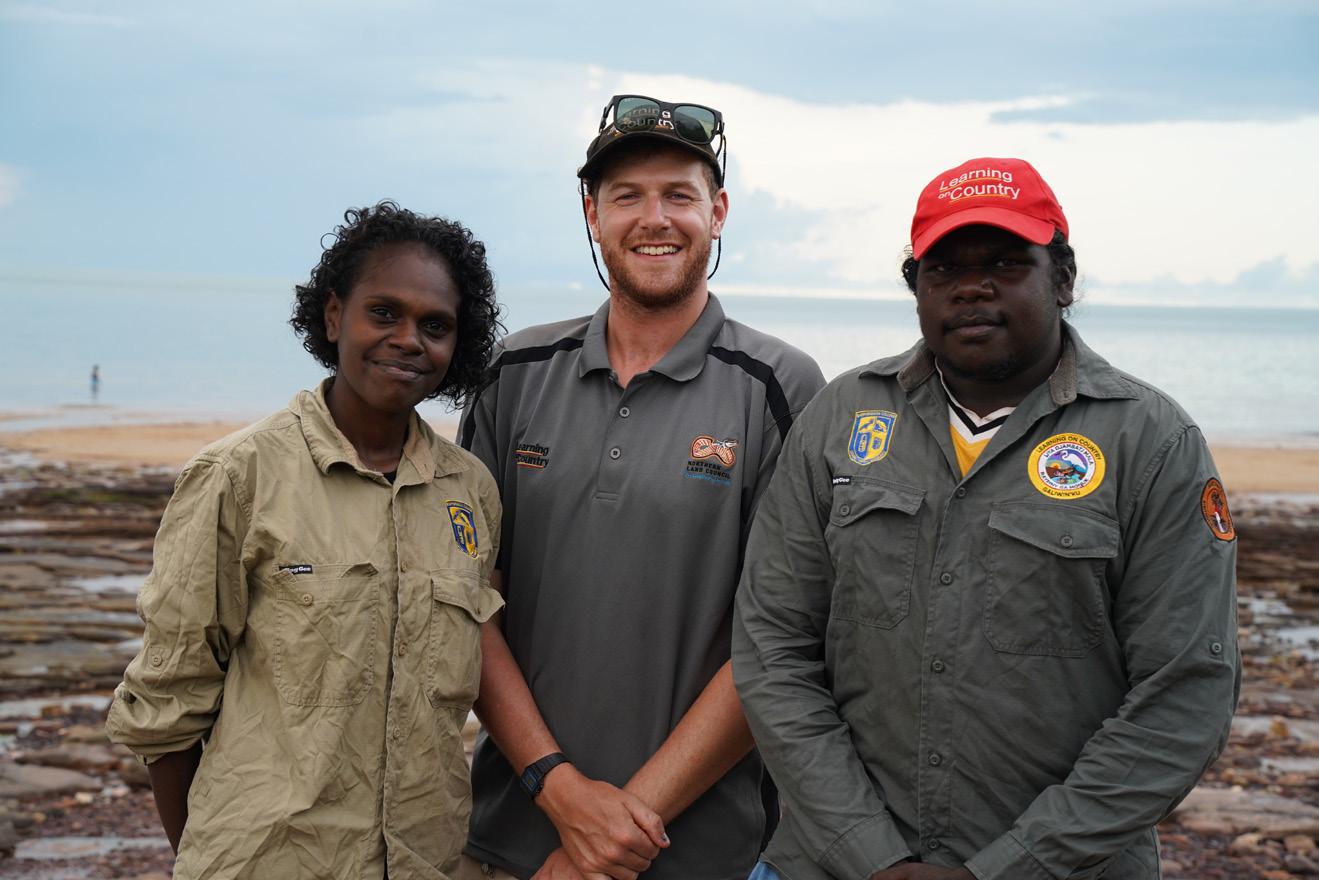
This ‘two toolbox approach’ incorporates both western and Indigenous knowledge systems to deliver culturally appropriate education and training for remote students’ learning and opens up employment pathways, most notably to the Indigenous Ranger programs. LoC activities are diverse and reflect the local community partnerships; these can include day trips, cultural camps, and even interstate exchanges.
Some examples of LoC Program ‘on country’ activities include:
• Bio-diversity surveys
• Bio-security monitoring
• Sea country patrols
• Marine bio-diversity management
• Ghost net and marine debris removal
• Feral animal control and monitoring
• Weed control
• Fire management
• Protection of cultural and sacred sites
• Visitor and recreation management
The LoC Program is creating a pathway for the future generation of Indigenous Rangers and traditional custodians, who will be charged with safeguarding, protecting and preserving our natural environment. Armed with cultural knowledge, connection to country and access to employment opportunities, LoC students will be the future front line in safeguarding and protecting Australia’s natural environment, on land and sea.
Traditional ways of managing land and sea are interwoven into modern land management practices, and tools and technologies, which delivers a culturally and environmentally considered approach to land and sea management, species protection and managing the environmental impacts of climate change.
The LoC Program is creating the next generations of Rangers and Traditional Custodians who will play a key role in caring for country, including how native bush is managed, species protection and biodiversity, monitoring and recording, as well as preservation of sacred sites and areas of cultural significance.
The Program is both an incubator and succession planning solution for various industry sectors involved in the sustainable use of land, sea and conservation management, such as mining, pastoralism, forestry, tourism, fisheries, aquaculture, horticulture, wildlife utilisation and biosecurity.
The Program enjoys strong community and institutional support because it brings together two knowledge systems that link culture and curriculum, and because ownership of the LoC Program is community based and Aboriginal led. Since its establishment in 2013, schools have been actively collaborating with Traditional Owners, Indigenous Rangers and associated land and sea management groups to provide educational and hands on learning and training experiences for Aboriginal students, with a focus on land and sea management. Program partnerships extend to include community development practitioners, educators, community stakeholders, government and nongovernment organisations, training organisations in the NT, as well as academic organisations and sponsors from various economic sectors, forming a network of both external and internal partnerships.
Through these partnerships, Aboriginal students are working with Rangers and Traditional Owners around conservation and environmental protection, habitat restoration and species protection. On country hands-on learning and school-based learning activities are linked directly to NT Certificate of Education and Training, Australian Curriculum and VET Certificate outcomes.
NATIONAL SUSTAINABILITY SUCCESS STORIES 84
2024
The Mulloon Institute
Biodiversity benefits as the Mulloon Institute rehydrates and restores agricultural landscapes
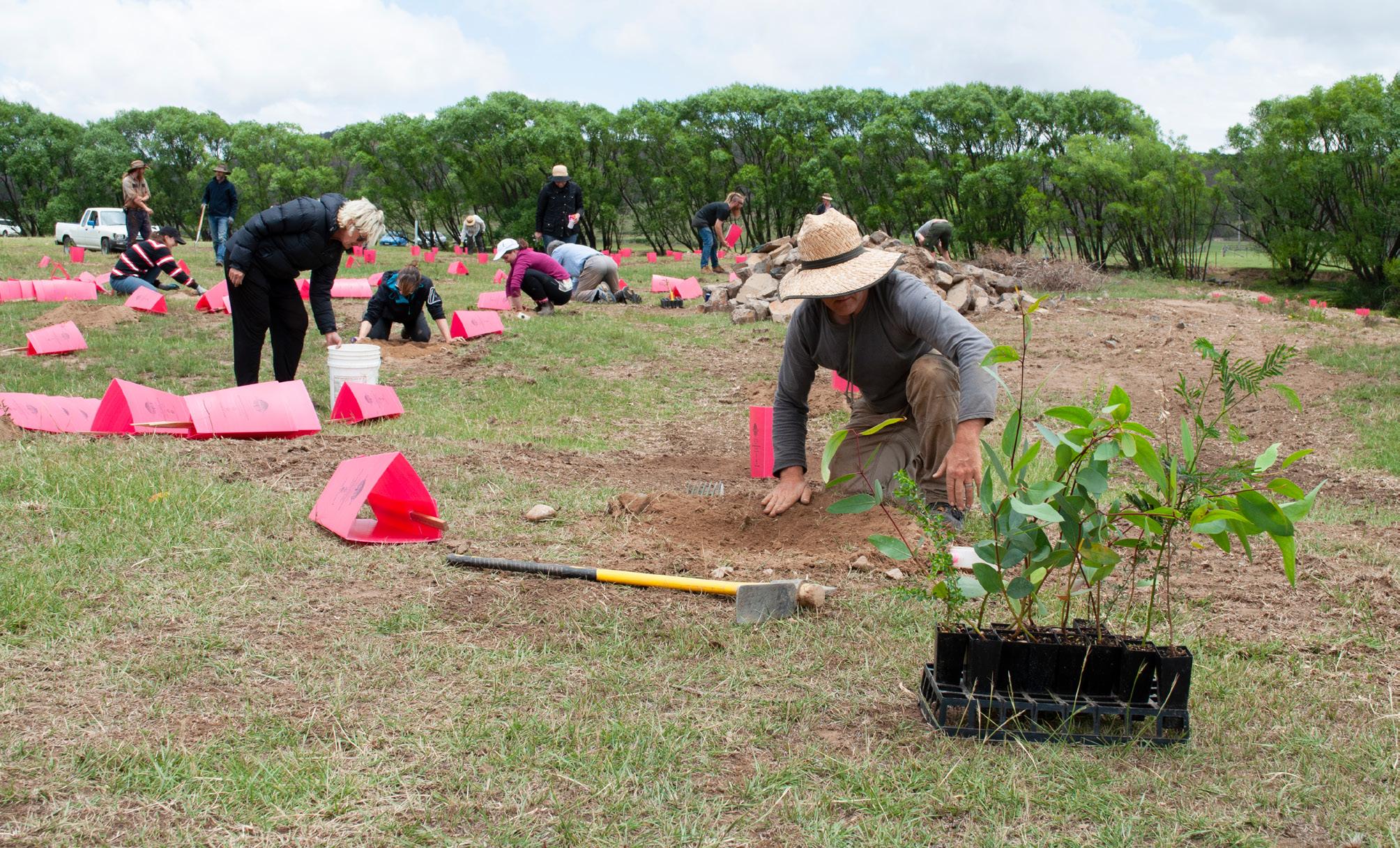
The Mulloon Rehydration Initiative (MRI) aims to rehabilitate and rehydrate the Mulloon catchment in southern New South Wales and turn a highly eroded creek into a healthy, vibrant ecosystem capturing flood sediments, recycling nutrients and providing valuable habitat.
The wider catchment will also see improvements in water quality, water yield, and enhanced biodiversity from tackling soil erosion, habitat fragmentation and weed proliferation. The project spans 23,000 hectares and 50 kms of creek and tributaries and involves 23 landholders and is being rolled out in five stages between 2019 and 2024.
Website: themullooninstitute.org/




85
NATURE POSITIVE AWARD

Originally, Mulloon Creek was a slow moving, braided chain of ponds that provided important habitat for native flora and fauna and was a reliable food source for local Aboriginal people. With the arrival of agriculture, land clearing and extensive grazing began transforming the creek into a fast moving, highly eroded and continuous, single-channel stream surrounded by a dehydrating landscape.
The MRI focuses on creek repair and erosion control using small interventions to slow and filter water flow, preventing further erosion and rebuilding soil health. Interventions are made using natural materials such as rocks and logs and are complimented by holistic agricultural and landscape management practices, including sustainable grazing, slope stabilisation and contouring.
So far, 60 creek structures have been installed across five properties along a 20 km stretch of Mulloon Creek. Over the coming stages of the project, a further 60 structures will be built over another 30 km of the creek. Around 40,000 trees, shrubs, sedges, grasses, groundcovers and wetland plants have been planted, transplanted and naturally regenerated. Sections of the creek have been fenced off from livestock and kangaroos and, with the weirs now in place, the water flow is gentle and spreading with newly formed ponds bursting with plant and animal life.
By helping rebuild the function and resilience of Mulloon Creek, its riparian corridor, tributaries, floodplains, wetlands, hills and woodlands, the project is also supporting several threatened and vulnerable species, including the Scarlet Robin, Diamond Firetail, and Dusky Wood Swallow. Other species being reintroduced to the area by Taronga Zoo include the locally extinct Yellow-spotted Bell Frog while the floodplain has been assessed as a potential site for future translocations of the Green and Golden Bell Frog.
The MRI has won various awards including: the Conservation Landscape category, National Heritage Trust (NSW) Awards (2020); and the Response to Climate Change category, Australian Sustainable Communities Awards (2020).
Various State funding has supported the MRI: to improve water quality in Mulloon Creek;
to benchmark biodiversity (fish, aquatic invertebrates, soils mapping, vegetation and stream); to restore the Mulloon catchment and protect its ecosystems; to improve creek condition and function (habitat quality, water quality and flow); to improve habitat connectivity. Federal funding has been received to improve and monitor the resilience and ecological connectivity of threatened species habitat along the Mulloon Creek corridor; to recreate frog habitat in the Mulloon catchment; and to conduct comprehensive planning and scientific evaluation of hydrology, flora and fauna.

86 NATIONAL SUSTAINABILITY SUCCESS STORIES
2024
The Wheen Bee Foundation
The Wheen Bee Foundation is a not-for-profit charity dedicated to supporting research, encouraging practice change and raising awareness of the importance of bees and other pollinators and their critical role in ecosystem health, biodiversity and food security
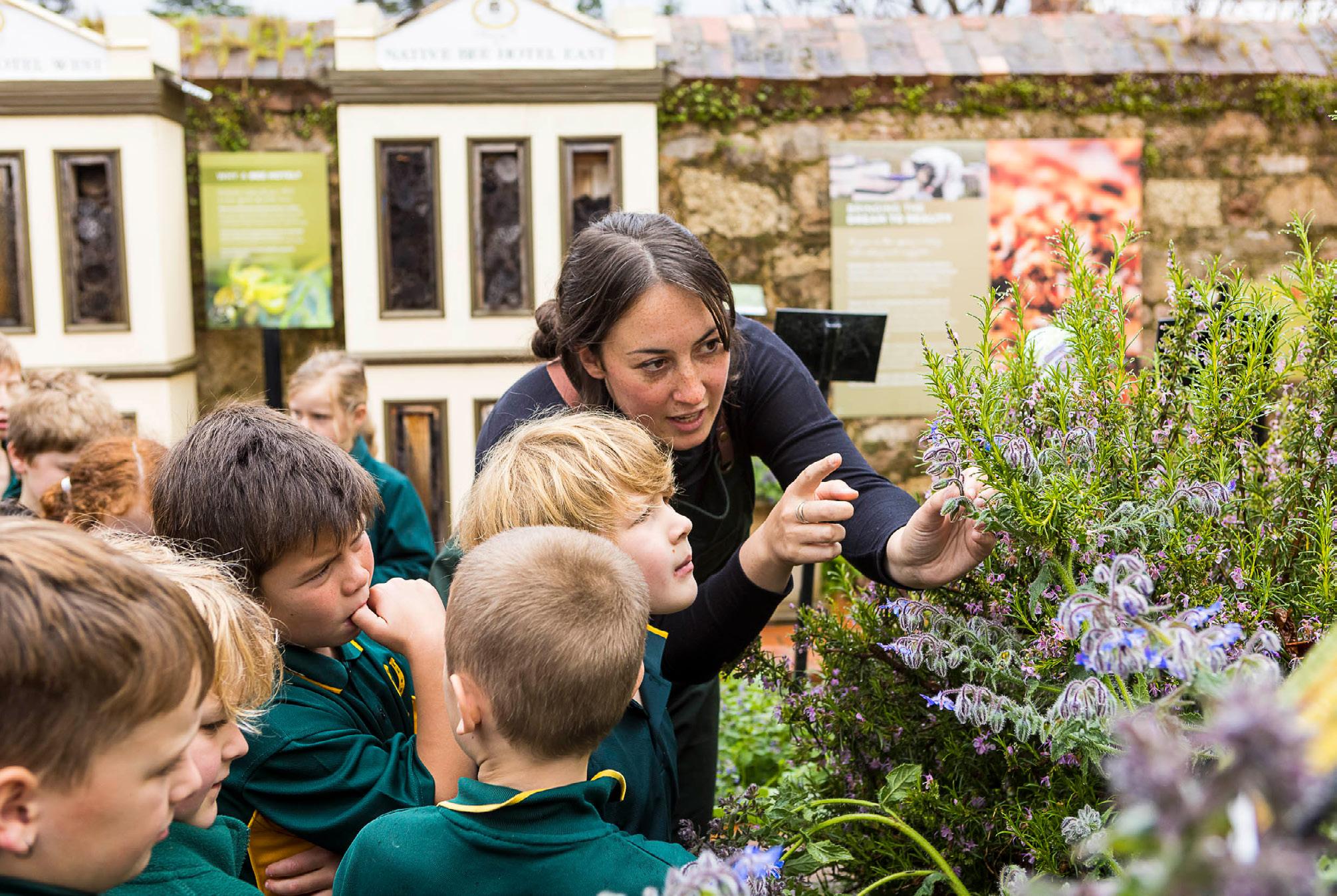
Pollinator Partnership, Flow Hive, Australian Almonds and Equity Trustees, National Farmers’ Federation, Rotarians for Bees, Sustainable Gardening Australia, Australian Government (grant funding), Century Orchards, One Tree Planted, Carman's, Centre for Bee Education, Beechworth Honey, Taxonomy Australia, Australian Academy of Science and CSIRO, Earthwatch Australia, Australian Farmers Market Association, Kingscote Men’s Shed on Kangaroo Island. FRRR, Seacology, Australian Native Bee Association, Planet Ark, Rotary, Junior Landcare, Western Sydney University, University of Sydney, AgriFutures, 1% for the Planet
Website: wheenbeefoundation.org.au/


The Wheen Bee Foundation is a not-forprofit charity that promotes awareness of the importance of bees and other pollinators and their critical role in ecosystem health, biodiversity and food security.
87
NATURE POSITIVE AWARD
Among its many projects is the Bee Friendly Farming program, which support farmers to protect, preserve and promote the health of bees and other pollinators on their land.
So far, 40,000 hectares of land has been certified across six states and 12 industries including almonds, macadamias, avocados, wine, vegetables, mixed farming, seeds and cropping.
One such early adopter of the program is Century Orchards in Loxton, SA where technical manager Gemma Nunn understands the importance of protecting pollinators. “Having a Bee Friendly Farming certification has ensured that we have something to show for improving our pollinator health and making sure that we are looking after our bees,” Gemma said.
The program is run in collaboration with Pollinator Partnership, along with support from Flow Hive, Australian Almonds, Equity Trustees, the National Farmers’ Federation, Rotarians for Bees, Sustainable Gardening Australia and the Australian Government’s Future Drought Fund.
The program includes Bee Friendly Farming Tree Grants, which the Foundation runs in partnership with One Tree Plant, providing grants of up to $10,000 to farmers to plant pollinator-friendly trees.
So far, $65,000 in grants have been awarded to farmers who have collectively planted 92 hectares of pollinator-friendly habitat, improving the ecosystem for pollinator feeding, nesting and breeding.
To encourage additional tree plantings, the Foundation launched a Community Tree Grants program, in partnership with Carman’s. Grants of $500 were given to 25 community organisations to plant pollinatorfriendly trees and shrubs in their local area.
The grants went to schools, environmental groups, Landcare organisations, Rotary clubs, aged care centres, a childcare centre, a
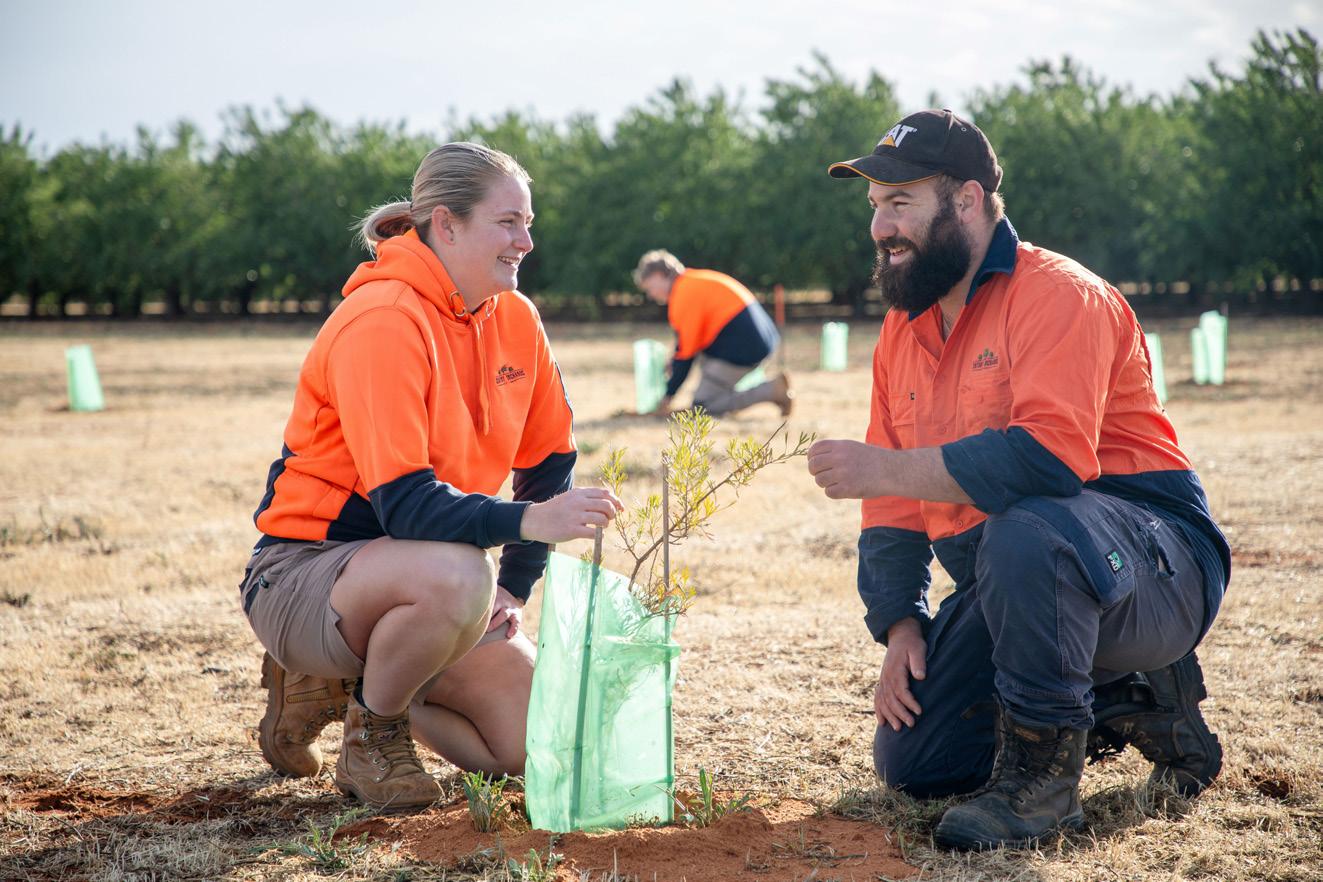
sports club, a Girl Guides group and a bee club, who collectively planted approximately 4,000 trees and shrubs. Such plantings are made easier by another major project by the Foundation - the Powerful Pollinators Planting Guides.
The Foundation has produced 32 individual bio-regional planting guides across Australia, providing information on plant selection and management to increase the number and diversity of insect pollinators in farm and urban landscapes. These guides are developed in collaboration with university researchers and are used by land management groups, communities, farmers and gardeners.
The first Northern Territory guide was developed by researchers working in collaboration with local indigenous groups and includes indigenous plant traditional uses.
With a sharp focus on education, the Foundation has partnered with Bee School by Beechworth Honey to create the Centre for Bee Education (C4BE), a national learning hub for science-based information about bees and other pollinators.
Educators and students can access learning resources, information sheets and lesson plans for engaging learning that fosters a lifelong passion for bees, environmental sustainability and biodiversity.
Beechworth Honey Director Jodie
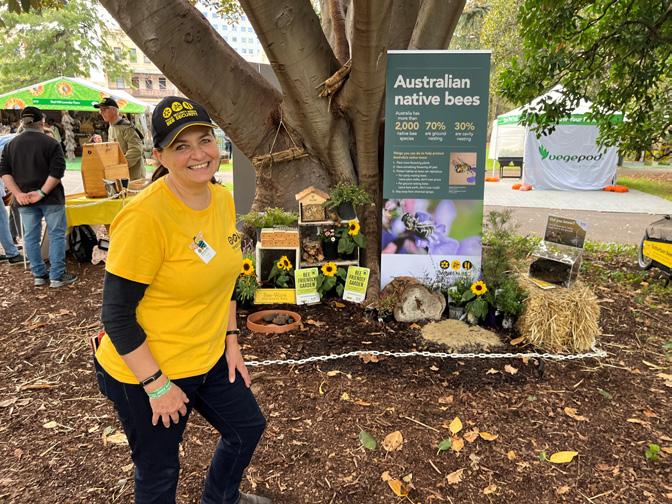
Goldsworthy said the C4BE helps build a deep understanding of bees and pollination among students.
“Partnering with the Wheen Bee Foundation was an obvious step to ensure as many people as possible have access to this information,” Jodie said. “It is vital to teach young people about the issues facing bees and the planet so they are more likely to take action when they are older.”
From almonds to avocados, 40,000 hectares certified, safeguarding bees and vital ecosystems across Australia's diverse industries
88 NATIONAL SUSTAINABILITY SUCCESS STORIES
2024
Upper Murrumbidgee Demonstration Reach
The Upper Murrumbidgee Demonstration Reach unites communities to create a healthy, resilient, and sustainable Murrumbidgee River

Our rivers are in crisis. Australia’s river systems continue to be affected by water extraction, altered river flows, loss of connectivity, and the flow-on effects of land-use changes such as vegetation clearing. The consequences of these practices impact all plants, aquatic and terrestrial animals, and the people and communities who depend on them.
Website: wheenbeefoundation.org.au/




89
NATURE POSITIVE AWARD
Bush Heritage Australia, Upper Murrumbidgee Waterwatch, Australian River Restoration Centre, University of Canberra, ACT Government, NSW Government and the Murray-Darling Basin Authority
The Murrumbidgee River, Australia’s second longest river, is no exception, with 96 percent of its headwater flows diverted and widespread sedimentation and weeds causing habitat loss for native fish, among other threats.
In 2010, the Australian Government recognised the need for action on river health and native fish decline and identified four “Demonstration Reach” sites in the Murray-Darling Basin. One of these was the Upper Murrumbidgee Demonstration Reach (UMDR), focusing on a 320km stretch of the upper Murrumbidgee River between Tantangara and Burrinjuck Dams.
The UMDR quickly realised that improving river health comes not just from focusing on ecological values but also social, economic and cultural perspectives – especially First Nations perspectives. It began community engagement to identify and address major threats facing the river.
In 2012, government funding for Demonstration Reach programs discontinued, however, the problems did not disappear. In a bold move, the UMDR decided to continue its work without ongoing government support, developing a strategic plan underpinned by a community-led approach, evidence-based science, engagement and collaboration. The partnership includes national conservation organisation Bush Heritage Australia, Upper Murrumbidgee Waterwatch, the Australian River Restoration Centre, the University of Canberra and the ACT Government with support from the NSW Government (Department of Primary Industries - Fisheries, Local Land Services) and the MurrayDarling Basin Authority.
Today, the UMDR has grown into an unlikely community of people made up of farmers, landholders, conservationists, Traditional Custodians, volunteers, fishers, government, and scientists. It is one of the largest collaborations of people working to protect any inland waterway in Australia, and has

overcome many obstacles in an effort to achieve its vision.
Since 2020, in the aftermath of the Black Summer fires which burnt large swathes of the river corridor, the work of the UMDR has scaled up.
In the last two years it has achieved:
• 44 hectares of revegetation, with 40,000 plants
• 44km of weed control
• Erosion control at 20 sites
• 30 volunteer days
• Four Aboriginal Water Assessment days with the Ngunnawal community
• 1,000+ people engaged through events and activities, including 45 local landholders.
These works have improved habitat for significant species such as the Macquarie perch, Murray cod and platypus. It has improved water quality by addressing erosion and sedimentation, after the fires caused rock, earth and vegetation to slide into the river. Community engagement has helped to foster river stewardship and connect people with this spectacular river.
All life needs water, and everyone has a personal stake in how water is managed. The UMDR has demonstrated that instead of competing over a scarce resource, cross-community collaboration can enable people to support the river that supports them, making it more healthy, resilient, and sustainable.
These works have improved habitat for significant species such as the Macquarie perch, Murray cod and platypus.
90 NATIONAL SUSTAINABILITY SUCCESS STORIES
2024
91 Net Zero Action Award

ACT Emergency Services Agency
ACT Emergency Services Agency, an emergency service sustainability model.

In 2018, the ACT Government, including ESA, adopted the Transition to Zero Emissions Vehicles (ZEV) Action Plan 2018-2021. The Plan was established to tackle transport emissions in the ACT, which contributes over 60% of all emissions in the Territory. ZEV action in the ACT is ongoing, with the Action Plan now being superseded by the ZEV Strategy 2022-2030. In 2019, the ACT Government released the ACT Climate Change Strategy 2019-2025 which committed the ACT Government to net zero by 2045 and net zero government operations by 2040.
The ACT Emergency Services Agency (ESA) Sustainability program delivers actions focused on the holistic reduction of greenhouse gas emissions, primarily from transport, and the improvement of work, health and safety practices for its staff and the ACT Community.
Website: esa.act.gov.au/






93
NET ZERO ACTION AWARD
WINNER 2024
The program has sought to provide innovative, responsible, and sustainable outcomes for the ACT community

Motivated by a desire to provide a safe and sustainable workplace for ESA staff and volunteers and supported by the targets set under the ACT Government Strategies, the ESA Sustainability program has sought to provide innovative, responsible, and sustainable outcomes for the ACT community. As a first mover in sustainable emergency service provision, the ESA Sustainability program provides a comprehensive approach, for the refinement of emergency operations for environmental, economic, and societal benefits.
Since its commencement in 2019, the ESA sustainability program has achieved a number of significant outcomes including:
the implementation of the first battery electric breathing apparatus support truck; a commitment to a further 6 heavy-duty electric support vehicles, a commitment to nine 9 DC EV chargers in addition to the DC charger already in service; the commencement of build and design processes for 2 fully electric and EV ready fire and ambulance stations; the adoption of range of FCEV, PHEV and BEV’s into the passenger vehicle fleet; and the implementation of Australia’s first electric fire truck.
Through detailed consultation with ACT Fire and Rescue (ACTF&R) firefighters and the ACT Government’s Zero Emissions Government team, the electric fire truck project team sought to provide a revolutionary solution to emissions reduction, community safety, and the wellbeing of frontline operational staff. The resulting electric fire truck is the most modern firefighting
vehicle in the world. The design incorporates state of the art features including electric drive and pumping capabilities making it incredibly innovative and advanced in the provision of urban firefighting.
To address the good health and wellbeing of operational staff, the design provides street level entry which reduces injuries to firefighters climbing in and out of fire trucks with heavy equipment on their backs. The electric motor is silent reducing noise and vibration for firefighters which will greatly improve work health and safety across all ESA workplaces and makes it easier for crews on the ground to operate. The reduction in carbon monoxide and cancercausing diesel particulates from the firefighter’s work area is a key sustainability goal for electrifying the ESA fleet.
Pioneering net zero emissions in emergency services for a sustainable future
Through ambitious goal setting under the ESA Sustainability program, and the ACT Government transition to net-zero electricity, the ESA has delivered long lasting and significant environmental, economic, and social benefits to the ACT community.
94
NATIONAL SUSTAINABILITY SUCCESS STORIES
2024
Blue Leaf Water Cremation
Blue Leaf Water Cremation – offering the most gentle and ecofriendly option in Pet Aftercare.

With Climate Change and NetZero targets, there is a growing movement towards adopting new and innovative practices that offer greener alternatives. One such industry that has a devastating impact on the environment, is the aftercare industry.
With burial and flame-based cremation being the traditional methods in aftercare, they are far from being environmentally friendly. However, there is a gentler and more sustainable alternative available. Cremation by water.

95
blueleaf.net.au/
Website:
NET ZERO ACTION AWARD
Also known as Alkaline Hydrolysis, water cremation was patented in the US, back in 1888 and has been available overseas in the aftercare industry since 2011. The process mimics nature, where the body is placed under a gentle flow of 95% water and 5% alkali, reducing the body to its essential elements and leaving behind the calcium phosphate (bone). As the process is more gentle than traditional flame cremation, families can receive 2030% more of the cremains.
Water cremation leads the way in reducing the environmental impact by 97%, as it offers;
• A gentler method to the disposition of the pet’s body as we do not subject the pet’s body to excessive force and heat
• 90% less energy than flame cremation
• No burning of fossil fuels
• Zero (0) emissions of harmful greenhouse gases
• Completely kills any pathogens
• Orthopaedic implants can be recycled
• The bone mineral is 100% clean, sterile, pollutant free and can be safely returned to the earth
• NO release of chemicals from animals that are euthanised and buried
• NO release of nitrogen or methane into the soil, which occurs during burial
• The by-product is a sterile solution of amino acids, sugars, and peptides, which can be safely returned to the environment.
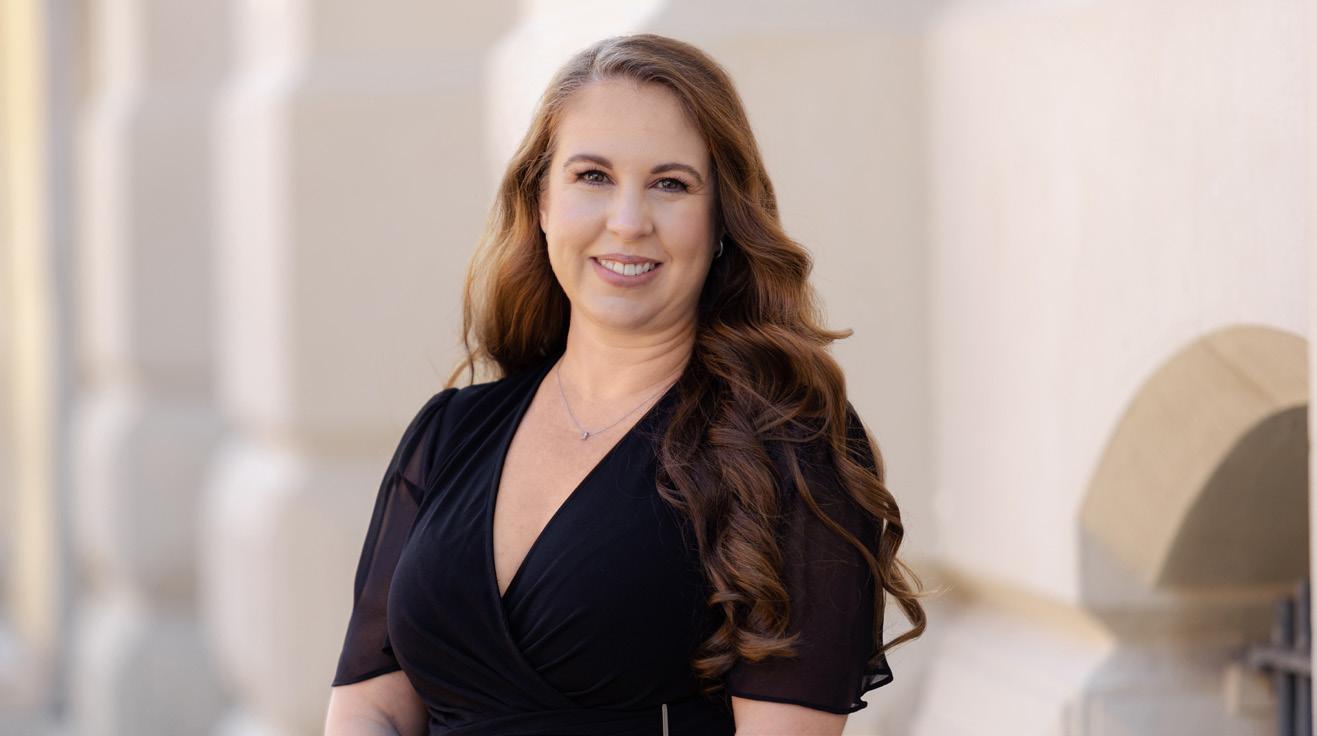
One company offering the service to WA Pet Parents, is Blue Leaf Water Cremation. Managing Director, Catherine McKay, came across the process when researching into greener alternatives for a family member. At the time, it was not being offered in Perth, so the family set out to establish WA’s first fully licensed facility, dedicated to offering a personal service, with the most gentle and eco-friendly way to honour our beloved pets.
“The Aftercare Industry wasn’t somewhere I thought I would find myself, but it is a business of compassion and empathy. To be able to provide a service, that gives back to the community as well as reduces the environmental impact, that was
something that resonated close to my heart.”
Committed to establishing and providing a more sustainable business, every operational decision was made with the environment as the priority factor. “We’ve invested in low-emission vehicles, installed solar panels at our facility, offer homemade cotton shrouds (no plastic cadaver body bags), stock only natural, sustainable and biodegradable urns and memorabilia, as well as donate for a tree to be planted on behalf of every pet we provide a service for.”
Understandably, most people will find discussions around the topic difficult, but positive change won’t occur unless every person and every organisation see it as their own responsibility to make a different in the world.

96
NATIONAL SUSTAINABILITY SUCCESS STORIES
2024
Cerclos
Cerclos enables global leaders to accelerate towards net zero in the built environment through powerful Life Cycle Assessment software
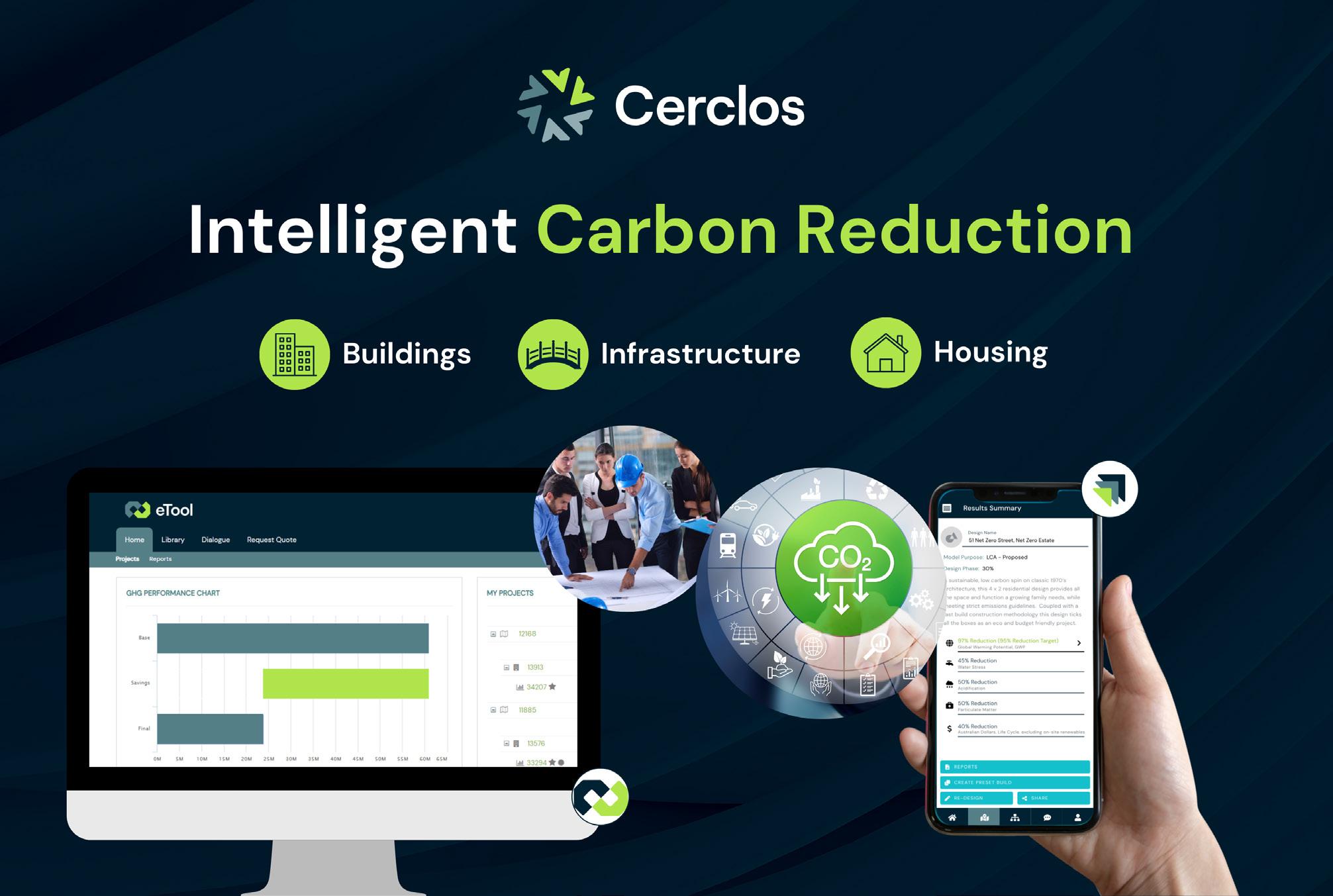
For more than a decade, Cerclos has been at the forefront of providing net-zero software solutions for global leaders. Driven by an advanced Life Cycle Assessment (LCA) engine, Cerclos is globally accelerating organisations towards net zero in the built environment.
Founded in Perth, Western Australia, by co-founders Alexander Bruce and Richard Haynes, in 2011, the demand for LCA grew and Cerclos expanded its team nationally, and then to New Zealand, the United Kingdom, and Brazil.









97
cerclos.com
Website:
NET ZERO ACTION AWARD
At the core of this mission is the flagship eTool, the ultimate Life Cycle Assessment (LCA) software, tailored to large buildings and infrastructure projects. eTool enables organisations to accelerate decarbonisation through the holistic and proven life cycle methodology. Enabling design with precision, efficiency, repeatability and traceability with measurement of 30+ environmental impacts. Aligned with international standards and globally recognised for integrity and scientific rigour — this is essential in this era of escalating environmental targets and heightened scrutiny.
Addressing the realm of low-tomedium density housing, Cerclos introduced the game-changing RapidLCA app. A fast, intuitive, affordable and enterprise-ready tool facilitating the carbon reduction of housing portfolios with ease and transparency. This app is accessible to a broad audience, from non-LCA professionals to land developers and government stakeholders.
The Net Zero Innovation Centre stands as a testament to their commitment to carbon reduction. Here, a team of carbon experts offer consultancy and support, ensuring optimal software utilisation for best carbon reduction outcomes.
A cornerstone belief driving Cerclos is that meaningful results arise from effective measurement. Co-founder Alexander Bruce emphasises, "You can't manage what you can't measure," highlighting the company's commitment to tangible outcomes. Since 2016, Cerclos has successfully avoided over 1.3 million tonnes of carbon equivalent emissions through 70,000+ individually modelled carbon reduction strategies across more than 11,000 projects within the Cerclos community.
This diverse community spans government, engineers, architects, consultants, and more, contributing to projects ranging from individual housing to low-to-medium density housing, commercial and mixeduse buildings, and large-scale infrastructure like railways, ports, and mining projects.
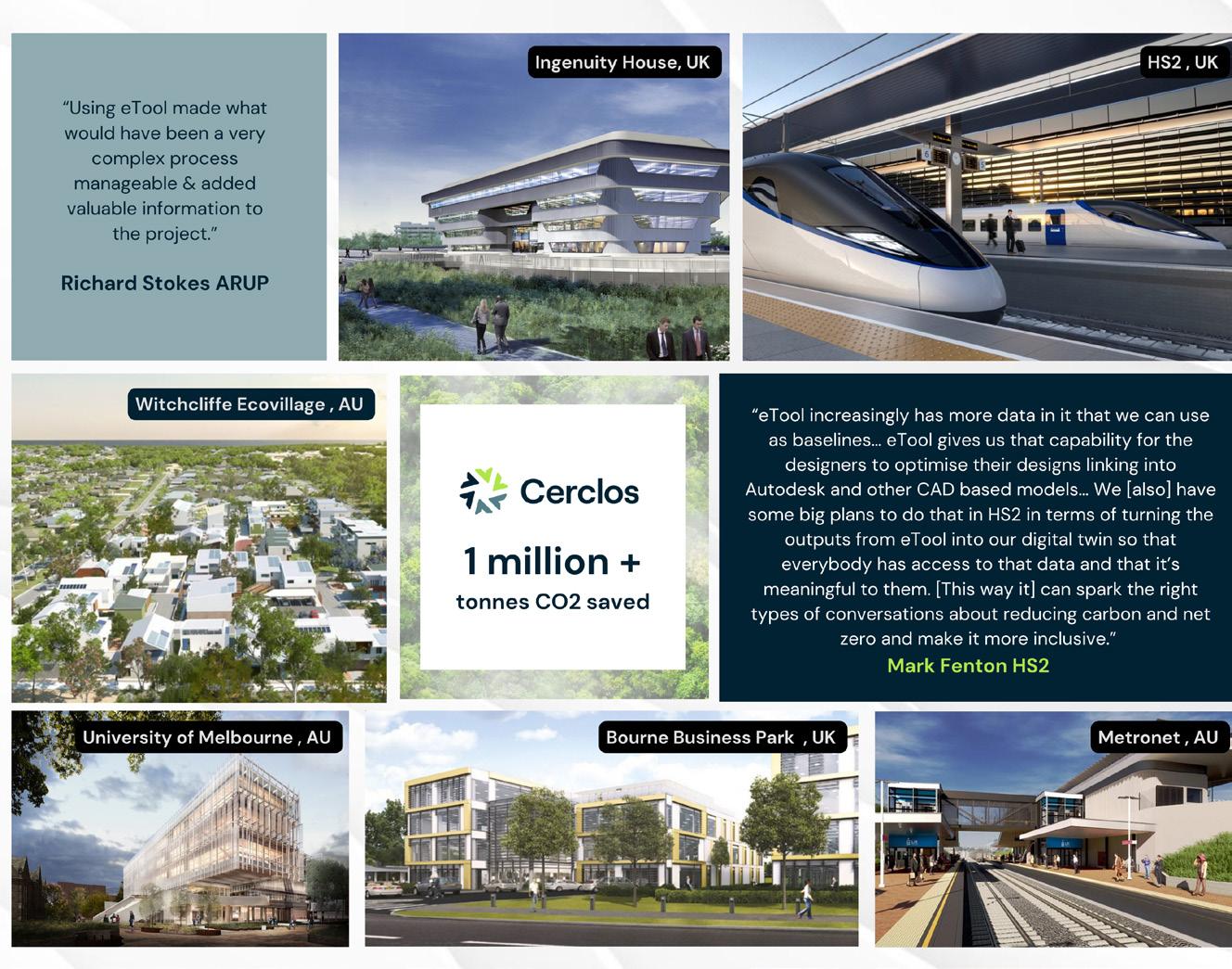
The Cerclos reputation as a trusted partner extends to mega-projects globally, from its origins in Perth to projects in New Zealand, the United Kingdom, and even Antarctica.
Notable projects utilising eTool include the world-class venue, Perth’s Optus Stadium, METRONET, the government agency overseeing Perth's rail network and Scott Base, New Zealand’s sole Antarctic research station. In the United Kingdom, eTool plays a pivotal role as the chosen LCA software for the AUD$185 billion high-speed rail project, HS2. This ambitious project aims for a 50% carbon reduction by 2030 in Europe’s largest infrastructure project.
The race to carbon-free housing is exemplified by the standout achievement by Witchcliffe Ecovillage
in south-west WA. One of the world’s most sustainable housing communities who utilised RapidLCA to surpass their net zero goal and achieve a remarkable 125% reduction in emissions.
Collaboration with Kāinga Ora, New Zealand's public housing authority, showcases the practical application of RapidLCA to transition toward carbon-neutral public housing and meet government emissions reduction targets.
The built environment is responsible for 28% of global greenhouse gas emissions underscoring the urgent need for climate action. In the race toward a sustainable future, choose Cerclos as your trusted partner, dedicated to making a meaningful impact in accelerating towards net zero goals..

98 NATIONAL SUSTAINABILITY SUCCESS STORIES
2024
Monash Sustainable Development Institute
This initiative shows how five heavy-industry supply chains, can eliminate more than 90 per cent of their emissions by 2050, while meeting the needs of a net zero global economy.

The Australian Industry Energy Transitions (ETI) – a collaboration between Climateworks Centre, ClimateKIC Australia and industry participants representing approximately 22 per cent of Australia’s industrial emissions and 32 per cent of the ASX100 market value – worked to identify a comprehensive, least-cost pathway for heavy industry to achieve net zero emissions.
Over the last three years, the pioneering initiative collectively explored and addressed the challenges associated with decarbonisation on this scale. The ETI achieved what it set out to achieve and a first for Australia — a collaboratively designed, fully-endorsed pathway to lead Australian industry towards a decarbonised future.
Website: climateworkscentre.org/project/australian-industry-energy-transitions-initiative/






99
NET ZERO ACTION AWARD
Industry participants representing approximately 22 per cent of Australia’s industrial emissions and 32 per cent of the ASX100 market value
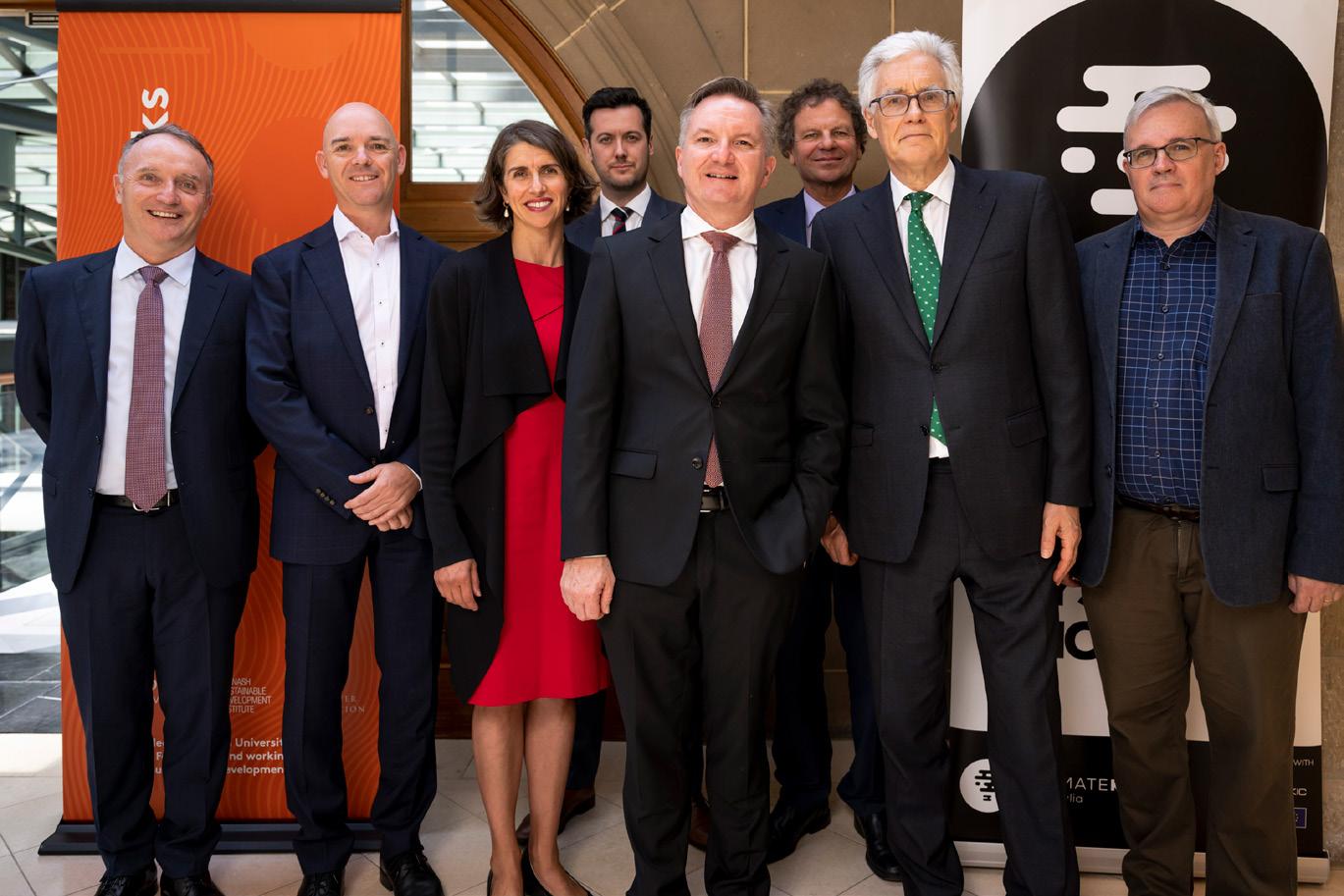
The ETI’s capstone ‘Pathways to industrial decarbonisation’ report included decarbonisation pathways for five of Australia’s most significant heavy industry supply chains, consistent with global efforts to limit warming to 1.5oC. The report also showed that for most sectors rapid decarbonisation was possible while increasing production and remaining competitive in a net zero global economy.
ETI helped Australia take a significant step forward in understanding how to eliminate some of its most entrenched industrial emissions, often written off as too hard to abate. Through state-of-the-art modelling and partnership with industry, the ETI showed which technologies are best-suited to decarbonise industrial processes between now and 2050. The work also shows the scale of investment and renewable
energy needed to support the effort. Coordinated action among government, industry and finance is crucial for the net zero transition.
The work is already propelling action within the Australian Government. The Australian Treasurer relied on ETI analysis and support from industry when he committed $2 billion for hydrogen development in the 2023 Budget. The data inputs and assumptions developed for ETI are being used in economic modelling undertaken by the Treasury. At the launch of ETI’s Pathways report,
the Hon Chris Bowen MP, Minister for Climate Change and Energy, released the report saying, ‘This, the fastest transition since the industrial revolution, is and must be a wholeof-society effort. And I believe we can do it — and reports like this are important in helping us to.’
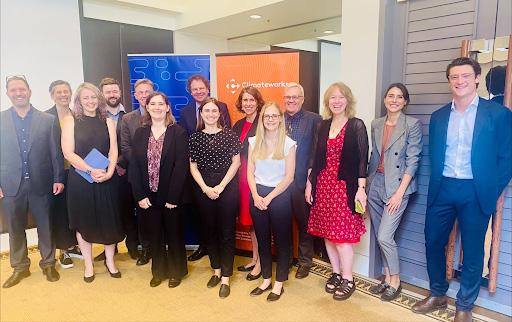
100
NATIONAL SUSTAINABILITY SUCCESS STORIES
2024
Orica Limited
Every day, all around the world, Orica helps sustainably mobilise the earth’s resources

Orica’s purpose is to sustainably mobilise the earth’s resources, guided by our Sustainability Strategy. Orica is vigorously implementing our climate change strategy supported by strong Board and executive governance, embedding into business strategy and clear and evidence based decarbonisation pathways.




A key pillar of our decarbonisation strategy is deploying cutting edge tertiary catalyst abatement technology to reduce nitrous oxide (N2O) emissions, a greenhouse gas (GHG) 265 times more potent than carbon dioxide (CO2) and a by-product of producing nitric acid for explosives. Tertiary catalyst N2O abatement has been successfully deployed at Orica’s Carseland facility in Canada and Kooragang Island facility in New South Wales (NSW) in an Australian-first.
101
Website: orica.com
NET ZERO ACTION AWARD
The transformational $37 million KI Decarbonisation Project is a public-private partnership with the NSW Government and the Clean Energy Finance Corporation and has eliminated the GHG emissions generated by Orica’s three nitric acid plants by at least 98 per cent. This is equivalent to 48 per cent of the site's total GHG emissions, 11 per cent of all chemical industry process emissions across Australia.
Orica has also signed a 10year renewable power purchase agreement (PPA) with the Wellington North Solar Farm near Dubbo to supply 100 per cent of Orica’s electricity needs in NSW. The solar farm extension will be operational in 2025 and forecasted to reduce Orica’s Australian Scope 2 emissions by approximately 50 per cent, corresponding to 65,000 tCO2-e per annum.
Orica’s ammonia plant represents a challenge in decarbonisation as the ‘hard-to-abate’ chemicals plant does not have many proven technologies to reduce Scope 1 emissions. Renewable hydrogen has emerged as a potentially significant enabler of Australia’s transition to a lower-carbon economy and would enable Orica to be a hydrogen carrier through the manufacture of ammonia. Orica is working with Origin Energy on the Hunter Valley Hydrogen Hub (HVHH) where hydrogen will displace natural gas in the production of ammonia
With transformative projects, cutting emissions by 98% in a groundbreaking public-private partnership.
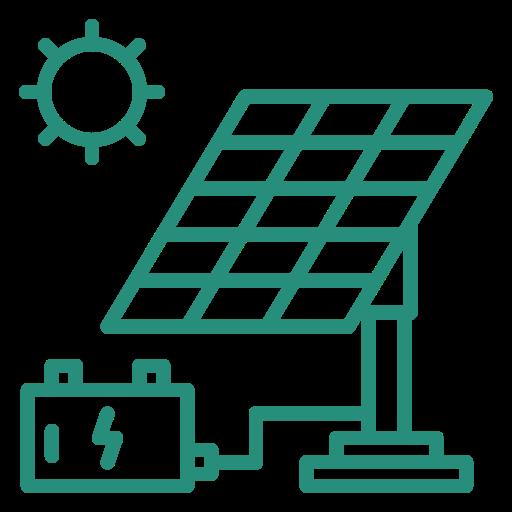
and ammonium nitrate – supplying 85 per cent of mines in the Hunger region and crucial products for many businesses across NSW including agriculture, health, and food industries.
Furthering on decarbonisation with the HVHH, Orica’s long-term joint venture with Mineral Carbonation International (MCi), focused on commercialising CCUS technology,
will further reduce Scope 1 emissions. CCUS plays an important role where abatement technology is not available or economically viable. With support of an Australian Government grant, a CCUS demonstration plant is being built by MCi at Orica’s Kooragang Island site. It is scheduled to be operational in 2024 and forecast to have the capability capture 3,000 tCO2-e per annum generated from our ammonia plant.
102
NATIONAL SUSTAINABILITY SUCCESS STORIES
2024
Telstra InfraCo
Telstra InfraCo is a digital infrastructure solutions provider which weaves sustainability through its business practices, including responsible business partnerships and environmental initiatives to reduce its carbon footprint.
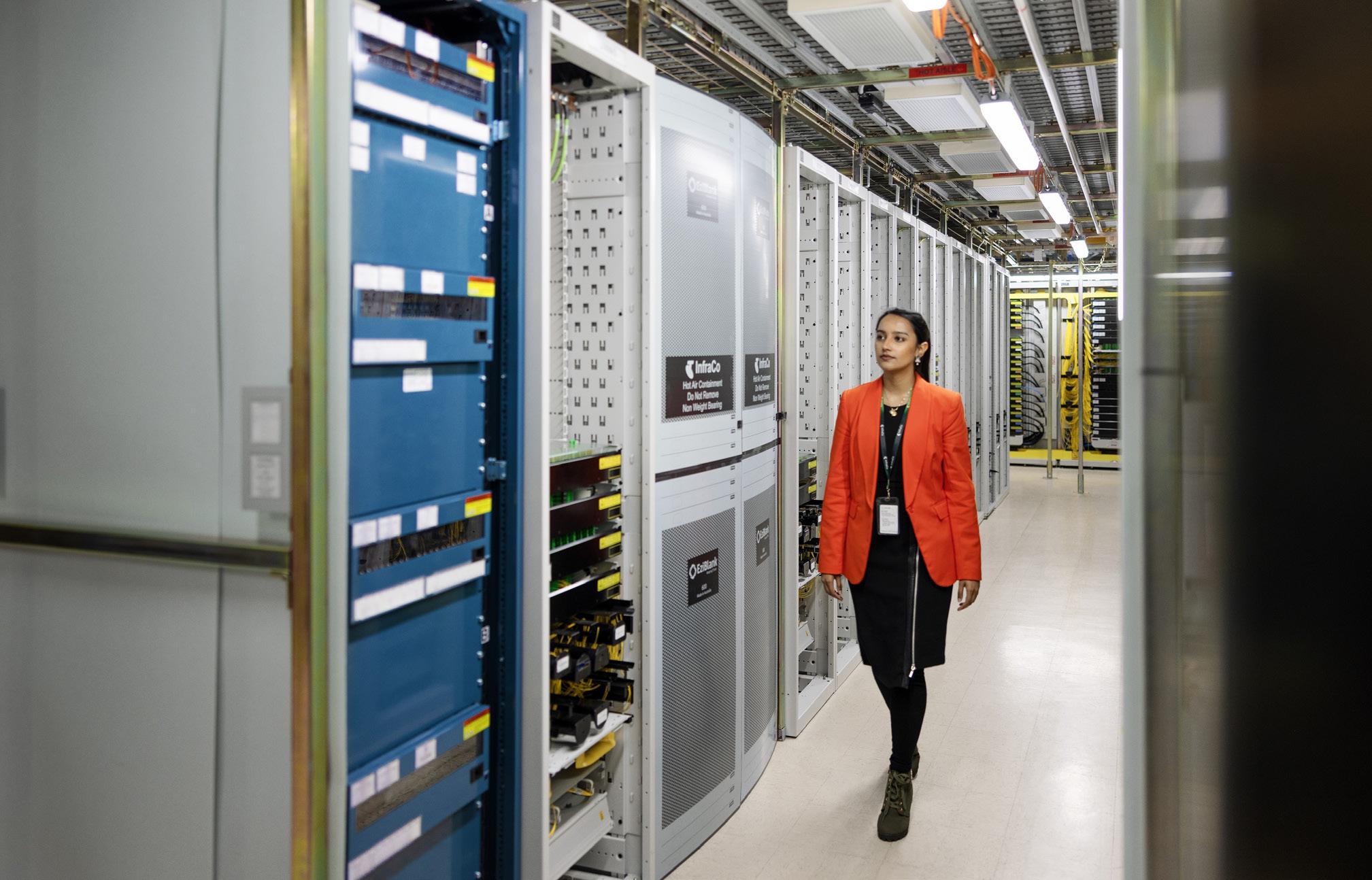
Telstra InfraCo is a digital infrastructure solutions provider which weaves sustainability through its business practices, including responsible business partnerships and environmental initiatives to reduce its carbon footprint.
Website: infraco.telstra.com.au/



InfraCo are already feeling the impacts of climate change on their infrastructure and are committed to decarbonising their operations. This commitment has driven investments in resource conservation, operational efficiency, and waste management and play a significant role in the achievement of Telstra’s Group-wide sustainability objectives.
103
NET ZERO ACTION AWARD
Decarbonising operations, cutting energy use, and embracing renewables for sustainability

Through comprehensive climate action planning Telstra InfraCo is meeting the needs of its unique and diverse infrastructure portfolio with multi-year programs spanning from legacy network metal and general network waste recycling, energy reduction, renewable energy, and carbon offsetting, to the innovation in the design and deployment of the intercity fibre project now being built across Australia. These programs are offering long-term and big impact sustainability solutions, leveraging technology and infrastructure knowhow working closely with industry partners.
Energy use, a significant contribution by the telco industry, is being targeted with the technology smarts and innovation to target significant and sustained energy reduction, renewables, and carbon offsetting across the diverse national infrastructure footprint.
InfraCo’s Energy Reduction Program is a multi-year program encompassing numerous projects focussing on InfraCo’s largest energy consumption source, the energy used to power InfraCo’s building services assets such as air conditioning, power conversion systems and lighting.
Last year Telstra InfraCo implemented its largest ever energy efficiency program with over 1,400 individual projects completed to deliver
ongoing annual energy savings of over 30,000 MWh pa.
In 2022, at Brisbane’s Charlotte Exchange, InfraCo trialled the Siemens Demand Flow chilled water optimisation technology, incorporating high-accuracy sensors for real-time feedback on system performance, and variable frequency drives on pumps and fans enable real-time optimisation of the chilled water system relative to load. This project successfully reduced the chiller system's energy consumption by over 30% so last year additional systems were installed at five of their largest fixed network sites which are expected to save over 3,000 MWh annually.
Following extensive trials of LED lighting options in 2020, InfraCo adopted a solution from enLighten Australia which includes individual movement sensing for each fitting. Thoughtful design decisions are made to reduce the number of lights required and the duration they operate, while meeting Australian Standards. The program involves recycling redundant fluorescent tubes, emergency-fitting batteries, and metal/plastic from old fixtures, and importantly, all new lights are delivered without plastic packaging. Since 2020, over 127,760 fluorescent lights have been removed from InfraCo’s fixed network sites, including 71,315 in FY23. The installation of 64,630 LED fittings has resulted in a substantial reduction in annual energy consumption.
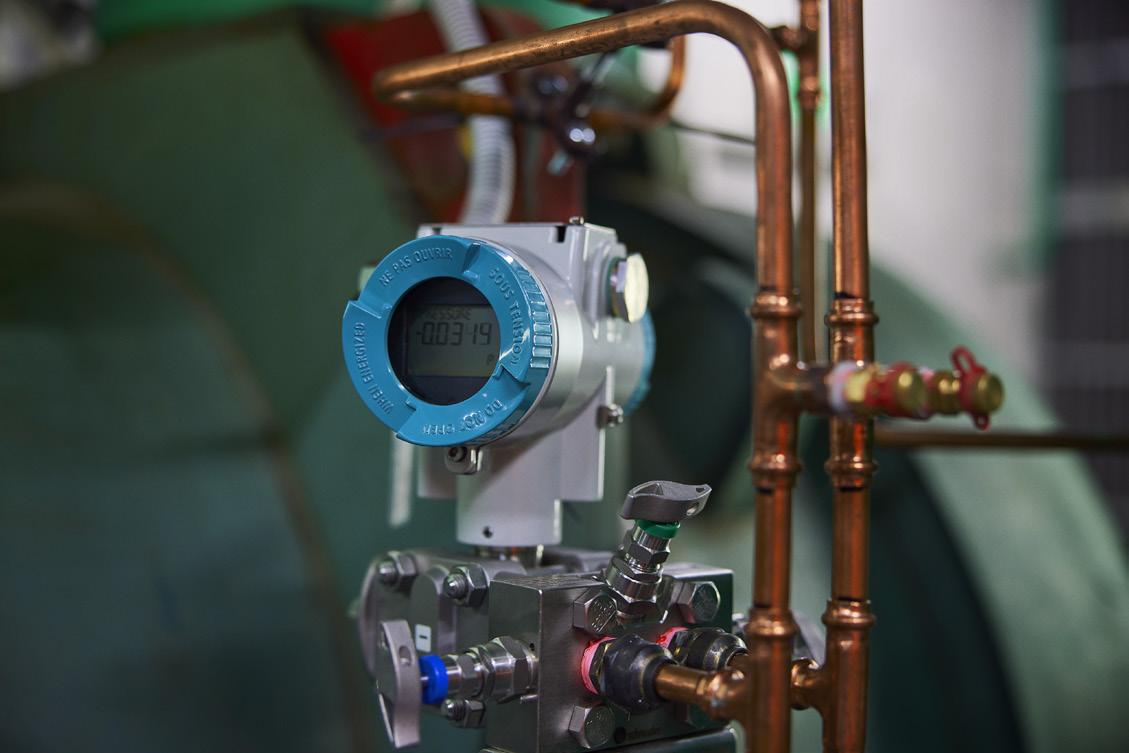
104
NATIONAL SUSTAINABILITY SUCCESS STORIES
2024
105 Placemaking Award

Parramatta Light Rail Stage 1
Transport for NSW is delivering integrated, customer-focused and sustainable public transport with the Parramatta Light Rail Stage 1 project; to improve the way people connect, move and thrive in Western Sydney.
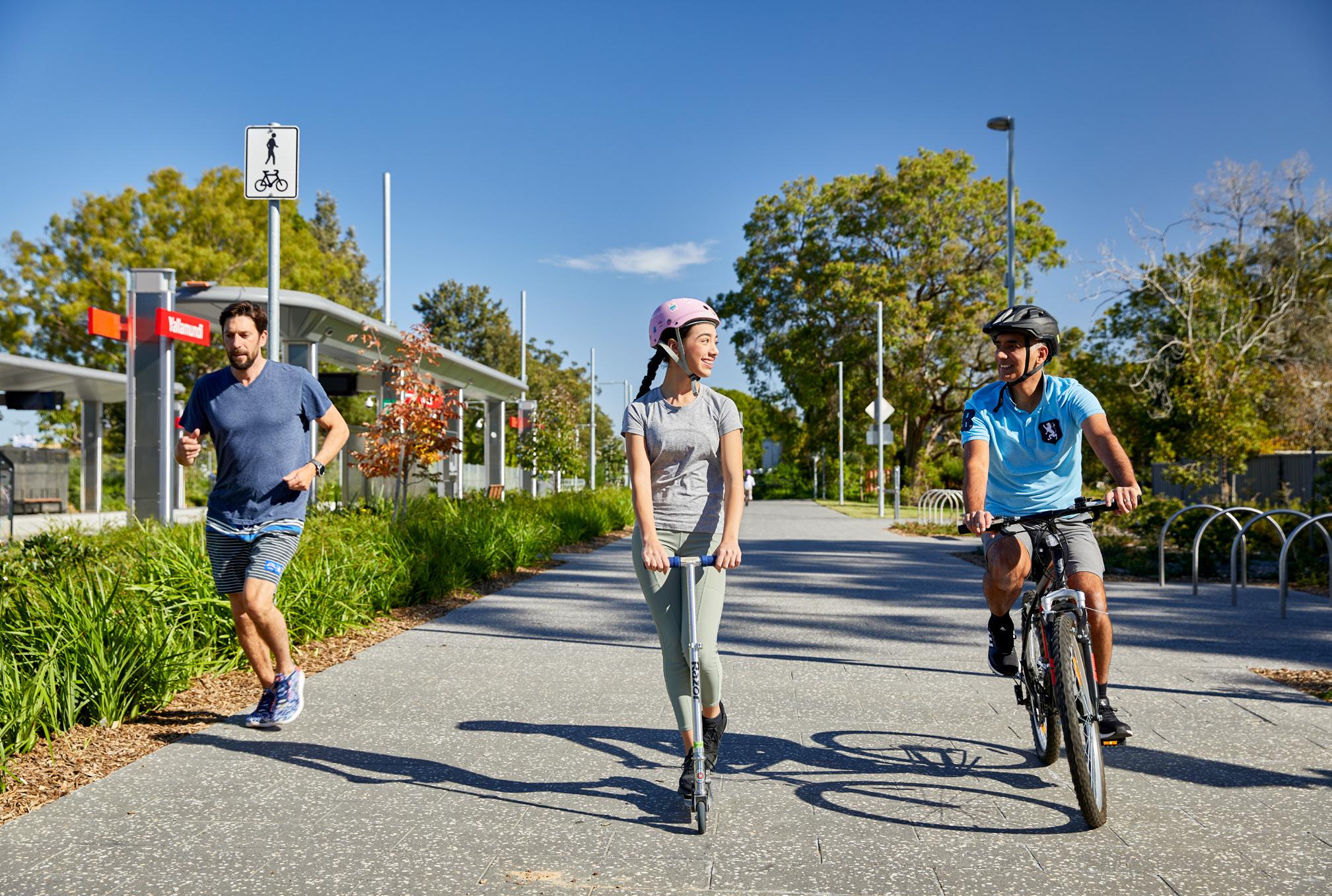
Parramatta Light Rail Stage 1 (PLR) connects Westmead to Carlingford via the Parramatta CBD and Camellia, with a 12-kilometre, two-way track featuring 16 stops and 12 new or refurbished bridges. It is expected to open in 2024.
Website: parramattalightrail.nsw.gov.au/







107
PLACEMAKING AWARD
WINNER 2024
Transport for New South Wales, CPB Contractors, Downer EDI
It will take the equivalent of 25,000 cars off the road or 2.4 million t/CO2-e by 2041
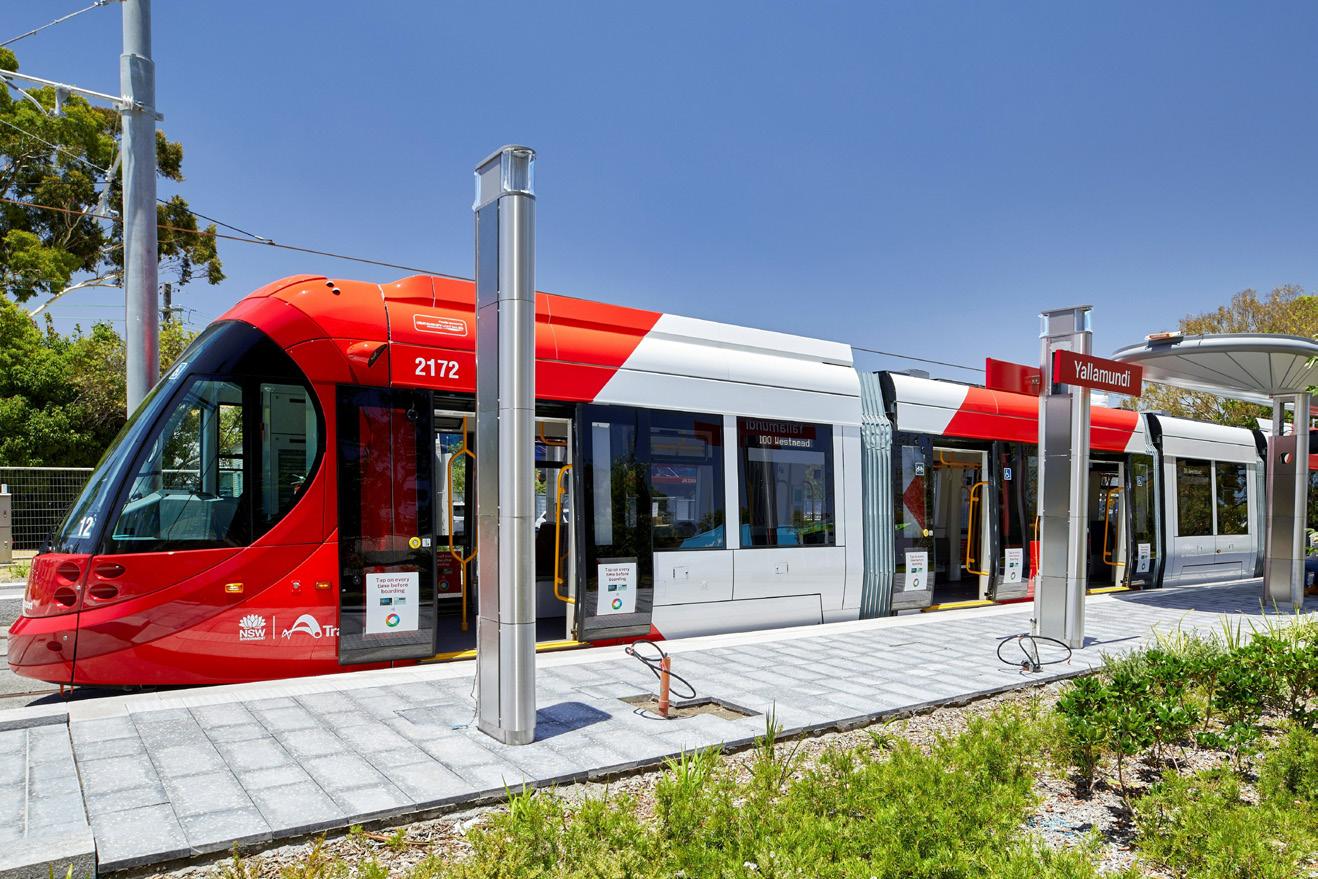
PLR will connect the Parramatta CBD to the Westmead Health Precinct, CommBank Stadium, the largest museum in NSW Powerhouse Parramatta, the Rosehill Gardens Racecourse and three Western Sydney University campuses at Westmead, Parramatta and Rydalmere.
PLR will reduce the need for people to travel by car around the Greater Parramatta region, taking the equivalent of 25,000 cars off the road or 2.4 million t/CO2-e by 2041.
By 2026, around 28,000 people are expected to use the Parramatta Light Rail every day, with an estimated 130,000 people living within walking distance of the light rail stops.
Transport for NSW has worked closely with its delivery partners to reduce impacts on residents and businesses while delivering this vital and transformative Critical State Significant Infrastructure project for the NSW community.
Leaving a positive placemaking legacy was important and through the delivery of PLR, TfNSW committed to preserving and maintaining Parramatta’s rich historical and cultural significance.
The incorporation of an enhanced urban realm, green track and wire-
free areas into its design and the provision of active transport links to promote physical, mental and social community health were notable sustainability achievements.
Through various design, planning and delivery initiatives; and in close consultation with the community and stakeholders; TfNSW mitigated construction impacts and found alternative and innovative solutions to build within dense urban communities.
The Stabling and Maintenance Facility at Camellia is at the forefront of sustainable design with natural lighting in the saw-tooth roof design, 300kW photovoltaic array solar panels, rainwater storage and washdown water recycling with the solar array and water tank features accounting for a quarter of operational needs.
Through the NSW Government’s Industry Skills Legacy Program (ISLP), TfNSW addressed skill shortages and increased diversity in the industry. PLR has exceeded its employment targets for employing women in nontraditional roles, First Nations people, apprentices, and young, mature, and disadvantaged workers.
Delivering a significant infrastructure project in the heart of existing communities had challenges, and the project needed to be agile to adapt
to COVID-19 and its associated impacts. Community and stakeholder engagement was essential to minimise impacts and fast-track construction where possible.
Throughout delivery, TfNSW implemented strategies to minimise disruption, such as micro-tunnelling works in the Parramatta CBD, using 3D modelling to identify and relocate utilities and using prefabricated construction and crane installation methods to reduce community impacts, such as in Bidgee Bidgee Bridge construction.
Through the use of macro synthetic fibres for track slab construction, an Australian-first rubber rail boot system, and a sustainable wire-free green track design; the project achieved a ‘Leading’ AsBuilt Infrastructure rating from the Infrastructure Sustainability Council in 2022.
TfNSW and its delivery partners are committed to delivering this cityshaping project to future-proof transport and improve liveability in Western Sydney.
108
NATIONAL SUSTAINABILITY SUCCESS STORIES
2024
My Home Australasia Limited (“My Home”)
“My Home” is a philanthropic housing developer who designs and constructs high performance, comfortable and enjoyable homes for people who are homeless.

"My Home" is a not-for-profit organisation dedicated to building homes for the homeless or those at risk of homelessness.
Established as a philanthropic developer, "My Home" operates pro-bono, bringing together the Public, Private, and Community Sectors in traditional PPP partnerships. Their first project, completed in July 2023, provided homes for eighteen older women in North Fremantle, previously homeless, on a 1722m2 site. The key premises of "My Home" are centered around reducing the cost of housing by eliminating land costs, prioritising "Housing First" approaches, and providing high-quality, energyefficient homes to all, including the homeless.






109
PLACEMAKING AWARD
Website: myhomehousing.org.au/

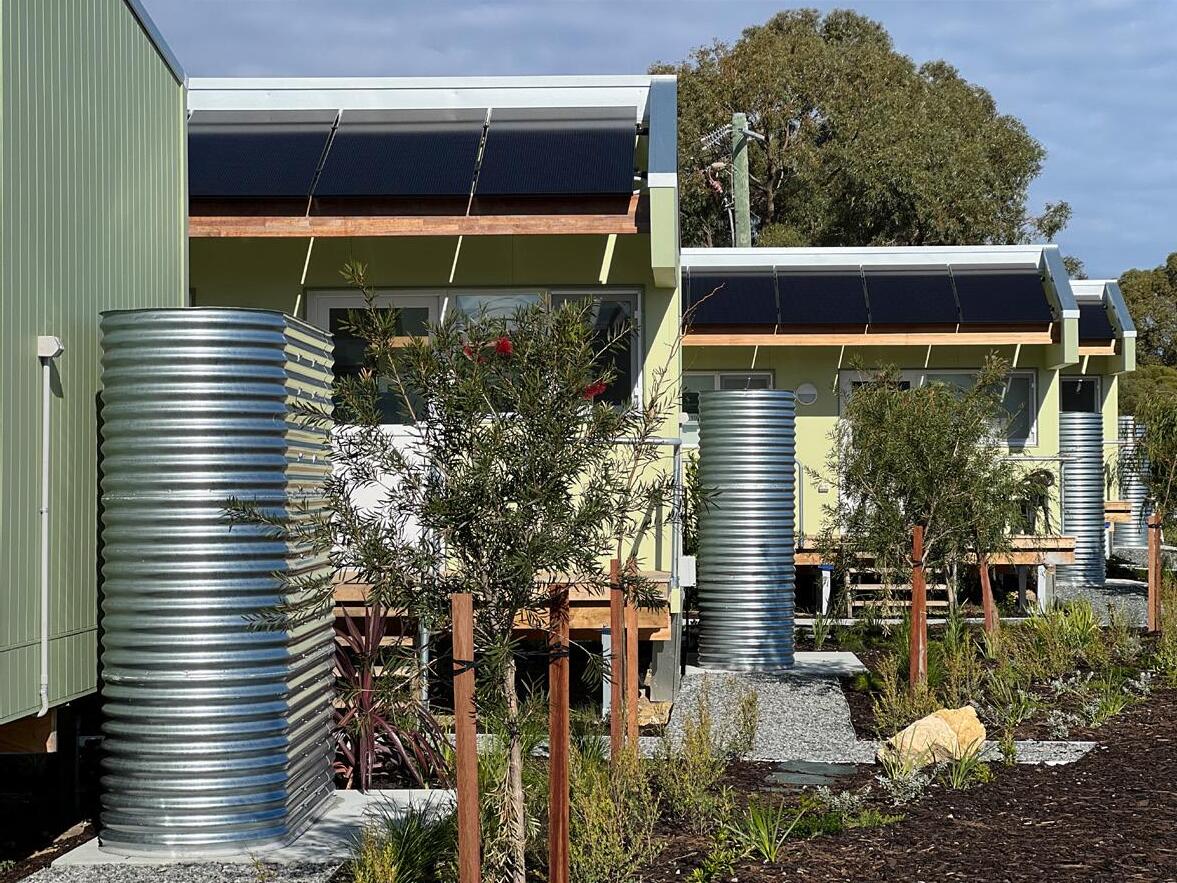
Premise 1 focuses on the cost of land, stating that removing this cost significantly reduces the overall cost of housing, making it more affordable.
Premise 2 emphasises the "Housing First" approach, providing a safe, secure permanent home first, then offering tailored support services, significantly increasing the chances of transitioning to an independent and dignified quality of life. This approach is endorsed by the State government's strategy on homelessness, emphasising its success in reducing homelessness in various countries.
Premise 3 highlights the belief that everyone deserves a home designed and built to high standards of performance, energy efficiency, comfort, and enjoyment. The aim is to deliver healthy, high-performance homes to those most in need while
demonstrating to the government that sustainable and energy-efficient social housing can be provided costeffectively and expediently. The process involves early professional involvement from all stakeholders, with Passivhaus construction methods chosen for their sustainability and efficiency.
The project's primary deliverables include self-contained, domestic construction homes with low running costs, high thermal performance, and net-zero carbon emissions. These homes are designed to respond to local residential contexts, be low maintenance, robust, safe, and secure. The construction strategy includes Passivhaus standards, above-standard insulation, airtight construction, double glazing, interior fresh air exchange, solar PV panels, rainwater tanks, and shared heat pump HWS, resulting in minimal power bills.
Residents highlight the transformative impact on their lives and emphasise the importance of compassionate housing initiatives
Premanufactured structures are used to reduce waste and build times, with versatile designs allowing for various site and soil conditions. Property management is handled by a Community Housing Provider, which also acts as a conduit to support services for residents. Statements from residents highlight the positive impact of these homes on their lives, expressing gratitude for the opportunity and the sense of safety and belonging they now feel.
"My Home" aims to scale its model across a range of development scenarios, starting with social housing for the homeless and expanding to include mixed residential developments reflecting community composition. The organization intends to lead by example, advocating for more sustainable and inclusive housing solutions.
110
2024 NATIONAL SUSTAINABILITY SUCCESS STORIES
Public Transport Projects Alliance Ovingham
The Ovingham Level Crossing Removal Project, delivered by the Public Transport Projects Alliance Ovingham stands as a groundbreaking model, seamlessly integrating safety, sustainability, and community inclusivity to redefine urban infrastructure norms.

The Ovingham Level Crossing Removal Project in South Australia emerged as an unparalleled example of innovative urban infrastructure development, setting new standards in collaboration, sustainability, and community engagement.
Website: https://ptpa.com.au/projects/ovinghamcrossing












PLACEMAKING AWARD
McConnell Dowell, Mott MacDonald, Arup and Department for Infrastructure and Transport
Undertaken by the Public Transport Projects Alliance Ovingham (PTPAO) consortium, comprising McConnell Dowell, Mott MacDonald, Arup, and the Department for Infrastructure and Transport (DIT), this visionary project reshaped the Adelaide landscape.
Situated just 4km from the Adelaide CBD, the project addressed critical safety concerns arising from the Torrens Road level crossing, where 21,300 vehicles navigated daily, intermingling with a bustling train line. The primary objective was safety and efficiency enhancement for road traffic, pedestrians, cyclists, and freight rail services. But what set this project apart was its holistic vision, encompassing Sustainable Development Goals (SDGs) across various facets.
From the project's genesis, inclusivity and sustainability were central. Embracing the unique heritage and character of the local community, the design aimed for seamless integration with future urban developments. Extensive engagement sessions with councils, stakeholders, and Indigenous representatives sculpted a design approach focused on cultural celebration, environmental consciousness, and inclusive public spaces.
One standout feature was the creation of a vast open space exceeding 23,000m2, serving as a dynamic community hub. But it wasn't just about physical structures; it was about fostering a sense of ownership and pride within the community. The inclusion of Aboriginal Cultural Expression and the formation of a Kaurna Reference Group exemplified a ground-breaking commitment to cultural sensitivity and reconciliation. The project navigated challenges ingeniously, from construction over operational rail lines to space limitations. Innovations in constructability opened spaces beneath the bridge for community use, while sustainable practices permeated the project's fabric. The use of recycled materials, sustainable water sourcing, and high recycling

rates showcased a commitment to environmental stewardship, setting new benchmarks.
Socially, the project went beyond mere infrastructure. It became a catalyst for economic growth, surpassing targets for Aboriginal participation, local economic contributions, and gender diversity. Investments in local businesses, job creation, and education initiatives illuminated a path towards a more inclusive and empowered society.
Moreover, the project's enduring legacy extends beyond physical structures. It symbolises a paradigm shift in urban development, emphasising partnerships, community involvement, and
transparent communication. The innovative strategies employed not only elevated the project but also set regional benchmarks for future endeavours.
The Ovingham Level Crossing Removal Project stands as a testament to visionary urban development, transcending traditional infrastructure norms. It embodies a harmonious blend of safety, sustainability, cultural inclusivity, and economic growth—an exemplary model shaping the future landscape of urban infrastructure globally.

112
2024 NATIONAL SUSTAINABILITY SUCCESS STORIES
Responsible Supply Award
113

Every shoe crafted by Bared Footwear is made with people and planet front of mind Bared Footwear

In 2008, Anna Baird was a podiatrist recommending shoes she would never want to wear herself. She saw a gap in the market for beautiful shoes that were comfortable and good for your body, and Bared Footwear was born. Each Bared design features a unique footbed that stabilises and cushions your feet, promoting proper foot function and providing added support.










115
RESPONSIBLE SUPPLY AWARD Website: baredfootwear.com WINNER 2024
Bared takes a holistic approach to sustainability in business by balancing people, planet and profit and ensuring that 97% of workers in their supply chain are being paid a living wage.

However, over the last few years sustainability has become as critical to the brand as comfort. Bared takes a holistic approach to sustainability in business by balancing people, planet, and profit. The company’s goal is to design and sell a shoe that the laziest person in the world can throw away without a thought - and for that shoe to have zero negative impact on the Earth.
To make such a shoe truly sustainable, Bared is tracing their supply chain to farm level and ensuring that every person involved in the making of Bared shoes is paid a living wage. Bared is achieving these goals while donating thousands of dollars from collaboration sneakers to local and international charities. Customers have the opportunity to purchase footwear that is made ethically and using as many biobased materials as possible, while giving back to the community.
Bared's highlights of 2023 include:
• Displacing petrochemicals in the supply chain by incorporating plastic-free, biobased materials into Bared shoes, including a 72% biobased footbed and an 100% natural rubber outsole.
• Donating $219,000 to The Hunger Project, who are empowering communities in Malawi to reach self-suffiency. In 2023 the second community Bared has supported, Nsondole, reached self-suffiency.
• Donating $92,000+ to Children’s Ground to support First Nations health, education and employment outcomes in the Northern Territory, and showcased artworks by First Nations artists Rachael Sarra and Caitlin Davis-Plummer on our sneakers.
• Offsetting over 2,780 metrics tons of CO2 emissions through their partnership with Greenfleet, who planted hundreds of native trees throughout Australia and New Zealand.
• Ensuring that 97% of workers in their supply chain are being paid a living wage, with the remaining 3% set to reach living wage in 2024.
• Diverting 100% of waste output from landfill in their two main factories through reuse, recycling, and energy recovery.
Bared's goals sit within Sustainable Development Goal (SDG) 12: responsible consumption and production. However, factors to consider when manufacturing responsibly include workers and their quality of life (SDG 8: decent work and economic growth), reduction and management of waste and carbon emissions (SDG 13: climate action), and having a positive social impact in the community (SDG 10: reduced equalities; SDG 1: no poverty; SDG 2: zero hunger; SDG 3: good health and
wellbeing; SDG 4: quality education), and who to partner with to achieve these goals (SDG 17: partnerships for the goals).
Purpose and profits can and do coexist. The footwear industry is filled with plastics in production and poor human rights in the supply chain. Bared Footwear does not accept it has to be this way, and is working hard to make a difference for people and planet.
116
2024 NATIONAL SUSTAINABILITY SUCCESS STORIES
Underwear for Humanity
Planet & People first - A radical new approach to conscious consumption.

The apparel and textile industry use over 5,000 chemicals, are responsible for 8-10% of global emissions and over 20% of global water pollution.
33% of clothing purchased in Australia is discarded within one year. The rate of production and consumption is not slowing down, it is speeding up. Underwear for Humanity (UH) is changing the industry standard on textile production, manufacturing, recycling and addressing the social impact that our current system fosters.
Website: underwearforhumanity.com.au/











117
RESPONSIBLE SUPPLY AWARD
National Homeless Collective; Social Engine
Clothing like many industries is based on a linear model, of extracting resources from the earth to create a garment, then discarding at the end of its life. Some items are donated to charity, although only 15% is sold, but underwear cannot be donated due to hygiene reasons. With 204 million underwear items being imported into Australia every year, that leaves 204 million items destined for landfillUntil now!
UH is pioneering the way forward and changing the industry as the only company that accepts underwear for recycling in Australia. As a result they have thus far processed 13,959 items, and donated 761 bras in wearable condition to the charity ‘Support The Girls’, averting from landfill. UH has plans of expansion to allow retail drop off points open to the public. The sales of their underwear funds the recycling, but not just any underwear. Founder, Kelly Barrett has over 20 years experience in underwear development and is a sustainability specialist in her field. The material science used has resulted in emissions being more than half industry standard for a similar product. The brand developed its own 100% recycled elastic, it delayed their launch by 6 months and continues to delay shipments due to the unstable global supply of recycled fibre market, but compromise is not what UH represents.
Rather than operating solely for profit, they use the money from their sales to invest into the community. This includes free underwear to people in need via their one-for-one program, donating to women’s shelters and various homeless charities. 50c is paid to Aboriginal groups as rent payment for the land they work on. Their pick and pack is a partnership for a work training program.
They heavily invest in ethical production and work with certified ethical factories that pay 60% above the living wage. They are hyper focused on the reduction of fossil fuel

use which resulted in an agreement with their factories to install solar to do their production.
Whilst the rest of the apparel industry ships in single use plastic poly bags, Underwear for Humanity ships in reusable shipping bags that they developed, resulting in zero waste deliveries.
UH is a 100% female owned and operated brand, it is B Corp certified and carries a long list of certifications to ensure it is a greenwashing free zone.
Whilst we are in a climate crisis and sometimes it feels like change is slow, seeing models such as Underwear for Humanity thrive shows what is possible and how the future can be. The brand has a strong following of loyal customers that is growing 30% each six months, the more they grow the less extractive underwear brands are bought.
This new type of business model is part of the next economy where nature and humans are prioritised. Where we live as a community, supporting each other, rather than a constant bid for our money.
UH is a 100% female owned and operated brand, it is B Corp certified and carries a long list of certifications to ensure it is a greenwashing free zone.

118
2024 NATIONAL SUSTAINABILITY SUCCESS STORIES
119 Small to Medium Enterprises Sustainable Leadership Award
The Pimpama River Conservation Area is located on the southern bank of the Pimpama River and borders the Southern Moreton Bay Marine Park and a Ramsar listed wetland.
119
Hysata
Hysata is an Australian electrolyser manufacturer building the world’s most efficient electrolyser

Hysata is an Australian electrolyser manufacturing company. We have developed a unique patented ‘CapillaryFed Electrolysis’ cell coupled with a simplified balance of plant (BOP).
Founded in a lab at the University of Wollongong, Hysata’s technology was founded by a team of PhD students led by Dr Gerry Swiegers, an industry veteran with over 30 years’ experience in hydrogen and regarded as a global electrolysis expert. His passion for transformative technology was shared by Hysata CEO Paul Barrett, another industry veteran with a PhD in chemical engineering and a strong understanding of electrolyser technology development.
Website: hysata.com/




121
SME SUSTAINABLE LEADERSHIP AWARD
WINNER 2024
Hysata’s technology offers step-change improvements in three key areas
• World’s highest efficiency due to record cell efficiency and simple overall design
• Simplified balance of plant (BOP) enabled by high efficiency
• Ease of manufacturing and scaling due to simple unit operations and modular technology

Our vision is to enable a clean energy future. Green hydrogen is a critical decarbonisation vector for hard-toabate sectors such as steelmaking, chemical manufacturing and heavy transport. Today's high capital and operating costs of commercial electrolysers make green hydrogen less competitive with incumbent technologies. Hysata's breakthrough efficiency improvement will deliver lowest cost green hydrogen.
High costs hinder green hydrogen production, mostly driven by electricity costs. Hysata's electrolysers with exceptional efficiency will transform the economics of green

hydrogen production. Hysata founding team has 50+ years’ experience across electrolysers and high-volume manufacturing. Backed by leading global investors, Hysata is moving rapidly towards multigigawatt scale production to combat climate change.
Our success and growth have been supported by an AU$42 million Series A round, as well as AU$20 million in government grants, demonstrating our innovation’s market impact further.
We have now built a state-of-the-art 8000m2 manufacturing facility in Port Kembla, NSW, which gives us room to grow to full scale manufacturing. Starting with development of 100 MW production line from 2024, we will rapidly scale to multi-GW scale manufacturing – ultimately employing thousands of skilled staff across the globe.
As testament to the value of Hysata’s innovation, we have secured 9.4 GW of conditional orders and LOIs set for delivery from 2026; with a further 30 GW in our pipeline.
Hysata will be delivering our first commercial scale 5 MW electrolyser in 2025, supported by the Australian Renewable Energy Agency and Stanwell Corporation. Through this partnership, Hysata’s electrolyser will be manufactured at our new facility and installed adjacent to the Stanwell Power Station near Rockhampton, Queensland.
Hysata's breakthrough efficiency improvement will deliver lowest cost green hydrogen
122
2024 NATIONAL SUSTAINABILITY SUCCESS STORIES
Blue Eco Homes
Blue Eco Homes are industry leaders in comfortable, accessible, healthy and sustainable homes built to the highest quality Passivhaus standard.

In the idyllic surroundings of Yellow Rock NSW, Blue Eco Homes stands as a testament to cutting-edge design and sustainable living practices. The Yellow Rock Passivhaus project exemplifies the highest standards in liveability, environmental sustainability, and costeffectiveness.
Website: blueecohomes.com.au/







123
SME SUSTAINABLE LEADERSHIP AWARD
Passivhaus Plus Certification: A Benchmark in Sustainability
Blue Eco Homes proudly achieves the prestigious Passive House Plus standard, currently awaiting official certification from the International Passive House Institute. This standard, known for reducing energy consumption for heating and cooling by up to 90%, places strict limits on total primary energy consumption, ensuring a portion is sourced from renewable energy. With demanding criteria for building envelope efficiency and mechanical systems, including a maximum annual heat demand of 15 kWh/m², this home sets a new benchmark for sustainable residential construction.
Liveability Standards: A Home for All Ages
Built to gold liveability standards, the Yellow Rock home prioritises accessibility, health, safety, and sustainability. Inclusive design features, such as no-threshold entries, wider doorways, and a lift installation, cater to individuals with disabilities. The house's energy efficiency, healthy indoor air quality, thoughtful design, and environmentally friendly features align seamlessly with liveability standards, creating a home that is not only beautiful and functional but also adaptable for individuals of all ages.
Healthy House Australia Certification: A Commitment to Well-being
Certified by Healthy House Australia (HHA), the home prioritises the health and well-being of its occupants. Meeting stringent standards for indoor air quality, electromagnetic radiation, and building materials, this certification reflects the project's dedication to sustainable and responsible building practices. It not only reduces environmental impact through eco-friendly and non-toxic materials but also provides peace of mind for homeowners, ensuring the occupants' health is a top priority.
Multi-generational Living: A Sustainable Approach to Family
The decision to build a multigenerational home underscores Blue

Eco Homes' commitment to family, resource sharing, and environmental responsibility. Featuring separate living areas, private spaces, and accessibility features, the design fosters a comfortable and supportive environment for everyone. This approach not only strengthens family bonds but also reduces the environmental impact by sharing resources, energy, and transportation, aligning with a vision of sustainable, fulfilling lives.
Cost Effectiveness: Balancing Investment and Return
While the construction cost may initially appear higher, the additional upfront investment is easily offset by the long-term benefits. The Passivhaus design's health advantages, year-round comfort, and energy savings result in an estimated payback period of approximately six years, making it a financially prudent and environmentally conscious choice.
Blue Eco Homes’ Yellow Rock Passivhaus is not just a residence; it's a living example of how innovative design, sustainability, and costeffectiveness can harmoniously coexist. This case study provides a blueprint for a future where homes are more than structures— they are sanctuaries of well-being, adaptability, and responsible living.
Blue Eco Homes’ Yellow Rock Passivhaus is not just a residence; it's a living example of how innovative design, sustainability, and cost-effectiveness can harmoniously coexist.
124
2024 NATIONAL SUSTAINABILITY SUCCESS STORIES
Busselton Jetty
Busselton Jetty is a must-see coastal attraction, connecting community and the environment.

Busselton Jetty Inc. (BJI) is a not-forprofit community organisation tasked with managing the heritage-listed Busselton Jetty, the world’s secondlongest timber-piled jetty and an iconic tourist attraction in Australia’s South West.
First built to 176m in 1865, the now 1.841km long Jetty structure was slated for demolition following cyclone damage in 1978. Dedicated community members formed the Busselton Jetty Preservation Committee, raising over $9million over 28 years to save the Jetty. Today, boasting 60 staff, nearly 100 volunteers, and over 900 members, BJI carries on the mission of sustaining the Jetty and its environment for all generations through ecotourism activities, including a solar-electric train, one of the world’s only 6 Underwater Observatories, and now the South West’s first Underwater Sculpture Park.
Website: busseltonjetty.com.au/








125
SME SUSTAINABLE LEADERSHIP AWARD
A unique business model which sees tourism dollars paying for the long-term preservation of the Jetty structure
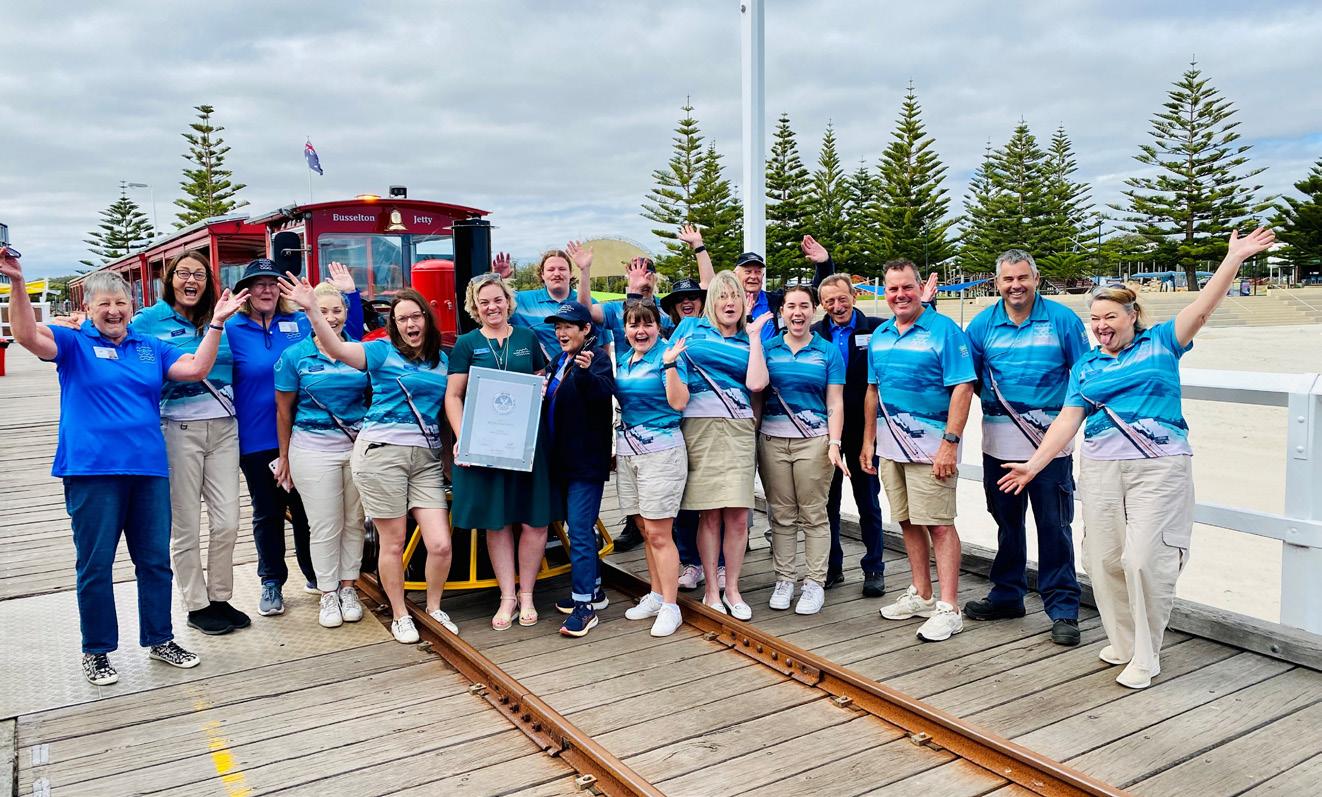
BJI follows a unique business model which sees tourism dollars paying for the long-term preservation of the Jetty structure. Annually, BJI contributes 25% of gross revenue to the Jetty Maintenance Reserve, held by the City of Busselton, to meet maintenance requirements. Additionally, 3% of annual profit is redirected to the Busselton Jetty Environment Foundation (BJEF), which achieves the organisation’s environmental objectives through marine education, conservation, and research.
BJI’s ticketed experiences currently meet maintenance requirements and operational costs, but ongoing development of business ensures financial stability into the future. BJI’s strategy is to offer new and fresh draws for visitation at varying price points, from sausage sizzle fundraisers major capital works.
In 2023, BJI completed one of its most ambitious projects to date –the installation of the Underwater Sculpture Park. With the Busselton Jetty structure already acting as an artificial reef, BJI saw that the fusion of art and science was the perfect way to connect visitors to the marine world. BJI was overwhelmed by amazing concept submissions from artists across Australia. A total of 13 objects by 12 local Western Australian artists was commissioned, creating 500m2 of marine habitat, with an estimated $7.3m tourism expenditure projected for the region in its first year of operation.
BJI values environmentally and socially responsible business decision-making, and building positive relationships with stakeholders, community, and visitors. BJI invests significant time into planning and research ensuring the business can meet its objectives and exceed expectations. The organisation is not afraid to try something new and is continuously adding new products and experiences. Maintaining a vibrant presence in the community ensures tour visitation remains high, and BJI can continue to raise funds for the preservation of Busselton Jetty.
Busselton Jetty is a physical reminder that today’s actions create our future legacy. BJI looks forward, recognising the community standing with us and that current work will preserve the Jetty’s future, whilst connecting people to the importance of marine environments. Upcoming projects include an on-shore Marine
Discovery Centre showcasing littleexplored marine habitats, expanded conservation and education programs, marine monitoring, citizen science engagement, and continued participation in global climate action through innovative partnerships to meet global climate targets. BJI’s legacy is one of leadership in sound governance, social inclusion, and environmental impact, both within Australia and globally.
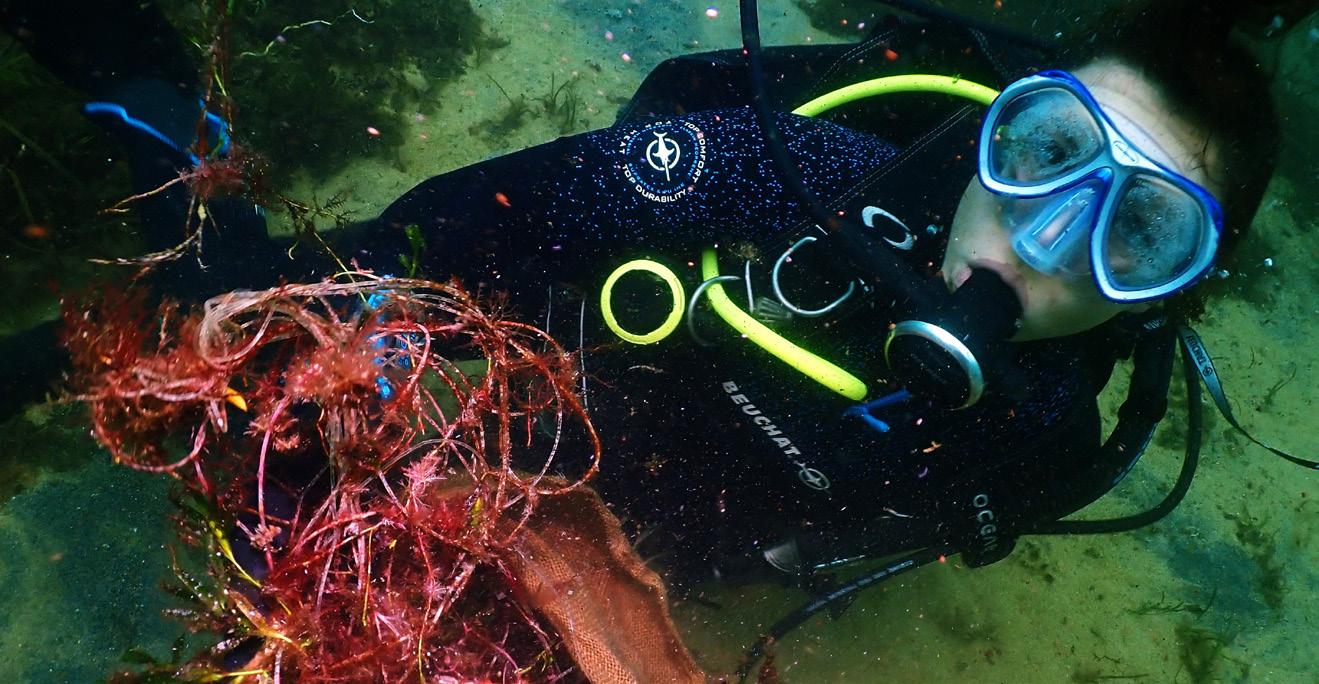
126
2024 NATIONAL SUSTAINABILITY SUCCESS STORIES
thinkstep-anz
thinkstep-anz is an independent sustainability firm with more than 50 experts across Australia and Aotearoa New Zealand
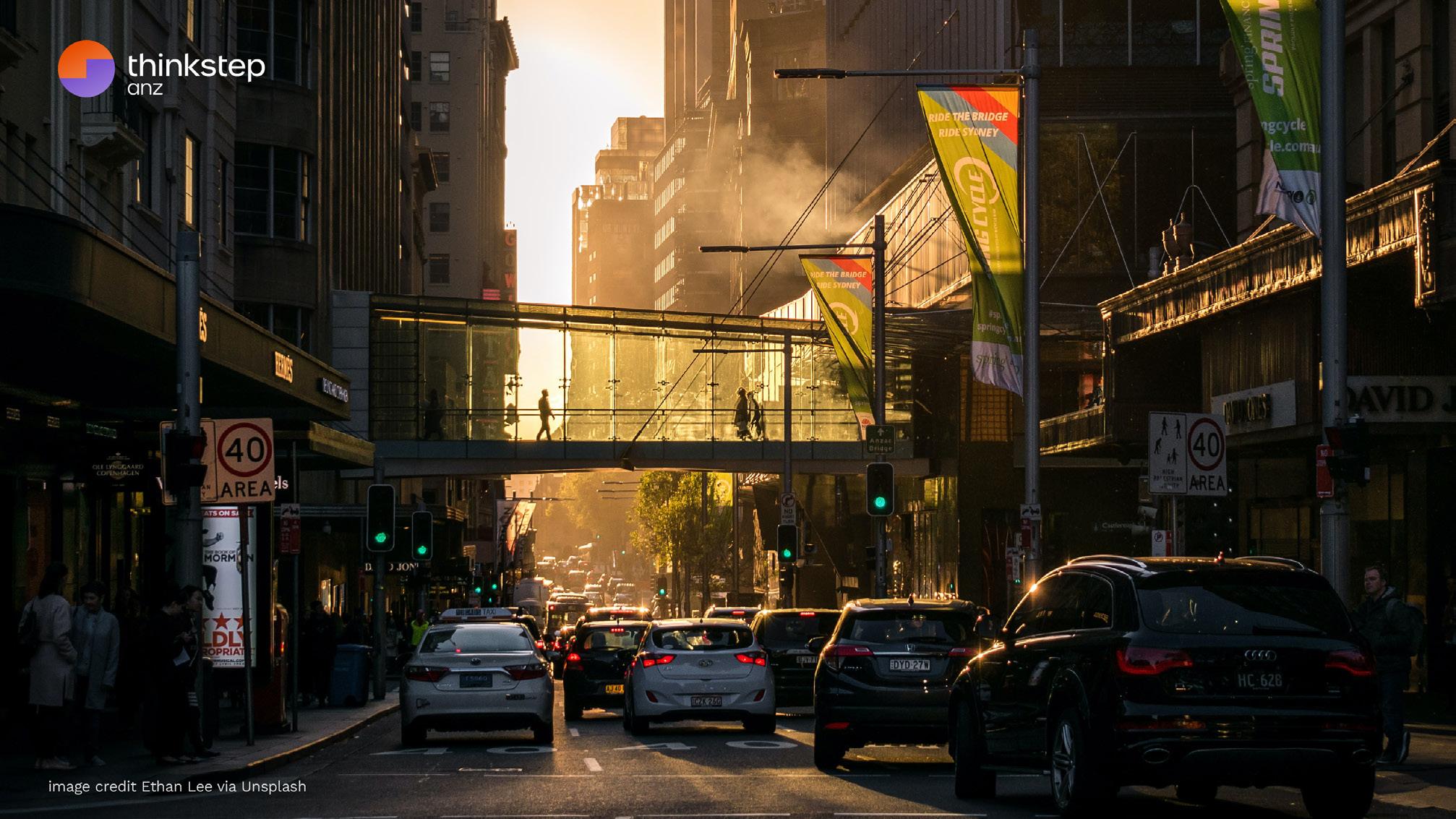
Supporting NABERS to develop an embodied carbon tool.
The challenge
Australia has an ambitious national emissions target. In 2022 NABERS (the National Australian Built Environment Rating System) engaged thinkstep-anz to help tackle an important source of these emissions – embodied carbon.
Website: thinkstep-anz.com






127
SME SUSTAINABLE LEADERSHIP AWARD
Embodied carbon emissions make up 10% of Australia’s total carbon emissions. They come from the materials that buildings and infrastructure are made of, from constructing and maintaining those assets and demolishing them at the end of their life. Embodied carbon is poorly understood and hard to solve.
The NABERS tools are sustainability ratings for the built environment. They help building owners understand how their building performs compared with similar buildings and to benchmark their progress.
NABERS wanted support to develop a new tool that would measure embodied carbon in buildings. The Green Building Council of Australia (GBCA) was an important partner: the two organisations’ rating systems need to be consistent.
Creating the new tool and building consensus
thinkstep-anz worked with NABERS and the GBCA to confirm how to measure, verify and benchmark embodied carbon in buildings. Research and technical analysis supported every stage of the project and considered market needs and the features of different buildings.
Engaging stakeholders to codesign the proposed approach and reach consensus was critical. thinkstep-anz partnered with Meld Studios (specialists in stakeholder engagement and strategic design) to achieve this aim. Together they engaged over 200 people from approximately 140 organisations across the building value chain from manufacturers to designers, builders and owners. This approach recognised that building trust, understanding and consensus takes time.
NABERS’ Embodied Carbon Rating Tool and Calculator
Based on the technical analysis, thinkstep-anz recommended the best approach to scope the tool and calculate, benchmark and certify embodied carbon. It also

recommended opportunities to develop the tool in future.
The resulting rating tool and calculator are practical and ready to use. They support the behaviour change urgently needed to reduce Australia’s carbon emissions. NABERS has consulted on the tool publicly and is likely to launch it in 2024.
This work shows the value of true stakeholder engagement –genuinely seeking to understand and acknowledge stakeholders’ positions, commercial needs and limitations.
At the start of the project thinkstepanz advised NABERS that industry was unlikely to agree on how to measure embodied carbon. After intensive engagement, 85% of the 78 respondents were likely/very likely to use or promote using the proposed rating tool to decarbonise, 11% were neutral and 4% unlikely/very unlikely.
'Having a highly skilled and experienced team which placed customer needs at the centre of the stakeholder engagement and technical design meant the project was able to achieve consensus [… ] ahead of public consultation. This would not have been possible without the highly collaborative nature of the team and thinkstep-anz’s relationships with manufacturers.' (Ivana BrownSector Lead, Accelerating Net Zero Buildings, NABERS)
thinkstep-anz is now working on other major projects in the built environment to help Australia meet its emission targets. The trust built up with industry on the NABERS project is benefiting these projects.
Creating the new tool and building consensus thinkstep-anz worked with NABERS and the GBCA to confirm how to measure, verify and benchmark embodied carbon in buildings
128
2024 NATIONAL SUSTAINABILITY SUCCESS STORIES
WaterGroup
WaterGroup through partnering with and leveraging the impact large corporations have to drive a sustained change in how water is used, understood, monitored, and managed.

Before the engagement with WaterGroup, Woolworths had poor visibility of water use in their supermarkets.
Website: watergroup.com.au/





WaterGroup promoted an all-encompassing water management strategy as part of their overall ESG commitments and to specifically drive commitment to SDG goals 8, 9, 11, 12, 13, and 17. Starting with a comprehensive evaluation of how water is used across the business, it identified the need for an online monitoring system to provide visibility into how much water each supermarket uses.
129
SME SUSTAINABLE LEADERSHIP AWARD
Since 2021, over 223,250 litres of water have been saved for Woolworths supermarkets alone
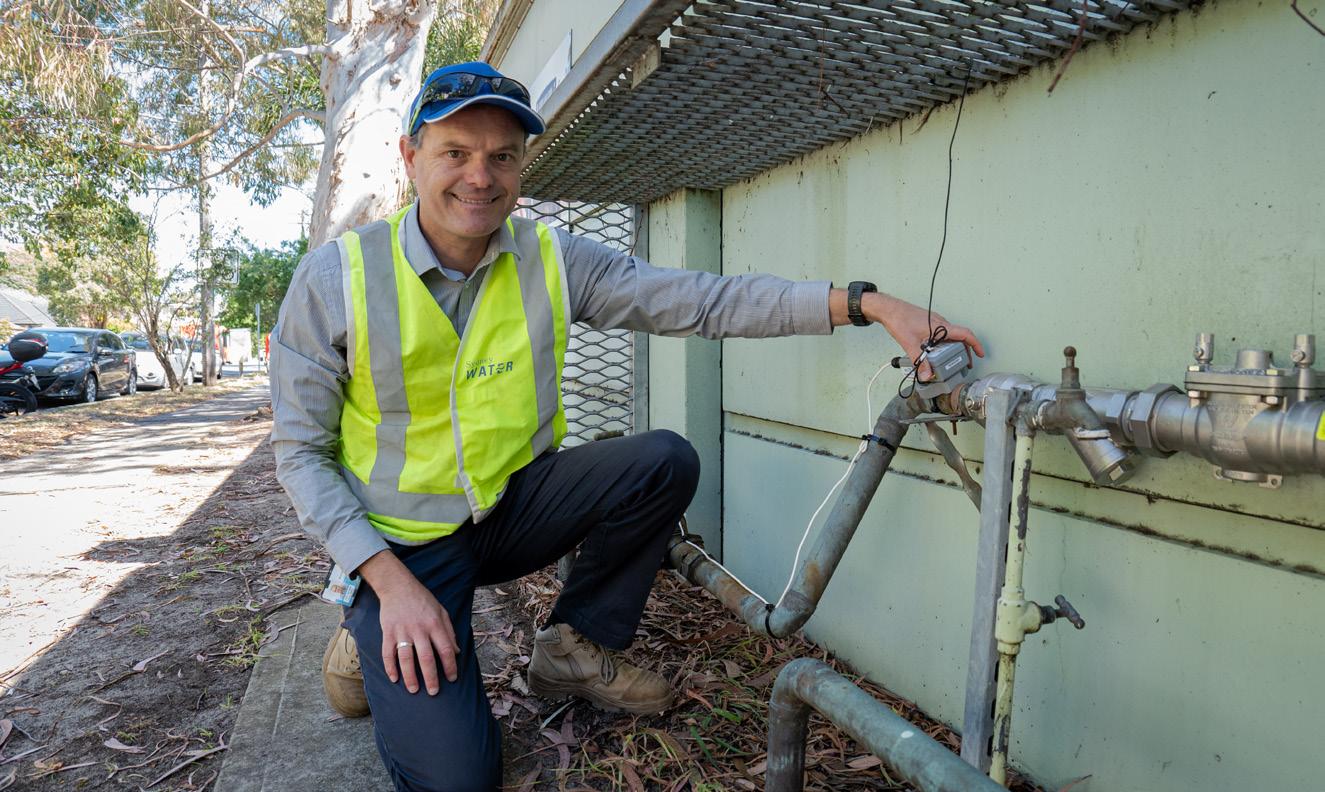
Most importantly, the company wanted to put a structure in place to ensure that corresponding corrective actions would be taken. For example, if the data indicated a leaking toilet, an equipment malfunction leading to excessive water use, or indeed a broken pipe, an arrangement had to be found that guaranteed that these issues would be addressed and not lost in the noise of day-to-day business operations.
WaterGroup's AWARE programme met that requirement. Its Active Water Analysis Risk and Efficiency service partners with others to drive those actions and record learnings. It then monitors and verifies the savings on an ongoing basis.
Its cloud-based water data visualisation and analytics platform, UtiliOS, was a key enabler to assist WaterGroup and Woolworths in achieving their ESG and SDG goals. It helped to streamline project delivery and drive efficiencies with these automation tools. All processes are continuously refined as more and more experience is gathered in close cooperation.
Since 2021, it has saved over 223,250 litres of water for Woolworths supermarkets alone. Due to the project's success, over 450 stores have enjoyed this water management solution in close cooperation with WaterGroup.
This has been used as a template to roll out similar programmes partnering with other supermarket chains and shopping centres.
When Sydney Water became aware of this cooperation opportunity, they asked WaterGroup to offer this programme to their business customers to extend and leverage savings. This project has saved over 455 million litres of water, saving $1.3M.
WaterGroup has extended its AWARE programme to cover more than 900 sites. On average, its water savings amount to 14% of the monitored water use, saving 2.3 billion litres of water and $7.7M since 2021. With an average Australian using about 180 litres of water daily, the savings equate to 12.8 million days of water saved.
With such a strong track record of monitored and verified water savings, achieved at very attractive payback
periods of under three years, it is no wonder that WaterGroup has strong indications that this programme will continue to extend its reach. It will help WaterGroup in its ambition to assist Australian businesses in becoming more water aware and meeting ESG goals and SDG objectives through the clever adoption of technologies with a human touch to ensure sufficient water for everybody, even in a drought.

130
2024 NATIONAL SUSTAINABILITY SUCCESS STORIES
131 Sustainable Leadership in the eCommerce Industry Award
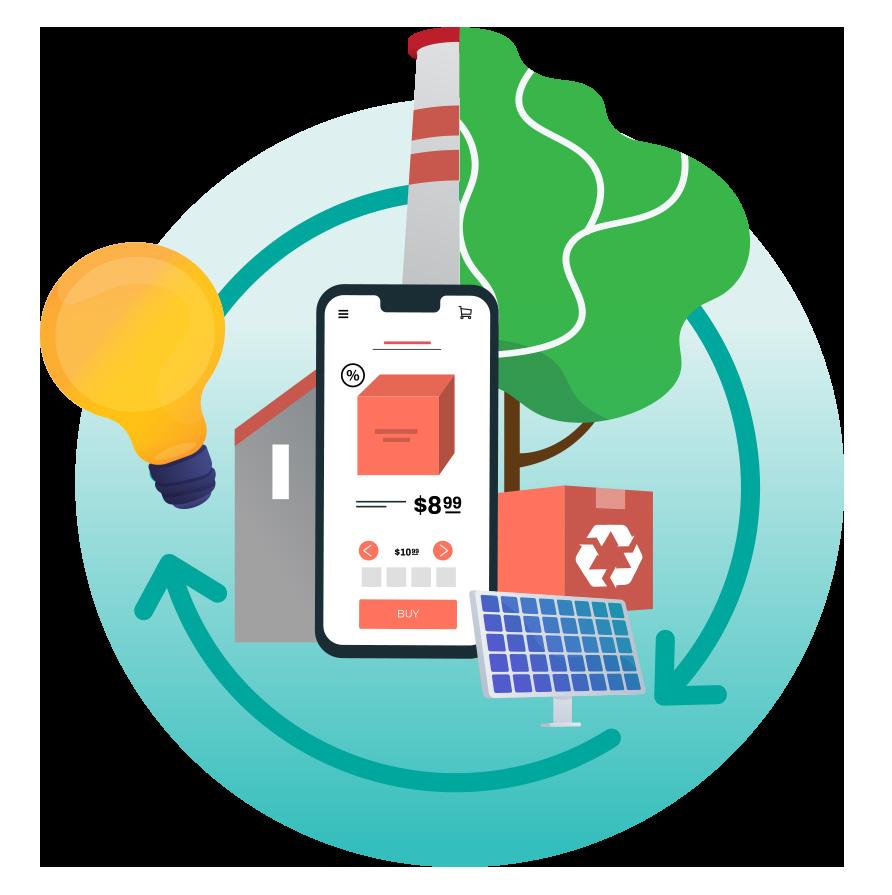
Underwear for Humanity
Planet & People first - A radical new approach to conscious consumption.

The apparel and textile industry use over 5,000 chemicals, are responsible for 8-10% of global emissions and over 20% of global water pollution.
33% of clothing purchased in Australia is discarded within one year. The rate of production and consumption is not slowing down, it is speeding up. Underwear for Humanity (UH) is changing the industry standard on textile production, manufacturing, recycling and addressing the social impact that our current system fosters.
Website: underwearforhumanity.com.au/











133
SUSTAINABLE LEADERSHIP IN THE ECOMMERCE INDUSTRY AWARD
WINNER 2024
National Homeless Collective; Social Engine
Clothing like many industries is based on a linear model, of extracting resources from the earth to create a garment, then discarding at the end of its life. Some items are donated to charity, although only 15% is sold, but underwear cannot be donated due to hygiene reasons. With 204 million underwear items being imported into Australia every year, that leaves 204 million items destined for landfillUntil now!
UH is pioneering the way forward and changing the industry as the only company that accepts underwear for recycling in Australia. As a result they have thus far processed 13,959 items, and donated 761 bras in wearable condition to the charity ‘Support The Girls’, averting from landfill. UH has plans of expansion to allow retail drop off points open to the public. The sales of their underwear funds the recycling, but not just any underwear. Founder, Kelly Barrett has over 20 years experience in underwear development and is a sustainability specialist in her field. The material science used has resulted in emissions being more than half industry standard for a similar product. The brand developed its own 100% recycled elastic, it delayed their launch by 6 months and continues to delay shipments due to the unstable global supply of recycled fibre market, but compromise is not what UH represents.
Rather than operating solely for profit, they use the money from their sales to invest into the community. This includes free underwear to people in need via their one-for-one program, donating to women’s shelters and various homeless charities. 50c is paid to Aboriginal groups as rent payment for the land they work on. Their pick and pack is a partnership for a work training program.
They heavily invest in ethical production and work with certified ethical factories that pay 60% above the living wage. They are hyper focused on the reduction of fossil fuel

use which resulted in an agreement with their factories to install solar to do their production.
Whilst the rest of the apparel industry ships in single use plastic poly bags, Underwear for Humanity ships in reusable shipping bags that they developed, resulting in zero waste deliveries.
UH is a 100% female owned and operated brand, it is B Corp certified and carries a long list of certifications to ensure it is a greenwashing free zone.
Whilst we are in a climate crisis and sometimes it feels like change is slow, seeing models such as Underwear for Humanity thrive shows what is possible and how the future can be. The brand has a strong following of loyal customers that is growing 30% each six months, the more they grow the less extractive underwear brands are bought.
This new type of business model is part of the next economy where nature and humans are prioritised. Where we live as a community, supporting each other, rather than a constant bid for our money.
The brand has a strong following of loyal customers that is growing 30% each six months, the more they grow the less extractive underwear brands are bought

134
2024 NATIONAL SUSTAINABILITY SUCCESS STORIES
TWOOBS
TWOOBS is on a mission to save the planet... but make it fashion!
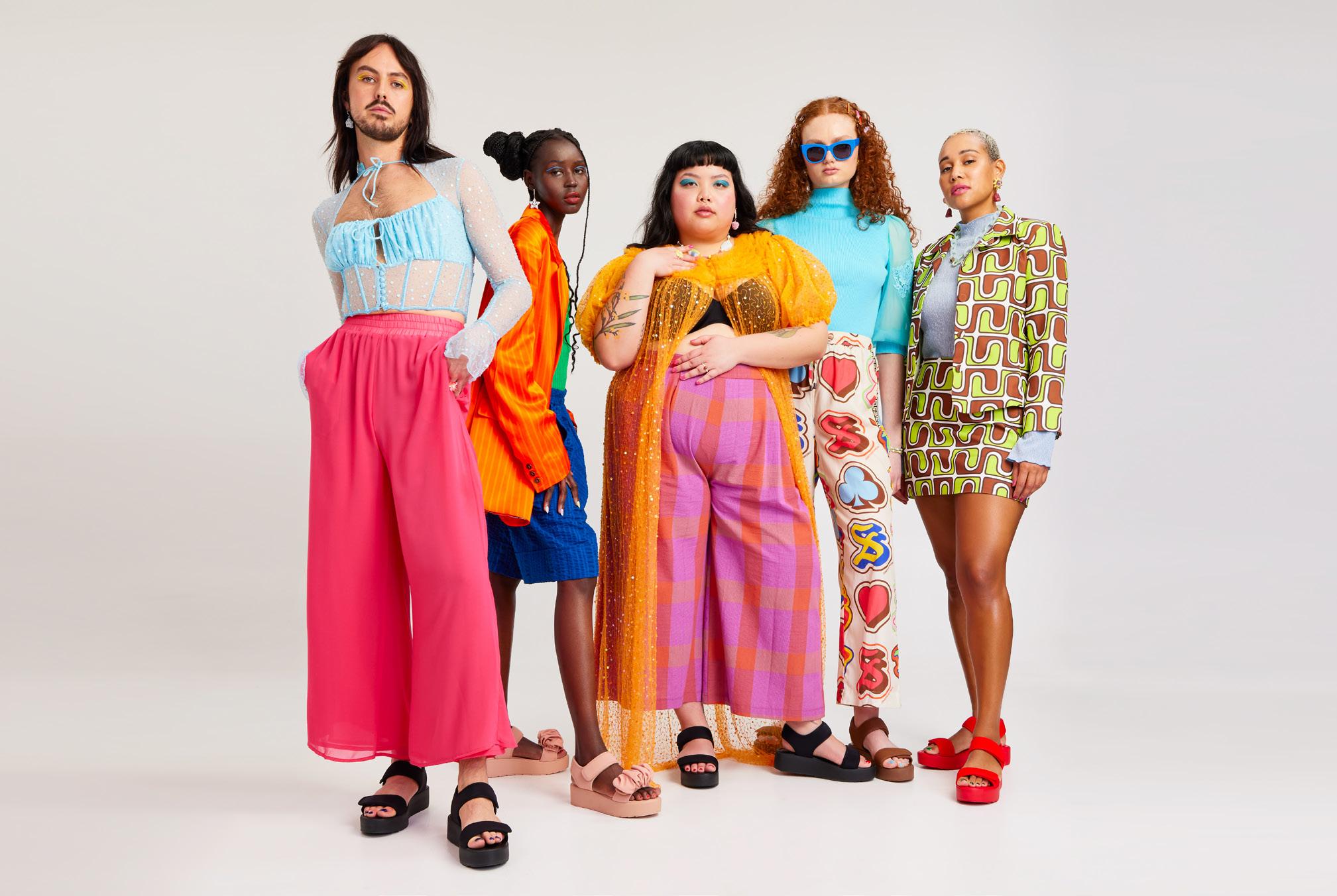
TWOOBS is on a mission to lighten fashion's impact on the planet, one pair of shoes at a time.
The brand creates comfortable, accessible & beautiful footwear designed for longevity & durability, crafted from better materials like recycled plastics & carbon-absorbing sugarcane. They are cruelty-free, carbon offset, & recycled by TWOOBS when you are done.
Website: twoobs.com





135
SUSTAINABLE LEADERSHIP IN THE ECOMMERCE INDUSTRY AWARD
Since an environmentallyfocussed pivot in 2020, the brand has cemented itself as a leader in sustainable footwear. Their innovative products & sustainablyminded approach to doing business is impressing industry, peers, & customers, with TWOOBS seeing a massive increase in brand awareness, social media following, & media attention, particularly over the past 2 years.
Since the environmentally-focussed relaunch in late 2020, TWOOBS’ customer base has exploded, highlighting consumers' desire to shop their values. The brand has seen impressive growth, including a 246% increase in ecommerce sales yearover-year, & acquired over 30,000 new customers since the pivot.
TWOOBS changed the way it designed collections; trend based products were replaced with timeless designs. Initially customers were resistant to the shift as they wanted the products they knew & loved, so in response TWOOBS designed "Thingys", a first-of-their-kind shoe attachment, a solution to transform the shoes into a different product without buying a new pair. TWOOBS also redesigned its packaging to become satchel free & delivered in a FSC certified recycled paper box. In addition to working towards sustainability, TWOOBS has fostered a community of people who care about the planet. A big part of TWOOBS’ impact is the conversations it ignites around sustainability with its 65,200 strong Instagram following (127% growth since before environmental pivot) & 13,300 TikTok followers (2560% growth), educating people on conscious consumerism & sustainability, with positive & enlightening content.
TWOOBS is a public advocate for environmentally-focused fashion & conscious consumerism, featuring in media such The Project, Australian Financial Review, The Age, Broadsheet, Smart Company,

7NEWS & more. TWOOBS has created demand for better products, educating consumers on how to spot greenwashing, & how to write to brands asking them to do better.
What sets TWOOBS apart from other brands is its ability to talk about sustainability in a positive & digestible way, connecting with customers & other brands alike, with studies showing that inspiring people into action is more effective than a fear-based approach. TWOOBS engages in open & honest dialogue about the planet & what the brand is doing, whilst never claiming to be perfect & always being transparent about areas that could be improved.
By creating shoes that are better for the planet, TWOOBS’ future plan is to continue taking market share away from the big players in the fashion industry who are not focussed on sustainability. TWOOBS’ is shifting the industry, constantly receiving feedback from other brands & even university students who have said that they used TWOOBS as a case study for best-practice.

136
2024 NATIONAL SUSTAINABILITY SUCCESS STORIES
137 Sustainable Tourism Award

Intrepid Travel
Intrepid Travel is a certified B Corporation with the mission to create positive change through the joy of travel

Intrepid has had a long-standing commitment to sustainability throughout its 34-year history. Intrepid was the first tour operator to introduce a responsible tourism department in 1998, achieved carbon neutrality from 2010 by measuring and offsetting all its emissions, and halted elephant riding on its tour products in 2014.
In 2018, Intrepid Travel went a step further to become a certified B Corporation where it measures and audits its impacts on the environment, workers, community, customers, and governance. Intrepid Travel achieved its first B Corp certification in 2018 with a score of 82.7 and has since improved its score by 10 points to 91.2 in its latest B Corp recertification in 2021.
Website: intrepidtravel.com/au



139
SUSTAINABLE TOURISM AWARD
WINNER 2024
In 2023, Intrepid redeveloped trip emissions in line with the best-practice requirements set by the Climate Active Carbon Neutral Standard, and as a result, redesigned their top 50 trips to remove at least 3,000 flights and include carbon labels to over 500 of their trips.

Intrepid Travel improved its B Corp score and delivered results on its overall Purpose strategy by embedding a consistent approach towards sustainable action through its Purpose team, implementing structural changes and resource investments, such as ensuring one of its six annual company goals is purpose-related, and being transparent and accountable about their impact journey via an annual Integrated Report.
Travel accounts for 8 per cent of the world’s carbon emissions annually, making climate action a key focus for Intrepid Travel. Intrepid has a longstanding commitment to climate action, self-declaring carbon neutrality in 2010 and becoming Climate Active carbon neutral certified and the first tour operator to implement near-term Science Based Targets in 2018. In 2023, Intrepid redeveloped trip emissions in line with the bestpractice requirements set by the Climate Active Carbon Neutral Standard, and as a result, redesigned their top 50 trips to remove at least 3,000 flights and include carbon labels to over 500 of their trips.
As part of its efforts to drive inclusive impact and reduce inequality, Intrepid has completed two Reconciliation Action Plans (RAP), including a Reflect and Innovate RAP from mid-2020 to mid-2023.
Intrepid has raised awareness surrounding colonialism, land dispossession, and racism and strengthened relationships between Aboriginal and Torres Strait Islander peoples and non-Indigenous peoples through increasing First Nationsled experiences from 12 to 50 in Australia.
Intrepid Travel’s not-for-profit organization, The Intrepid Foundation, was established in 2002 to empower customers to make a positive impact on the communities they visit and has distributed $14 million to over 160 communities. To deepen customer engagement with local issues, Intrepid aligned Foundation partner organisations with every trip (over 800 products). Intrepid makes a company donation
on behalf of every traveller and inspires customers to give to a local cause upon return. To date, Foundation partners have increased from 20 to 49 partners in more than 30 countries, spanning 11 SDGs.
By retaining its B Corp certification while growing the size and scale of its business, Intrepid is demonstrating that B Corps can be larger, purposeled businesses that are commercially successful. Intrepid’s vision for its legacy is that it demonstrates that scaling positive impact is possible while decarbonising and growing demand for sustainable travel, creating a blueprint that the wider tourism sector can replicate so that travel can be here for generations to come.

140
2024 NATIONAL SUSTAINABILITY SUCCESS STORIES
Fun Over Fifty Holidays
Fun Over Fifty Holidays has undertaken an Our People and Planet Program engineered on the UN SDGs, minimising negative tourism impacts and delivering positive impacts on the environment, culture and local communities they tour nationally
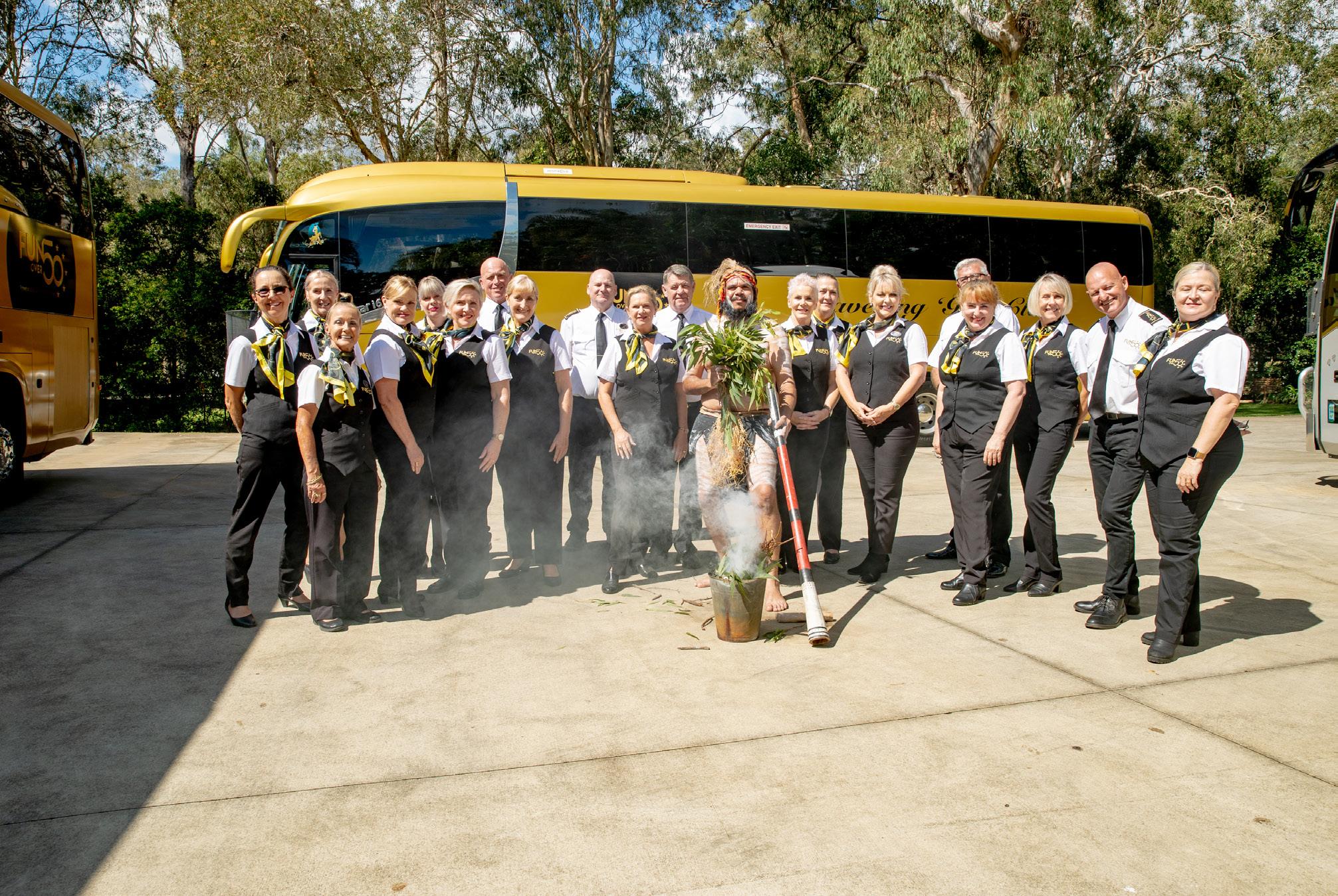
“Wunya”
Welcome to Fun Over 50 Holidays (FOFH), a locally owned and operated all-inclusive holiday and touring business, based in Springwood, Meeanjil (Brisbane) on Yugarabul Country.
Curating immersive eco and cultural tourism experiences, during 2022-2023, 2,482 FOFH guests experienced Advanced Eco-certified tours in every state and territory of Australia, touring 126 Aboriginal Nations, including six eco-accredited destinations and ten natural UNESCO World Heritage sites.
Website: funover50holidays.com.au/








141
SUSTAINABLE TOURISM AWARD
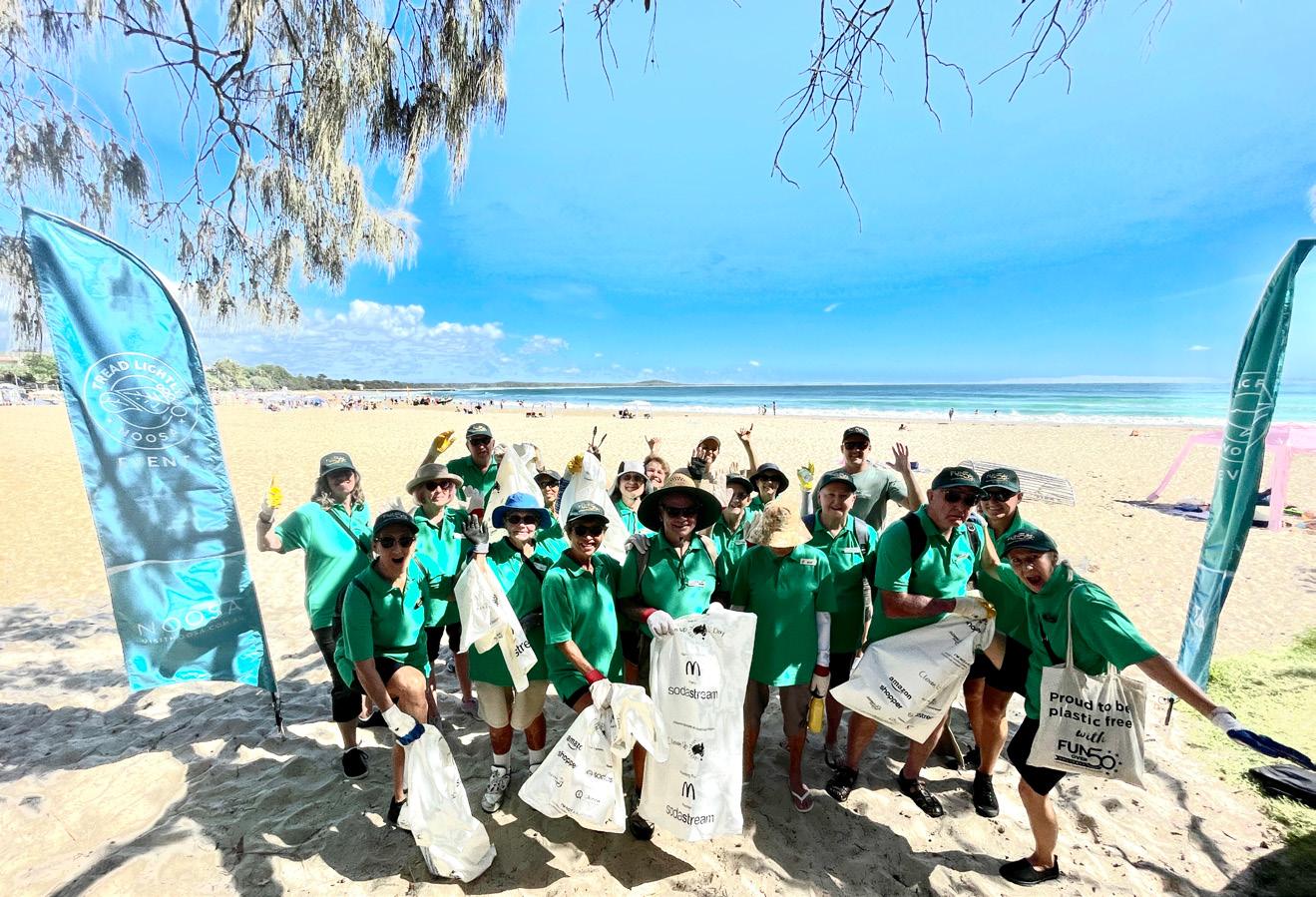
With a vision to be recognised as “The most sustainable tour operator in Australia”, FOFH has undertaken a significant sustainability journey, through its Our People and Planet Program (OPPP).
The OPPP, a quadruple-bottom-line framework engineered on the United Nations Sustainable Development Goals measures their impact to achieve social, cultural, economic, and environmental sustainability.
During their sustainable journey from 2021 to 2023, FOFH developed initiatives to offset negative tourism impacts of touring while concurrently delivering positive impacts on local communities and natural environments they visit.
Advancing the United Nation’s Sustainable Development Goals (SDGs), just some of their initiatives included:
A partnership with Greenfleet to reduce carbon footprint of their travel achieving 100% travel offset of all guests, staff and 3rd party coach emissions, offsetting 994 tonnes CO2e., advancing SDGs 13, 15, 17.
Their Green Bank trust and Helping Hand Holidays, where FOFH and guests invest and partake in handson initiatives such as language preservation of the Miriwoong
language in WA, wildlife rehabilitation of turtles on Quoin Island, and environmental rehabilitation investing in coral planting, advancing SDGs 4, 14, 15.
They further enhanced their Green Guest Policy (GGP) to reduce energy consumption, water and waste where FOFH guests are incentivised to waive daily room servicing.
In an Industry-first, FOFH partnered with EarthCheck to develop a calculator which improves reporting to encourage increased numbers of guests and accommodation suppliers to participate in the GGP, by showing the positive role they play in reducing waste/water/energy consumption.
Participation in the GGP increased significantly, with hotel participation
increasing by 28%, and guest participation increasing by 23% in 2022-2023.
FOFH’s GGP reduced daily servicing of 697 rooms, saving 1,847 kg of laundry, 14,288 megajoules of electricity, 753kg of emissions, 16,993 litres of water and 3,391 litres of landfill waste!
So successful was the EarthCheck Calculator and GGP program, FOFH shared the process with 800 Queensland Tourism Industry Council (QTIC) members, as a tool to encourage greater measurement and accountability, advancing SDGs 12 and 13 as a sustainable consumption pathway to combat climate change and achieve environmental sustainability.
Most recently FOFH received the highest accolades at the 2023 Queensland Tourism Awards for their work in sustainable tourism, achieving gold in Ecotourism and being inducted into the Hall of Fame for their work in Cultural Tourism.
“We’re very focussed on grassroots give-back. We not only financially contribute but actively contribute to environmental, wildlife and cultural conservation and rehabilitation, where our team and guests work side-by-side during tours to ensure a long-term legacy, “says Toni Brennan, CEO, and company founder. “Let’s show once and for all, sustainable tourism can make a difference and be fun!”

142
2024 NATIONAL SUSTAINABILITY SUCCESS STORIES
Take 3 for the Sea’s Ground Swell Litter Prevention Program
Ground Swell is a coordinated, whole-of-industry approach to rolling out litter prevention strategies for the NSW visitor economy industry
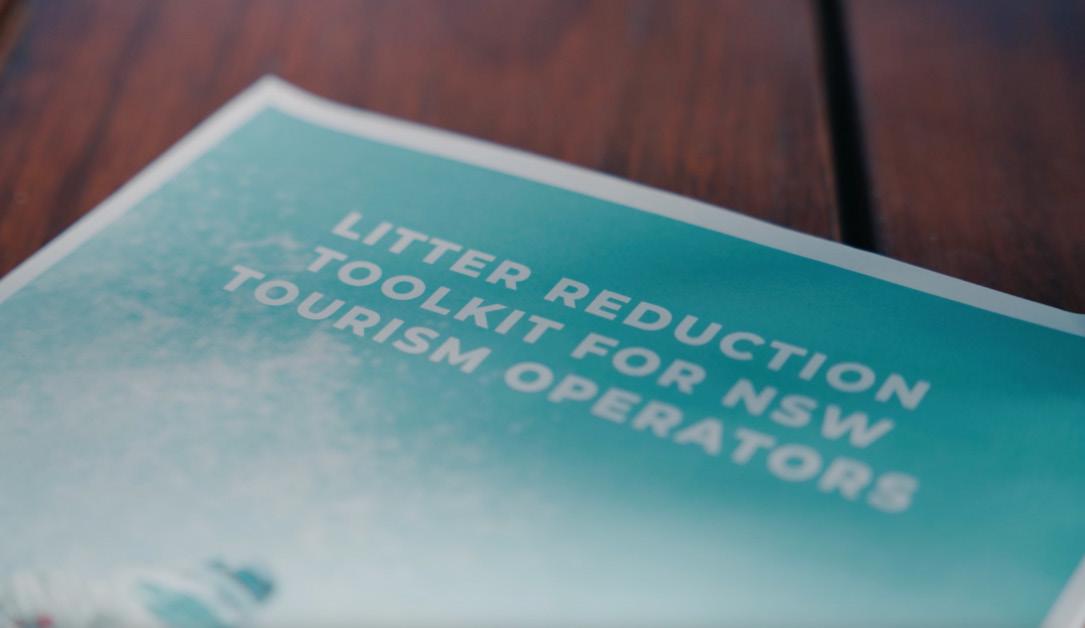
Take 3 for the Sea‘s Ground Swell Program envisions litter-free destinations; empowering the Visitor Economy Industry (VEI) to prevent and reduce the impact of visitor litter and waste. Ground Swell educates and inspires businesses to be responsible for litter/waste prevention and to encourage their domestic and international visitors to do likewise.
Beautiful litter-free destinations attract visitors. High concentrations of litter significantly impact locations by discouraging visitors, impacting economies and harming wildlife.
Website: take3.org/





143
SUSTAINABLE TOURISM AWARD

Ground Swell’s goal is to inspire ownership of visitor litter by creating awareness, inspiring partnerships, and developing resources to enable VEI businesses to address their litter issues. “Ground Swell is an Environment Protection Authority, Waste Less Recycle More initiative funded by the waste levy.”
Ground Swell’s significant impact on long-term litter reduction in the NSW VEI, contributes to SDGs#14 and #6 by reducing the amount of litter entering NSW waterways. SDG#12 by raising visitors’ awareness of responsible consumption/waste disposal, SDG#13 by informing visitors of the plastic/climate change connection and SDG#17 inspiring partnerships to reach the goals.
Industry leaders have joined forces with Take 3 to inspire and empower the industry to own it and act on litter with the development of the NSW VEI Litter Prevention Strategy and Litter Reduction Toolkit or resources.
Over 54,000 visitors have already been educated on visitor litter as a direct result of Ground Swell. 160 NSW VEI businesses have so far engaged in the program with inspiring results.
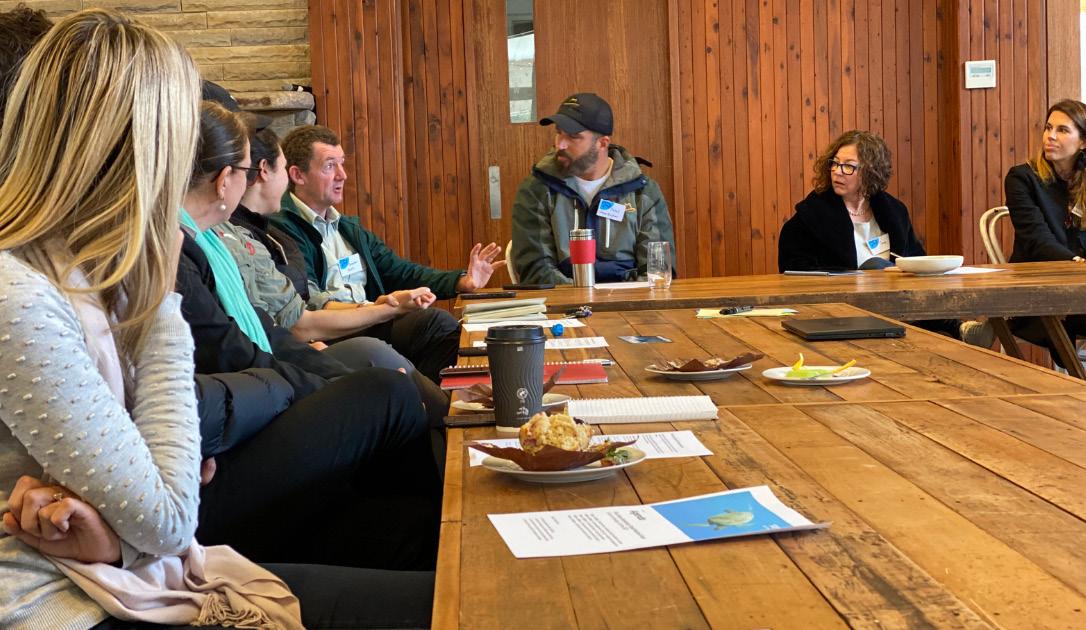
Examples include:
ECONOMIC
Glenworth Valley: reported 15% reduction in litter; collected 22,180 items in ‘Return and Earn’ containers, preventing landfill/litter and generating $2,218.
Youthworks: reported bottom-line improvements by eliminating plastic wrap and packaging for lunches. "Often organisations have this false idea that change will be big and costly but this project showed us that it's not the case.“ Sophie Fenner, Youthworks Christian Outdoor Education
ENVIRONMENTAL
Southern Cross Kayaking: eradicated 100% of single-use plastics; removed 20kg of litter per Colo/Hawkesbury tour; and reported a 20% reduction in litter around Ganguddy-Dunns Swamp, Wollemi National Park.
Melaleuca Backpackers: reported 4,205 pieces or 131.5kg of litter collected over 15 trips and encouraged guests to Take 3.
SOCIAL
C Change Adventures: educated 3000+ visitors on litter prevention by
including litter prevention/actions in their communications and face-toface storytelling.
Melaleuca Backpackers: reported 100% of guests (2,800) educated in litter prevention; requested their linen provider not wrap clean linen in plastic and use a reusable bag; and advised guests how to separate waste correctly.
Ground Swell's innovation lies in the bottom-up approach that takes participants beyond the obvious ‘first aid’ of litter clean ups to active litter prevention, providing a valuable deeper layer of education to those dependent on tourism in any natural ecosystem
The program’s strategy takes an industry and sector approach, creating awareness and engaging VEI businesses/stakeholders who subsequently educate their visitors to own it and act on litter.
Active Litter prevention hubs have formed organically due to the collaborative nature of the program, resulting in communities leading and empowering others to take action and demonstrate pride in their destination.
Over 54,000 visitors have already been educated on visitor litter as a direct result of Ground Swell. 160 NSW Visitor Economy Industry businesses have so far engaged in the program with inspiring results.
144
2024 NATIONAL SUSTAINABILITY SUCCESS STORIES
Wild Adventures Melbourne
The Micro Tour Operator Built to Be Regenerative with a Multi-Faceted Sub-Zero Waste Blueprint That’s Redefining How Tourism Can Be Delivered

Wild Adventures Melbourne (WAM) is a micro ecotourism operator offering extraordinary multi-activity ecoadventure tours of the Mornington Peninsula and other parts of Victoria connecting small groups with spectacular nature and local communities.
WAM's blueprint demonstrates how tourism can be a force for good on a micro-budget, while infusing positive impact holistically across the entire business. Website:








145
SUSTAINABLE TOURISM AWARD
wildadventuresmelbourne.com/

WAM has developed an innovate multi-faceted approach to reverse the issues of waste caused by tour operators through 4 immersive strategies:
Strategy 1: Eliminate the Customer Need to Generate Plastic Waste
WAM provides all guests joining a tour with specially curated ecopacks containing eco friendly reusable items from local conscious businesses including a reusable water bottle, reusable coffee cup, eco towel service, and a sustainable reusable straw gift. The packs have enhanced the customer experience and benefitted the environment and community.
The eco-packs have enabled WAM to operate tours at zero-waste by eliminating the need for customers to generate any plastic waste such as coffee cups, water bottles etc.
Strategy 2: Enhance Customer Service Through Waste Reduction Practices
Free reef-safe sunscreen for all!
As WAM offers amazing ocean activities including stand-up paddleboarding, snorkelling and rock-pool swims, they wanted to guarantee all customers were not wearing a sunscreen which is harmful
to the ocean and marine life. WAM partnered with a local small business called Sunbutter to provide a reef-safe, plastic-free sunscreen to all customers joining a tour.
In the last year, WAM guests have gone through over 4.4 kilos of reefsafe sunscreen preventing toxins from other sunscreens entering the marine ecosystem.
Strategy 3: Improve Community Sentiment Through Waste Initiatives
In addition to providing eco-packs to operate tours at zero-waste, WAM also carry portable bins on all activities so that if they see any rubbish and plastic waste in the nature spots visited, it is picked up aiming to leave each place cleaner than they found it.
WAM carries portable bins on Stand Up Paddleboards, Hiking backpacks, and bikes. Locals often see WAM collecting rubbish and comment on how much of a good thing they are doing which helps improve community sentiment.
In the last year WAM picked up over 680 litres of rubbish from oceans, beaches, inland waterways, and parks where they operate.
Strategy 4: Utilising waste to Generate Funds for Local Environmental Projects
WAM wanted to close the loop, to find a way of collecting plastic waste, turn it into a simple useful item which could be sold to generate funds for further ocean clean-ups and conservation.
The solution for WAM was to start making drinks coasters out of plastic waste launching an initiative called Coasters 4 Coasts. Coasters 4 Coasts are beautifully crafted drinks coasters which are sold across the Mornington Peninsula, with 100% profits from sales going back to support local marine conservation projects.
The foundations of the business have been built to be regenerative and WAM is on a mission to redefine how tourism can be delivered in Australia to have a positive impact on all aspects of the environment and community.
WAM partnered with a local small business called Sunbutter to provide a reef-safe, plastic-free sunscreen to all customers joining a tour.
146
2024 NATIONAL SUSTAINABILITY SUCCESS STORIES
Messages From The 35th National Banksia Sustainability Awards’ Sponsors
147
147
148

Sponsor of the Sustainable Leadership in the eCommerce Industry Award
Australia Post has been delivering for all Australians for more than 200 years. We are continually evolving to meet the changing expectations of our customers and communities and to deliver a better tomorrow.
We’re at the heart of every community and as one of the nation's largest businesses, we believe we have a responsibility and an opportunity to create a more sustainable future that benefits all Australians.
Therefore today, sustainability is a key pillar of Australia Post’s enterprise strategy, underpinning everything we do for the planet, people and prosperity. From delivering more focused and strategic community partnerships to building Australia’s largest electric delivery vehicle fleet, we embrace our power to make a difference.
Our 2025 Sustainability Roadmap outlines what we will do to deliver on a future that sees us meet the needs of the present, without compromising the ability of future generations to meet theirs. It's our most ambitious environmental agenda to date and we recognise our unique position to make a positive impact.
We are proud of our achievements over the last financial year. We increased our recycling rate to 69% of total waste, generated 27% more electricity
ourselves via rooftop solar, and spent $42m with Social Enterprises and Indigenous Businesses. We launched our first Sustainability Bond and announced a new community partnership with World-Wide Fund for Nature - Australia.
We continued to reduce the impact of sending parcels and celebrated a 10% reduction in our carbon footprint. Achieving our 2025 emissions reduction target, which has been validated by the Science Based Target Initiative, will help to put Australia Post on the road to Net Zero emissions by 2050.
Our enduring support of the Banksia Foundation evidences our desire to support sustainability leaders across businesses and sectors. We value this opportunity to pause and reflect on both the individuals and organisations that that are demonstrating how business can be a force for good.
We sponsor the Sustainable Leadership in the eCommerce Industry Award to recognize online retailers who are leading the way in sustainability and exhibiting innovation throughout their value chain. We look forward to seeing this category grow in scope and sophistication so that we’re able to celebrate and share more of the bold new ideas that are making online shopping more sustainable.
149

Sponsor of the Healthy Planet, Healthy People Award
As a global healthcare company, Bupa has been looking after people’s health for over 75 years, including supporting more than 5.5 million customers across Australia through a broad range of services including health insurance, aged care, dental, optical, medical and medical visa services.
We understand that delivering healthcare has an environmental impact and are committed to not only reducing our own emissions in line with scientific recommendations, but also the emissions of our suppliers and partners. That’s why we are accelerating our work to become a Net Zero business by 2040. This includes the utilisation of 100 percent renewable electricity to fulfil the needs of our Australian operations and providing funding and support for sustainable start-ups through our ecoDisruptive program.
With a focus on responding to issues that are critical to the physical, mental and environmental health of communities, the Bupa Foundation has invested more than $37 million in partnerships and programs.
At Bupa, we consider it vital to lead with actions to ensure we can deliver on our purpose of helping people live longer, healthier, happier lives and making a better world.
A key part of our sustainability strategy is to support organisations and events that share our commitment to sustainability, biodiversity and creating healthier
cities. Through our partnership with the Banksia Sustainability Awards, we were both proud and humbled to help shine a light on businesses and people that are helping to create a healthy planet for healthy people through the Banksia Healthy Planet, Healthy People Award.
We have some significant environmental ambitions, but we know that there is a lot more work to do and we can't solve challenges like climate change on our own. We need everyone to play their part and we need to act with a sense of urgency.
We congratulate all winners on the work they have undertaken to date and hope this Award can act as a springboard to inspire further sustainable action and understanding of how people's health is impacted by the health of the planet.
150
2024 NATIONAL SUSTAINABILITY SUCCESS STORIES

Sponsor of the Marketing and Communications for Impact Award
For more than 30 years, Currie has been working with those who strive for a kinder, safer, and fairer future for all.
We counsel and collaborate with leaders and organisations to help to turn their visions into strategies, stories and engagements that help build a better world.
As a B Corp ourselves, we know the journey of a ‘business for good’ is one of continual improvement, and we believe in the power of the truth-telling through this process.
That’s why we sponsor the Banksia Marketing and Communications for Impact Award.
Through shining a light on the businesses and initiatives in this category, we hope to inspire others to take up the challenge and play their part in leaving a happy and healthy world for future generations.
Congratulations to the finalists on their achievements and progress so far.
151

Sponsor of the Responsible Supply Award
Did you know that you hold the power to change the world? It lies in the ethical choices made by both consumers and organisations when sourcing goods and services.
This is precisely why Informed 365 is delighted to sponsor the Banksia Ethical Sourcing Award.
For more than a decade, Informed 365 has stood as a proud partner of the Banksia Foundation, sharing a vision of a world where businesses transcend from being mere entities to become forces for good.
It has been truly rewarding to be part of Banksia's evolution and seeing hundreds of worthy organisations recognised and celebrated by the Foundation over the years.
Our partnership reflects a shared dedication to recognising and celebrating organisations that embody the principles of ethical sourcing, sustainability and social responsibility.
The heartbeat of Informed 365's mission resonates with the belief that when organisations align
themselves with 'good' companies, a ripple effect of positive change is set into motion.
As a leader in responsible business practices, Informed 365 is committed to eradicating modern slavery within supply chains and aligning businesses with ethical practices and their legal obligations.
Environmental stewardship is also a key focus, with strides needed to reduce our carbon footprint and embed more sustainable operations.
Positive change can begin from any corner of the world, and we are determined to continue pushing the boundaries of what's possible.
That’s why our sponsorship of the Ethical Sourcing Award is not just an endorsement of ethical sourcing; it is a rallying cry for businesses, both large and small, to embrace their role as catalysts for positive change.
Let's collaborate to create a world where businesses thrive in harmony with people and the planet.
152 2024
NATIONAL SUSTAINABILITY SUCCESS STORIES

Sponsor of the Diversity, Equity & Inclusion Award
For over a century, L’Oréal has been dedicated to one sole vocation: creating beauty. Our goal is to offer each and every person around the world the best of beauty in terms of quality, efficacy, safety, sincerity and responsibility to satisfy all beauty needs and desires in their infinite diversity. At L’Oréal, our purpose is to Create the Beauty that Moves the World, and central to this is our commitment to make a positive impact on both people and planet.
Through our L’Oréal For The Future program, we are acting to ensure we operate within the limits of the planet, as defined by environmental science. We are also tackling our indirect, extended impact related to the activity of our suppliers and the use of our products by consumers. Further, we want to take on greater responsibility by allocating 150 million euros towards helping address some of today’s most pressing social and environmental challenges.
We are very excited this year to be supporting the Diversity, Equity and Inclusion Award at the 35th National Banksia Sustainability Awards. At the L’Oréal Groupe, our mission is to be the most inclusive beauty leader and contribute to a society in which everyone can live safely, peacefully, and equally. We believe that our team members and suppliers must reflect the world’s diversity, in order for us to meet our consumers’ needs and respond to their many and varied ideals of beauty. We know that supporting Diversity, Equity and Inclusion requires more than words, it must be backed up by concrete, on-the-ground, tangible and measurable actions, which is why we are so looking forward to celebrating the organisations that are championing diversity and inclusion in all facets of their operations and initiatives.
153
Sponsor of the Circular Economy Award
Melbourne Convention and Exhibition Centre (MCEC) is the home of unconventional. We do things a little differently at MCEC by turning concepts on their head to make each experience memorable.
We welcome events of all shapes and sizes, from meetings and conferences to exhibitions, concerts, and galas, whether in-person, virtual or hybrid.
As the home of the National Banksia Sustainability Awards Gala, we’re proud to host sustainability leaders and innovators from across Australia and are delighted to sponsor this year’s Circular Economy award.
At MCEC, we’ve championed environmental sustainability for a long time, with the goal to improve our performance year-on-year. We’re built on solid foundations, being the first convention centre in the world to be awarded a 6-star green environmental rating and our exhibition expansion has a 5-star green rating. Our vision is to “lead extraordinary environmental change and amplify our social impact by forging partnerships and inspiring our people to leave a positive legacy”.
Underpinned by the principle of a low carbon and circular economy, our sustainability strategy commits to eliminating unnecessary and problematic singleuse plastics, diverting 90 per cent of waste from landfill by 2025/26 and becoming 100 per cent powered by renewable electricity by 2028/29. We have made significant progress towards these goals including:
• Introducing a returnable coffee cup scheme, preventing the use of over 630,000 disposable coffee cups each year. This closed loop system has been made possible by our valued partnerships with Returnr and Cercle.
• Turning our rooftop car park into a thriving urban farm – Melbourne Skyfarm – where all produce is donated to OzHarvest. Last financial year that was 975kg!
• Donating over 20,000 meals to OzHarvest in 2023.
• Championing local produce on our menus and sourcing sustainable tea and coffee.
• Installing an organic dehydration system, which reduces organic waste by up to 80 percent.
• Sourcing approximately 15 per cent of our electricity usage from a wind farm in regional Victoria.
But we can’t do it alone, so we’re playing a leadership role in the industry to bring together key players to create meaningful change. We’re privileged to be part of the incredible network of award sponsors and to recognise those who are leading the way to a more sustainable future. We congratulate all the incredible finalists and the winner of our circular economy award category.
154
2024 NATIONAL SUSTAINABILITY SUCCESS STORIES
Sponsor of the Large Business Sustainable Leadership Award
MCI is an events & engagement agency. We help our clients engage and activate their audiences through live events & experiences, digital engagement, strategic communications, and consulting.
With our expertise in engagement and community building, we help our clients motivate, incentivise, collaborate, grow and interact with their audiences. This synergy of experience and integrating intelligence delivers powerful engagement, activation, creative and strategic thinking.
At MCI, we believe that sustainable events can be transformative forces, enhancing quality, efficiency, participant experiences, and fostering innovation. MCI's holistic sustainable event design approach not only reduces costs and environmental impacts but also strengthens brand reputation and leaves lasting social legacies.
As founding members of the Net Zero Carbon Events initiative and signatories of the net zero emissions pledge by 2050, launched at COP26, Glasgow in 2021, we are committed to sustainability. Partnering with The Banksia Foundation & The
Banksia Sustainability Awards since 2014, we raise awareness and integrate ecologically and ethically conscious solutions, aiming for Carbon Neutral Event Certification.
Whether live, virtual, or hybrid, human connections are central to our work. Our meetings and events keep your audiences engaged in a personal and immersive way, making attendees active participants and loyal brand fans or members. We create memorable experiences whether it’s a conference, incentive, awards gala, executive forum, multiple city event or roadshow, product launch. Our team are experienced event and creative professionals and content curators who can assess your event goals and provide recommendations around increased attendance, engagement, and ultimately how to meet your business challenges.
Let’s continue the conversation and discuss how MCI can support your future event, marketing and engagement goals in a sustainable way.
Shape Your Tomorrow with MCI. www.wearemci.com
155
Meat and Livestock Australia (MLA) is proud to be the national sponsor of the Banksia Sustainability Awards, Australia’s longest running and most prestigious sustainability awards.
As custodians of over half Australia’s landmass, the Australian red meat & livestock industry has an important responsibility in sustainably managing our natural capital, while continuing to provide highly nutritious food to an increasingly hungry world and playing a valuable role in mitigating climate change.
For MLA and the Australian red meat and livestock industry, sustainability means producing livestock in a way that is environmentally, socially, and financially responsible with respect to our people, our animals, our natural resources and climate, today and for future generations. MLA supports producers to be good environmental stewards, which enhances their economic resilience and the contribution to their regional communities.
Our industry acknowledges the United Nations Sustainable Development Goals (SDGs) as the urgent call to action by all countries to work towards a shared blueprint for peace and prosperity for people and the planet, now and into the future. We are committed to making a positive contribution to these goals.
Our research and development investments are focused on demonstrating that sustainability goes hand in hand with productivity and long-term business resilience. Our industry has important responsibilities in providing high quality nutritional food and contributing to global food security; sustainably managing vast tracts of our natural resources; and playing our part in arresting global warming and becoming part of the climate solution. And our ambitious targets of achieving carbon neutrality by 2030 and being the trusted source of the highest quality protein aligns with our responsibilities and contributions to society.
MLA congratulates all finalists including finalists from the Australian red meat and livestock industry selected from a record number of entries – HW Greenham & Sons Pty Ltd and Argyle Foods Group.
We congratulate the Banksia Awards on raising this new generation of sustainability champions and look forward to your continuing success.
156
2024 NATIONAL SUSTAINABILITY SUCCESS STORIES

Sponsor of the Sustainable Tourism Award
Tourism Australia, the Australian Government agency responsible for influencing international visitors to travel to and through Australia for leisure and business events, is the founding partner for the Banksia Foundation’s Sustainable Tourism Award.
This award recognises and rewards outstanding achievements in championing the protection, conservation, and regeneration of Australia’s diverse natural environments and those who have demonstrated commitment to supporting the economic and physical wellbeing of local communities and cultures.
In short, the award recognises tourism businesses that are nurturing and protecting the very things which are integral to Australia’s appeal as a holiday destination.
Tourism Australia recognises that sustainability is crucial not only for ensuring that our natural environment can be enjoyed by future generations but also for enriching the lives of Australians and boosting the economic value of tourism.
Tourism Australia is taking steps to embed sustainability into its business operations and is also committed to supporting tourism businesses to ensure they are equipped with the resources they need to embark on their own sustainability journey. Additionally, Tourism Australia actively champions operators who showcase leadership when it comes to responsible tourism practices that ultimately also support Australia’s reputation as a destination overseas.
157

Sponsor of the Climate Technology Impact Award
Ventia is one of the largest essential services providers in Australia and New Zealand. We are proud to provide the services that keep infrastructure working for our communities. Our service capability spans the full asset lifecycle – from design, minor capital works and operations and maintenance, asset management and facilities management, through to decommissioning – complemented by technologyenabled solutions and deep technical expertise. Whether it is connecting people to faster networks, remediating contaminated land, keeping traffic flowing and our hospitals and schools running, our clients never switch off – so neither do we.
We recognise that every decision and action we take is an opportunity to make a positive impact on the people and world around us. Our sustainability strategy is to create a healthier planet, be people and community focused and accountable for everything we do. We aim to achieve net zero
emissions and reduce our clients’ emissions, manage climate risk and resilience for us and our clients, and lead the way in environmental protection and enhancement solutions. A key part of our sustainability strategy embraces technology advancement and transformation in tackling the challenges posed by climate change. In 2023, we introduced Australia’s first electric Truck Mounted Attenuator (TMA) as part of the ongoing transition of our fleet, 9.8% of which is now electric or hybrid.
Through our partnership with the Banksia Foundation, we are proud to be recognising growing businesses that are leading the charge in innovation to address climate change mitigation, adaptation, or resilience. We congratulate each and every entrant on the all the hard work that they have undertaken to date and we hope that this Award can act as a stepping stone to enable further progress and advancement.
158
2024 NATIONAL SUSTAINABILITY SUCCESS STORIES
Banksia Sustainability Awards Honour Roll
2023
Banksia Agriculture and Development Award
Reef and Rainforest Research Centre, QLD
Banksia Biodiversity Award
Reef and Rainforest Research Centre, QLD
Banksia Circular Transition Award
MCi Carbon, NSW
Banksia Diversity and Inclusion Award
Ventia, NSW
Banksia Ethical Sourcing Award
Philip Chan, University of Sydney, NSW
Banksia First Nations Leading a Sustainable Future Award
The Keeping Place, WA
Banksia Future Places Award
North Western Program Alliance, VIC
Banksia Health and Wellbeing Award
Fire Rescue Victoria, VIC
Banksia Large Business Sustainable Award
Woolworths Group, NSW
Banksia Marketing and Communications for Impact Award
Paradigm Foods, QLD
Banksia Net Zero Leadership Award
Metrics Credit Partners Pty Ltd, NSW
Banksia SME Sustainable Leadership Award
Forico Pty Limited, TAS
Banksia Sustainable Leadership in the eCommerce & reCommerce Industry Award
The Daily Routine, VIC
Banksia Sustainable Tourism Award
Passions of Paradise, QLD
Banksia Youth Changemakers Award
Alex Makes Meals, VIC
Banksia Gold Award
Woolworths Group, NSW
2022
Banksia Agriculture and Development Award
Planet Protector Packaging, NSW
Banksia Ethical Sourcing Award
ZENNA LATEX MATTRESS, NSW
Banksia Circular Transition Award
Ecologiq, VIC
Banksia Future Cities Award ACT Government, ACT
Banksia Health and Wellbeing Award
Primary & Community Care Services Ltd, NSW
Banksia Sustainable Toursim Award
Lady Elliot Island Eco Resort, QLD
Banksia Biodiversity Award
Sydney Institute of Marine Science, NSW
Banksia Clean Technology Award
Degnan Constructions, NSW
Banksia Communication For Impact Award
The Blue Tribe Company, NSW
Banksia Diversity Award
L'Oreal Australia, VIC
Banksia Net Zero Action Award
Lion Pty Limited, NSW
Banksia Youth as Our Changemakers Award
Sascha Rust, VIC
Banksia Large Business Transformation Award Officeworks, VIC
Banksia Small Medium Enterprise Transformation Award
Enable Social Enterprises Limted, VIC
Banksia Ignite Award
Samsara Eco, NSW
Banksia Gold Award
Planet Protector Packaging, NSW
2020
Minister’s Award for the Environment
World’s Biggest Garage Sale in partnership with Officeworks, QLD
Banksia Research & Academia Award
The University of Melbourne and The Place Agency Consortium, VIC
Banksia Community and Charity Award
Millennium Kids Inc., WA
Banksia Govenrment Award
Environment And Liveability Strategy – Sunshine Coast Council, QLD
Banksia Large Business Award Icon Water, ACT
Banksia Medium Business Award
Arkadia – Breathe Architecture in partnership with DKO Architecture, Oculus, VIC
Banksia Not For Profit & NGO Award
OzHarvest FEAST (Food Education And Sustainability Training) Program, NSW
Banksia Small Business Award
Yume Food, VIC
Banksia Gold Award
Icon Water, ACT
2019
Minister’s Award for the Environment Substation33, QLD
Banksia Research & Academia Award
Monash University Master of Environment and Sustainability, VIC
Banksia Community Award
Tiny Trowel, VIC
Banksia Govenrment Award
Mary Cairncross Scenic Reserve - BioBlitz 2019 by Sunshine Coast Council, QLD
Banksia Indigenous Award
“Littlewell” Mingenew Aboriginal Reserve Group in partnership with Thomas Cameron. Indigenous Community Volunteer, Lotterywest, Woolworth and Mingenew Shire, WA
Banksia Large Business Award
Digital Owl - Saving Our Species with Drones and Artificial Intelligence by Fujitsu Australia Limited in partnership with Saving our SpeciesNSW Government, NSW
Banksia Medium Business Award
Our People And Planet Program by Fun Over Fifty, QLD
Banksia Not For Profit & NGO Award
Building Better: Driving Sustainability
In Infrastructure by ISCA – Infrastructure Sustainability Council of Australia, NSW
Banksia Small Business Award
How Now Dairy, VIC
Walk a Little Lighter by Spell & The Gypsy, NSW
Banksia Gold Award
ISCA – Infrastructure Sustainability Council of Australia, NSW
2018
Minister’s Award for the Environment
Greening Australia, QLD
Banksia Research & Academia Award
Monash Sustainable Development Institute, VIC
Banksia Community Award
The NatureMapr Network in partnership with Atlas of Life in the Coastel Wilderness, NSW
Banksia Govenrment Award
Lord Howe Island - Board Protecting Paradise, Lord Howe Island Board, NSW
Banksia Indigenous Award
Revitalising Remote West Arnhem, Warddeken Land Management LTD, NT
Banksia Individual Award
Teaspoon of Change, d’Arcy Lunn, SA
159
-
Banksia Large BusinessAward Restoring Australia, Officeworks in partnership with Greening Australia, VIC
Bank Australia Conservation Reserve Ten Year Strategy 'Reimagining the Future', Bank Australia in partnership with Greening Australia and Trust for Nature, VIC
Banksia Media Award
Blue the Film, in partnership with the Living Blue Guide
Banksia Medium Award
Biopak's Commitment to the Circular Economy, Biopak, NSW
Glamcorner, NSW
Banksia Not For Profit & NGO Award
Green Star by Green Building Council of Australia, Green Building Council of Australia, NSW
Banksia Small Business Award
Crystal Creek Meadow, NSW
Banksia Gold Award
Lord Howe Island - Board Protecting Paradise, Lord Howe Island Board, NSW -
2017
Minister’s Award for the Environment
Sundrop Farms, SA
Banksia Communication for Change Award
War on Waste by KEO Films Australia in partnership with Screen Australia, ABCTV and ScreenNSW, NSW
Banksia Food for Sustainable Thought Award
Cullen Wines, WA
Banksia Indigenous Leadership for Sustainability Award
Winya Indigenous Furniture Pty Ltd, NSW
Banksia Large Business Sustainability Leadership Award
AccorHotels, NSW
Banksia Leadership in the Circular Economy Award
Yarra Valley Water – Converting Waste to Energy, VIC
Banksia Natural Capital Award
Murray-Darling Basin Balanced Water Fund by The Nature Conservancy Australia in partnership with Murray-Darling Wetlands Working Group and Kilter Rural, VIC
Banksia Small to Medium Business Sustainability Leadership Award
Austral Fisheries, WA
Banksia Smart Award
Sundrop Farms, SA
Banksia Sustainable Cities Award
Fitzroy Gardens Redevelopment by City of Melbourne
Banksia Sustainable and Resilient Communities Award
Reaching 100% with Australia’s First Commercially Operating Community Mini Grid by Totally Renewable Yackandandah in partnership with AusNet Services, VIC
Banksia Gold Award
War on Waste by KEO Films Australia in partnership with Screen Australia, ABCTV and ScreenNSW, NSW
2016
The Environment Minister’s AwardCommunity Environmental Leadership
Dr Tony Parkers, NSW
The Environment Minister’s AwardResearch & Science
Feral Scan by the Invasive Animals Cooperative Research Centre, ACT
Banksia International Award
Professor Ove Hoegh-Guldberg, Australia
Banksia Communication for Change Award
John West Australia: Committed to a Sustainable Seafood Future, VIC
Banksia Food for Sustainable Thought Award Natural Evolution, QLD
Banksia Indigenous Leadership for Sustainability Award
AshOil, WA
Banksia Large Business Sustainability Leadership Award Kathmandu
Banksia Leadership in the Circular Economy Award TIC Group, VIC
Banksia Mindful Movement Award Sendle, NSW
Banksia Natural Capital Award
The Yarra Yarra Biodiversity Corridor by Carbon Neutral in Partnership with Auscarbon, WA
Banksia Small to Medium Business Sustainability Leadership Award
The Farmer’s Place, VIC
Banksia Smart Award Infratech Industries, NSW
Banksia Sustainable Cities Award
The 202020 Vision
Banksia Sustainable and Resilient Communities Award
The Manymak Energy Efficiency Project Consortium, NT
Banksia International Award
Professor Ove Hoegh-Guldberg, Director, Global Change Institute and Professor of Marine Science at The University of Queensland
2015
Education for Sustainability Award
ResourceSmart Schools by Sustainability
Victoria, VIC
Food for Sustainable Thought Award
Australian Dairy Industry Council, VIC
Indigenous Leadership for Sustainability Award
Lirrwi Yolngu Tourism Aboriginal Corporation, NT Innovator of the Year Award
The Carnegie Wave Energy Project, WA
Large Business Sustainability Leadership Award
Australia Post, VIC
Mindful Movement Award
UNSW Solar Racing Team Sunswift, NSW
Natural Capital Award
Macquarie Island Pest Eradication Project by Tasmania Parks and Wildlife Services, TAS
Small to Medium Business Sustainability
Leadership Award
Kalleske Wines, SA
Smart Technology Award
Sustainable Flood Management Strategy by City of Gold Coast, QLD
Sustainability in Design, Build: Buildings, Landscapes and Infrastructure Award
Barangaroo Reserve by Lendlease, NSW
Sustainability in Design, Build: Products Award
Fieldtech Solutions, VIC
Sustainable Communities Award
Grown and Gathered, VIC
Sustainable Water Management Award
Managing the Swan River during the development of Elizabeth Quay by Leighton Broad, WA
The Environment Minister’s Award for a Cleaner Environment
Allen Riseley, VIC
Emirates One&Only Wolgan Valley, NSW
The Richard Pratt-Banksia CEO Award
Mark Ryan, Tassal, TAS
Banksia Gold Award
Kalleske Wines, SA
Banksia International Award
Paul Polman, CEO of Unilever
2014
Local Government Sustainability
ACT Solar Auction ACT Environment and Planning Directorate, ACT
Large Business Sustainability Leadership
The GPT Group, NSW
Innovation in Social Infrastructure > $100 Million
Making it exemplar- the North West Rail Link Transport for NSW
Leadership in Citizenship and Communities
Garage Sale Trail Garage Sale Trail Foundation, NSW
Innovator of the Year
Better Buildings Partnership Better Buildings Partnership, NSW
Education for Sustainability
The Liveability Real Estate Framework- Training and Tools for the Next Generation of Real Estate LJ Hooker Corporate, NSW
Indigenous Leadership for Sustainability
Indigenous Biocultural Knowledge (IBK) Working Group ACEAS, NSW
Environment Minister's Award for a Cleaner Environment
Millicent Mill's Commitment to a Sustainable Regional Community Kimberly-Clark Australia and New Zealand, SA
Natural Capital
Tasmanian Midlands Bush Heritage Australia, VIC In partnership with Tasmanian Land Conservancy
The Richard Pratt – Banksia CEO Award
Damien Walsh, Managing Director bankmecu, VIC
Sustainable Water Management
The Barwon Water Biosolids Management
Plenary Group, VIC
Product Sustainability – through design, manufacture and use
Fostering a climate of collaboration to transform road maintenance problems into an environmentally, financially and socially sustainable solution EarthCo Projects
Pty Ltd, VIC
Small to Medium Business
Sustainability Leadership
Psaros-Leading By Doing Psaros, WA
Banksia Gold Award
ACT Solar Auction ACT Environment and Planning Directorate, ACT
Banksia International Award
Sean Willmore, Founder of The Thin Green
160
Line Foundation
2013
Innovation Award
Yun Liu The Australian National University, ACT
Leading in Sustainability - Setting the Standard for Large Organisations Award
Leading in Essentials for a Better Life -Kimberly-Clark Australia and New Zealand, NSW
Leading in Sustainability - Setting the Standard for Small to Medium Businesses Award
Australian Ethical: Australia's Only Ethical Superannuation And Investment Fund
Australian Ethical, NSW
Built Environment
Harmonious Manmade Landscapes AwardGlobal GreenTag Product Certification System
Global GreenTag Pty Ltd, QLD
Indigenous Award
Caring for Country Award-Torres Strait Regional Authority (TSRA) Torres Strait Regional Authority (TSRA), QLD
Local Government Sustainability Award
Sustainability at Sunshine Coast: It's who we are, it's what we do Sunshine Coast Council, QLD
The Richard Pratt – Banksia CEO Award
Ravi Naidu, leadership for a cleaner planet Cooperative Research Centre for Contamination Assessment and Remediation of the Environment, SA
Energy Efficiency and Carbon Management Award
Climate Wizard Seeley International, SA
wThe GPT Group Community
Grant
Wadawurrung Dya Baap Ngobeeyt Cultural Heritage Mapping & Management Project
Wathaurung Aboriginal Corporation, VIC Water - Our Most Precious Resource Award
Restoring the balance - The Hattah Lakes environmental watering program Mallee Catchment Management Authority, VIC
Agriculture and Food - From Paddock to Plate Sustainably AwardFrom Paddock to Plate to Paddock Cecconi's Cantina, VIC
Business and Not-for-ProfitsIn Collaboration Award'Magic Wand' Oiled Penguin Recovery Technology Phillip Island Nature Parks VIC
Climate Adaptation Award
City of Melbourne's Urban Landscape Adaptation Program City of Melbourne, VIC
Waste Minimisation Award
Dunlop Flooring - Waste minimization Dunlop Flooring, VIC
Land and Biodiversity - Preserving Our Ecosystems Award
Gondwana Link: 1000kms of goodwill and good work Gondwana Link Ltd, WA
Education - Raising the Bar Award
Rio Tinto Naturescape Kings Park Botanic Gardens and Parks Authority, WA
The Richard Pratt – Banksia CEO AwardAustralia's leading change agent
Ravi Naidu, leadership for a cleaner planet Cooperative Research Centre for Contamination Assessment and Remediation of the Environment, SA
Banksia Gold Award
Torres Strait Regional Authority (TSRA), QLD
Banksia International Award Jochen Zeitz
2012
Education Award
Raising the Bar
Target 100 - Meat & Livestock Australia, NSW
Leading in Sustainability
Setting the Standard for Small to Medium Businesses Ecoburbia - Ecoburbia, WA
Leading in Sustainability
Setting the Standard for Large Organisations Here for the Long Haul, Qantas, NSW
Water
Our Most Precious Resource
Dewfish Demonstration Reach - The Fish are Back! - Condamine Alliance, QLD
Agriculture and Food
From Paddock to Plate Sustainably OzHarvest - OzHarvest Ltd, NSW
Clean Technology
Harnessing Opportunities
SF6 Recycling Plant - ABB Australia Pty Limited, NSW
Indigenous Award - Caring for Country I-Tracker Initiative: Best Practice Tools and Partnerships for Indigenous Land and Sea Management - North Australian Indigenous Land and Sea Management Alliance Ltd, NT Built Environment - Harmonious Manmade Landscapes
Darling Quarter and Commonwealth Bank Place - Lend Lease and Commonwealth Bank, NSW
Land and Biodiversity - Preserving Our Ecosystems
The I-Tracker Initiative: New tools and Knowledge for Better ConservationNorth Australian Indigenous Land and Sea Management Alliance Ltd., NT
The GE Eco Innovation Award for Individual Excellence
Professor Veena Sahajwalla - The Eco Alchemist - The University of New South Wales, NSW
The GPT Group Community Grant Bookend Trust, TAS
Banksia Gold Award Target 100 - Meat & Livestock Australia, NSW
2011
Education Award - Raising the Bar
The Vortex Centre - Water Wonders in a Building That Teaches - Gippsland Water, VIC
Indigenous - Caring for Country West Arnhem Land Fire Abatement Partnership: a 140% success - Warddeken Land Management for WALFA Partners, NT
Land and Biodiversity - Preserving Our Ecosystems Fox-Free Phillip Island Victoria, AustraliaPhillip Island Nature Parks, VIC
Water - Our Most Precious Resource Gippsland Water Factory - A New Way to Care for Water - Gippsland Water, VIC
Agriculture and Food - From Paddock to Plate
Sustainably Gaia Banana Farming: For Healthy Soils, Wetlands and Great Barrier Reef - Gaia Farms, QLD
Built Environment - Harmonious Manmade
Landscapes Hepburn Community Wind Farm - Hepburn Wind, VIC
Leading in Sustainability - Setting the Standard for Large Organisations
Sustainability is Good for BusinessFujitsu, VIC
Leading in Sustainability - Setting the Standard for Small Organisations Greening The Wharf - Sydney Theatre Company, NSW
Clean Technology - Harnessing Opportunities
BlueGen - Clean Power For Your HomeCeramic Fuel Cells Ltd., VIC
Transportation - Mindful Movement
Making Electric Cars Make Sense - Better Place Australia, VIC
Banksia People’s Choice Award
Don’t Palm Us Off - Zoos Victoria
Banksia Gold Award
Gippsland Water Factory – A New Way to Care for Water – Gippsland Water, VIC
2010
Education
Switch Your Thinking! Program -South East Regional Energy Group, WA
Water
Bringing Back the Fish - Industry and Investment NSW
Land and Biodiversity
Coorong, Lower Lakes and Murray Mouth - a Government / Community Partnership to ensure a Future for the Lower Murray - Department of Environment & Natural Resources South Australia, SA
Indigenous - ‘Caring for Country’
Dhimurru Aboriginal Corporation - Dhimurru Aboriginal Corporation, NT
Built Environment
Grocon Pixel Building - Grocon, VIC
Clean Technology
Mini-Hydro Project - Melbourne Water Corporation, VIC
Large Business Sustainability
Fuji Xerox Australia - Fuji Xerox, Australia
Small and Medium Enterprises
Business Sustainability
A Family Commitment to SustainabilityTaylors Wines, NSW
Agriculture and Food
Project Catalyst - The Coca-Cola Foundation, Reef Catchments, WWF, QLD
Transportation, Warehousing & Logistics
Flexicar - Flexicar, VIC
Banksia People’s Choice Award
Kids Teaching Kids - Firestarter Pty Ltd, VIC
Banksia Gold Award
Yellow Crazy Ant Management ProjectDhimurru Aboriginal Corporation, NT
2009
Education
The Green Steps Program - Monash University
Sustainability Institute, VIC
Water
A Voice for Water - South East Queensland
Healthy Waterways Partnership, QLD
Land and Biodiversity
ACT Land Keepers - Greening Australia
Capital Region, ACT
Indigenous - ‘Caring for Country’
161
Kimberley Toad Busters’ Cane Toad Education Campaign - Kimberley Toad Busters, WA
Built Environment
Melbourne Convention & Exhibition CentreMelbourne Convention & Exhibition Centre, VIC
Eco Innovation
None awarded in 2009
Large Business Sustainability
The GPT Group - The GPT Group, NSW
Small and Medium Enterprises
Business
Sustainability Ferguson Plarre BakehousesFerguson Plarre Bakehouses P/L, VIC
Agriculture and Food Giving Vegemite a Sustainable FutureKRAFT Foods, VIC
Environmental Services
Sustainable Events Platform - Sustainable Living Foundation, VIC
Banksia People’s Choice Award
Food Connect - Food Connect, QLD
Banksia Gold Award
Ferguson Plarre Bakehouse, VIC
2008
Built Environment
Trevor Pearcy House - Australian Ethical Investment Ltd., ACT
Climate
Addressing Climate Change - Investa Property Group
Community
Kororoit Creek Waterway Rehabilitation - Friends of Lower Kororoit Creek Inc., VIC
Eco Innovation
Dulux Powder Coatings & CSIRO “100% ecosustainable coatings technology” - Dulux Powder Coatings, VIC (Partner - CSIRO Division of Materials Science & Engineering)
Education
Earth Hour Australia - WWF Australia (PartnersFairfax Media, Leo Burnett)
Indigenous “NAILSMA Dugong and Marine Turtle Project” - North Australian Indigenous Land and Sea Management Alliance (Partners - Cooperative Research Centre for Tropical Savannas Management, Kimberley Land Council, Northern Land Council, Carpentaria Land Council Aboriginal Corporation, Cape York Balkanu Development Corporation, Torres Strait Regional Authority)
Land and Biodiversity
BIGG - Biodiversity in Grain and Graze - Kiriganai Research Pty. Ltd. and University of Tasmania, TAS (Partners - Meat & Livestock Australia, Grains R & D Corporation, Australian Wool Innovations, Land & Water Australia and the 62 member organisations of the Grain & Graze Program)
Local Government
Managing Drought in the City of ParksCity of Melbourne, VIC
Business Sustainability Award
ETIKO Fair Trade - ESP P/L., VIC
Water
Vision for the Broken River BasinGoulburn Broken Catchment Management Authority, VIC
Banksia People’s Choice Award
Rouse Hill Town Centre - The GPT Group, NSW
Banksia Gold Award
WWF Australia – Earth Hour Australia
2007
Built Environment
National Lifestyle Villages National Lifestyle Villages, WA
Climate Award
GridX MiniGrid Tri-Generation System at Mirvac Vision Estate Glenfield Mirvac in Partnership with GridX, NSW
Community
Kimberley Toad Busters Inc, WA
Eco Innovation
PaintbackTM - Dulux, Bunnings, Sustainability
Victoria and Chemsal in Partnership with Bluescope Steel and Steel Can Recycling Council, VIC
Education
GreenHome - Australian Conservation Foundation, NSW
Indigenous
Carpentaria Ghost Nets Programme - Northern Gulf Resource Management Group, QLD
Land and Biodiversity
Diversity in a Piped System Project - Birchip Cropping Group (BCG), VIC
Local Government
“Retrofitting Randwick” - Randwick City Council,
NSW
Sustainability
Westpac: Unlocking Value
Water
Revive Our Wetlands - Conservation Volunteers
Australia and BHP Billiton
Banksia People’s Choice Award
The Falls Festival
Banksia Gold Award
WESTPAC: UnlockingValue2006
Built Environment
Szencorp Takes Sustainable Buildings to the Next Level at 40 Albert Road - Szencorp, VIC
Climate Award
National Green Power Accreditation ProgramDepartment of Energy Utilities and Sustainability, NSW
Eco Innovation
The “ Waterless Wok” Stove, Sydney Water’s “Every Drop Counts” Business ProgramDepartment of Energy Utilities and Sustainability, NSW
Land and Biodiversity
Back From The Brink: Saving Victoria’s Threatened Orchids - Department of Sustainability and Environment, VIC
Sustainability
Visualising Our Environmental FootprintAustralian Arrow Pty Ltd, VIC
Water
Carpentaria Ghost Nets Programme - Northern Gulf Resource Management Group, QLD
Minerals
Sustainable Mining at Tiwest CooljarlooTiwest, WA
Community
The Tree Scheme, Community Based Environmental Initiative - Trees For Life, SA
Education
Village Green’s Sustainable Business Management Model - Village Green Environmental
Solutions, VIC
Local Government
Currie Sewage Treatment Wetlands - King Island Council in Partnership with Syrinx Environmental P/L, TAS
Media
Climate Change: Icons Under Threat - Melissa Fyfe and Simon O’Dwyer in Partnership with The Age Newspaper, VIC
Banksia Gold Award
Visualising our Environmental FootprintAustralian Arrow Pty Ltd, VIC
2005
Environmental Leadership In the Community Award
Men of the Trees WA (Inc), WA
Business Environmental Responsibility and Leadership Award
Sustaining Excellence at Toyota Australia, VIC
Government Leading by Example for a Sustainable Future
Fuelling the Future, Driving Sustainable Transport Energy in Western Australia, WA
Environmental Leadership in the Rural Sector Award
Sustainability through Open Inquiry at Random Valley, WA
Sustainable Development Leadership in the Minerals Industry Award
Bengalla Mining Company’s Culture of Sustainability, NSW
Environmental Leadership in Protecting the Bush, Land and Waterways Award Bush For Life: Training and Supporting Volunteers to Care for Bushland, SA
Leadership in Protecting Coastal and Marine Environments Award
Living On The Edge, VIC
Environmental Leadership in Infrastructure and Services Award
SLIVER Cells, a Breakthrough in Solar Technology, ANU and Origin Energy, ACT
Leadership in Sustainable Buildings Award
The Puzzle of Sustainable Commercial Development: ‘National@Docklands’, VIC
Leadership in Financial Services and Sustainability Award Different Cars, Same Colour - mecu goGreen® Car Loan, VIC
Environmental Leadership Education and Training Award
The Natural Advantage of Nations, Book and Training Initiatives, SA
Environmental Leadership in Media Communications Award
Marine National Parks and Marine Sanctuaries Media Communications, VIC
Banksia Gold Award
Mecu GoGreen Car Loan, VIC
2004
Environmental Leadership in the Community Saving the Paroo River, NSW
Business Environmental Responsibility and Leadership
Visy Industries: “We Make It. We Take It”, VIC Government Leading by Example for a Sustainable Future
162
The Great Barrier Reef Representative Areas Program: An Ecosystem Approach to Protecting Biodiversity, QLD
Environmental Leadership in the Rural Community
Riverside Sanctuary, WA
Sustainable Development Leadership in the Minerals Industry
Wesfarmers Premier Coal, Leading Sustainable Mining Practices, WA
Environmental Leadership in Protecting Bush, Land and Waterways Saving the Paroo River, NSW
Environmental Leadership in Protecting Coastal and Marine
Markwells Bait Tackles Killer Plastic Bags, QLD
Environmental Leadership in Infrastructure and Service
Thiess, Karuah Bypass, NSW
Leadership in Sustainable Product Design
Charlie Carp Fertilizer, NSW
Leadership in Sustainable Buildings
Darebin City Council, VIC
Leadership in Socially Responsible Investment Investa Property Group, VIC
Environmental Leadership in Communications Watch Every Drop, Drought Marketing Campaign, Gold Coast Water, QLD
Banksia Gold Award
Visy Industries: “We Make It. We Take It”
2003
Environmental Leadership in the Community Birds Australia Gluepot Reserve, SA
Business Environmental Responsibility and Leadership
VicSuper Contributing to a Sustainable Future, VIC
Government Leading by Example for a Sustainable Future Solar in Schools, Sustainable Energy Development Authority, NSW
Environmental Leadership in the Rural Sector Plumbago Station, SA
Sustainable Development Leadership in the Minerals Industry
BHP Billiton, Transforming Policy into Sustainable Outcomes, WA
Environmental Leadership in Protecting Bush, Land and Waterways Control of the Yellow Crazy Ant on Christmas Island - Parks Australia and Monash University, VIC
Environmental Leadership in Protecting Coastal and Marine Environments
The Marine and Coastal Community Network, QLD
Environmental Leadership in Infrastructure and Service
Douglas Shire Council, SA
Leadership in Sustainable Product Design
The Orbital Combustion Process 2-Stroke Motorcycle Technology - Orbital Engine Corporation Limited, WA
Leadership in Sustainable Buildings
60L Green Building, Spowers Victoria, Green Building Partnership, Lincolne Scott, VIC
Leadership in Socially Responsible Investment
VicSuper: Sustainability Investing for a Sustainable Future, VIC
Environmental Leadership in Communications ‘Your Home?’ Institute for Sustainable Futures, University of Technology, Sydney, The Australian Greenhouse Office, NSW
2002
Environmental Leadership in the Community Central Hopkins Land Protection Association, VIC
Corporate Responsibility and Leadership
City West Water’s Path to Sustainability, VIC
Government Leading By Example
Landcom Leading by Example, NSW
Bush, Land and Waterways
Greening Australia, Bidgee Banks, NSW
Coastal and Marine
Phillip Island, Victoria, Protecting Little Penguins on the Summerland Peninsula, VIC
Buildings
City of Melville, Piney Lakes Environmental Education Centre, WA
Infrastructure and Services
The Alcoa Portland SPL Treatment Process, VIC
Manufactured Products
Visy Closed Loop and Qantas, VIC
Socially Responsible Investment
Australian Ethical Investment, VIC
Communications
Parks Victoria, Healthy Parks Healthy People, VIC
2001
Outstanding Individual Achievement
Ian Lawrence
Community Group Achievemenseless Loop
Community Biosphere Project Group for ‘The Heirisson Prong Project’, WA
Corporate Responsibility and Leadership
Stanwell Corporation Ltd, QLD
Government/ Non Profit: Leading by Example Sustainable Energy Development Authority (SEDA), NSW
Small Business Responsibility and Leadership
Abbotsleigh Citrus Pty Ltd, QLD
Bush, Land and Waterways
National Parks and Wildlife, SA
Coastal and Marine
WWF Australia Dhimurru Land Management
Aboriginal Corporation Conservation Volunteers
Australia NT Department of Primary Industries and Fisheries, NT
Buildings
The University Of Newcastle, NSW
Infrastructure and Services
Olympic Coordination Authority, NSW
Manufactured Products
AQ Australia, SA
Socially Responsible Investment
Westpac Investment Management/Monash University, VIC
Communications
Sustainable Energy Enterprise Developments P/L: SunRace, VIC
2000
Communications
CSIRO Publishing, VIC Community Groups
WildCare Incorporated, TAS
Corporate Environmental Leadership
Stanwell Corporation Ltd, QLD
Education and Training Category
Water Corporation of West Australia, WA
Environmental Business Practice
Riverland Oil Seed Processors, VIC
Flora and Fauna Conservation Category
Olympic Co-ordination Authority, NSW
Innovation Award
Bill Hicks, NSW
Land, Bush and Waterways
Goulburn Murray Water, VIC
Local Agenda 21 Achievement Award
Brighton Council, TAS
Research and Development
Baleen Filters Pty Ltd, SA
Resource Conservation and Waste Minimisation
The Australian Grand Prix Corporation, VIC
1999
Community
The Superb Parrot Project, VIC
Education/Training
Helen Tyas Tunggal, NSW
Environmental Business Practice
Pacific Power, VIC
Communication
Ian Henschke, ABCTV ‘Landline’
Flora and Fauna Conservation
Victorian Peregrine Project, VIC
Land and Waterways Management
Andrew McLennan, VIC
Innovation
Coca-Cola Amatil (Aust) Pty Ltd, NSW
Resource Conservation and Waste Minimisation
Couran Cove Resort, South Stradbroke
Island, QLD
Construction Practices
Abigroup Contractors Pty Ltd, NSW
Coastal and Marine Environments
CRC Reef Research Centre, QLD
Research and Development Award
Environmental Solutions International, WA
163
164
Banksia Sustainability Awards Judges
The Banksia Judging and Awards Governance Committee is heavily underpinned by the dedicated individuals that give up their time and expertise in order to review each entry. These individuals have been selected for their expertise and their commitment to Banksia’s mission of identifying and celebrating Australian leadership.
The Banksia Foundation would like to thank our judges - over 50 of thembased right around Australia. These judges are independent to the Banksia Board and Staff. It is of the utmost importance for the Foundation to maintain the independence of the judging process and this is fundamental to the integrity of the Banksia Awards. The judges are all specialists in their field and the judging panels are constructed so that each judge is assigned to a category, which matches their expertise. All potential conflicts of interest are declared from the outset and these judges do not take part in that particular entry’s assessment.
Banksia would like to acknowledge our Head of the Audit and Risk Committee, Jo Cain. Her commitment and support along with the other Audit and Risk Committee members is invaluable and ensures that we maintain a viable, efficient and reputable judging process.
On behalf of the Banksia Foundation we would like to thank the following individuals who have provided their time and expertise in judging the 35th National Banksia Sustainability Awards.
Amy Croucher
Amber Beaumont
Andrea Spencer-Cooke
Andrew Block
Andrew Johnson
Andrew Sellick
Angela Crossland
Anne Astin
Barbara Nebel
Belinda Chellingworth
Bobby Ali-Khan
Charles Rendigs
Chiara Pacifici
Chris Currie
Damon Cuming
Digby Hall
Edward Cotter
Eloise Bishop
Emma Treadgold
Erandi Samarakoon
Garth Lamb
Hayley Purbrick
Ian Culbard
Iain Smale
Izabella Kobylanski
Jack Noonan
Jack O’Donoghue
Jacqui Bonnitcha
Jeff Oatman
Jeffrey Robinson
Jo Osorio
John Pabon
Julie Boulton
Kate Harris
Katherine Featherstone
Lars Ljung
Laura Hamilton-O'Hara
Liane Rossler
Lucinda Corrigan
Mark Thomson
Monica Richter
Nadya Krienke-Becker
Olivia Tyler
Pip Marks
Priya Gandhi
Rob Catchlove
Robin Mellon
Samantha Jewel
Sasha Trpkovski
Sheree Marris
Shona Cameron
Simon Boughey
Stacey Daniel
Stephanie Camarena
Stephanie Rich
Thomas Bauer
Tim Langdon
Tom Davies
Tom Mallet
Turlough Guerin
The Pimpama River Conservation Area is located on the southern bank of the Pimpama River and borders the Southern Moreton Bay Marine Park and a Ramsar listed wetland.
Evelyn Jonkman
Francis Madigan
Mark Watson
Meredith Banks
Valentina Zarew
165
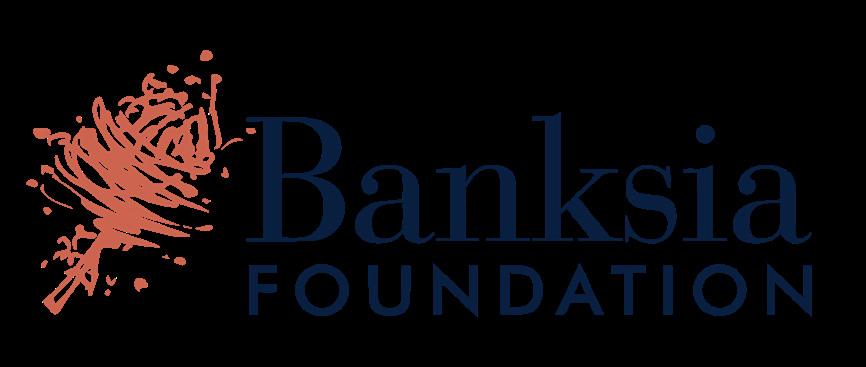
For all enquiries please contact:
Banksia Foundation
E: hello@banksiafdn.com
www.banksiafdn.com






















































































































































































































































